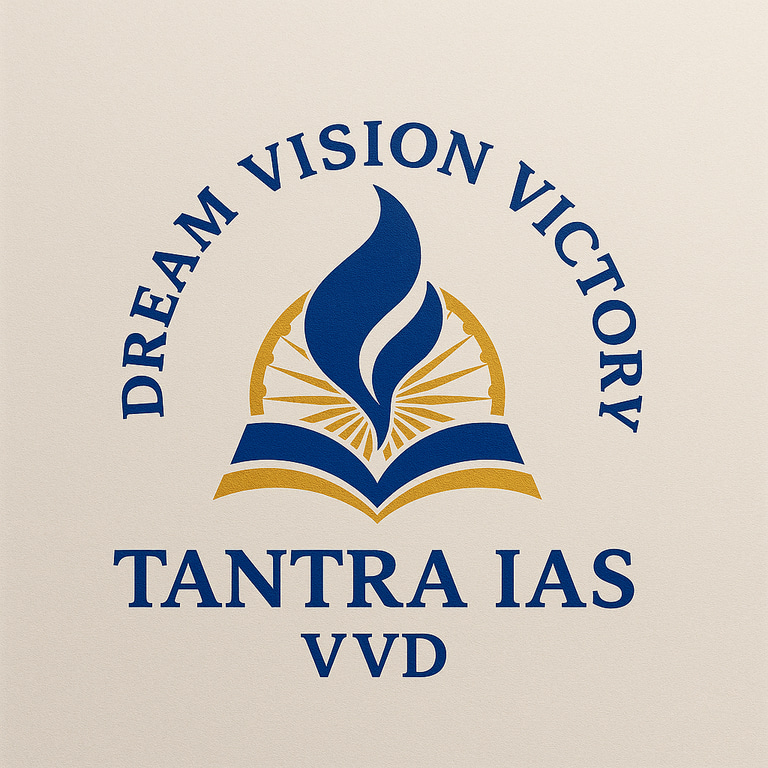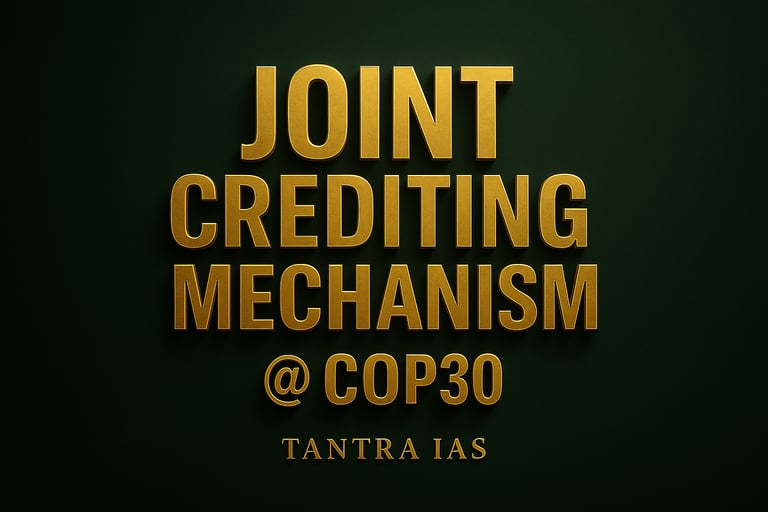

JOINT CREDITING MECHANISM @ COP30
1) Context / About:
India highlighted the Joint Crediting Mechanism (JCM) as a key global climate tool at COP30.
It aims to help countries jointly claim carbon-reduction outcomes from cooperative low-carbon projects.
India framed JCM as a fair, transparent way to support technology transfer + climate finance.
2) UPSC Syllabus Mapping:
Prelims: Carbon markets, Article 6 of Paris Agreement, carbon credits.
GS3: Climate change mitigation mechanisms; market-based instruments.
GS2: International environmental agreements.
3) Prelims — High-Yield One-Liners:
JCM is a bilateral/multilateral mechanism where two or more countries share carbon-reduction credits from a project.
It supports technology transfer, especially renewable & energy-efficient technologies.
Credits generated: verified emission reductions (VERs) that can be attributed to participating nations.
Part of the broader architecture of cooperative approaches under Article 6.
India pushes for JCM to ensure equity, access to clean tech, and fair distribution of climate benefits.
Helps developing countries attract investments without surrendering unilateral credit rights.
UPSC Prelims 2025 Pattern — MCQ :
Q. With reference to the Joint Crediting Mechanism (JCM), consider the following statements:
It allows more than one country to claim emission-reduction credits from the same climate project.
It is designed to support technology transfer for low-carbon development.
It operates outside the framework of the Paris Agreement and has no link to Article 6.
India has argued for using JCM to create fair and transparent carbon markets.
How many of the above statements are correct?
(a) Only one
(b) Only two
(c) Only three
(d) All four
✅ Answer: (c)
Correct → 1, 2, 4
Incorrect → 3 (JCM fits within Article 6’s cooperative approaches; not outside it.)
4) Mains Relevance (GS3):
Answer Structure:
Intro: JCM strengthens cooperative climate action by sharing credits from low-carbon projects.
Body:
Enhances access to clean technology.
Aligns with Article 6 cooperative mechanisms.
Helps developing countries mobilise finance without losing sovereignty over credits.
India pitching JCM → part of its larger push for fair, rules-based carbon markets.
Conclusion: JCM offers a practical bridge between climate ambition, equity, and technology diffusion.
Value Addition:
Article 6.2 → bilateral crediting; JCM fits here.
India’s stance: Carbon markets must avoid “double counting” + ensure sustainable development benefits.
JCM widens options beyond traditional CDM-type mechanisms.
Probable GS3 2026 Question:
Q. “Discuss how the Joint Crediting Mechanism strengthens the cooperative approaches under Article 6 of the Paris Agreement.”
5) Current Relevance:
COP30 debates centre around global carbon markets and transparency rules.
JCM is emerging as an alternative to fragmented voluntary carbon markets.
India positioning itself as a rule-shaper in global carbon governance.
6) Tantra IAS Takeaway
Climate action works best when credits are shared —
not when responsibilities are shifted.
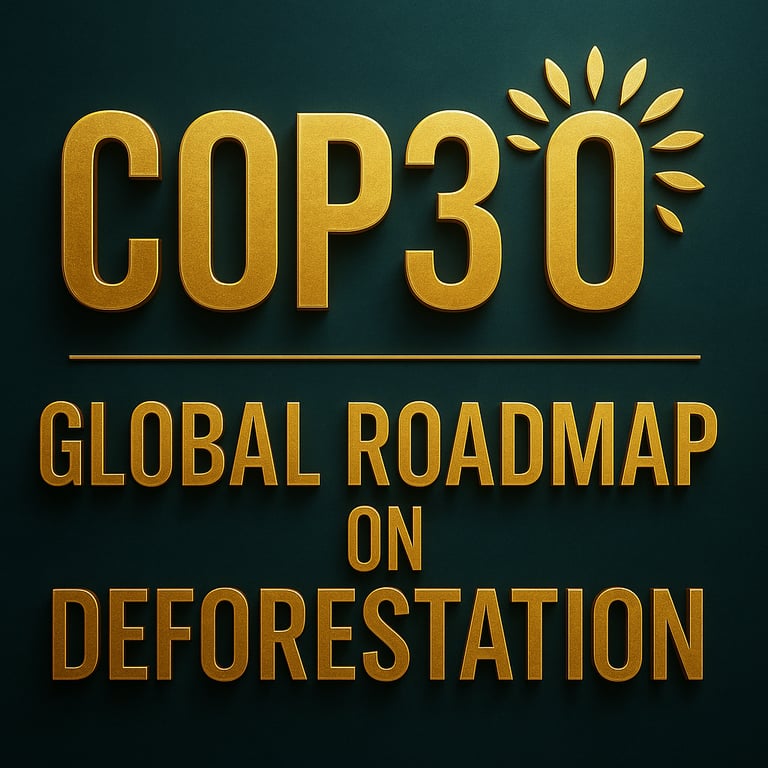

COP30 & GLOBAL ROADMAP ON DEFORESTATION
1) Context / About:
At COP30 (Brazil, 2025), WWF and Greenpeace have urged all nations to commit to a 2030 roadmap to halt and reverse deforestation.
Push aligns with the global target of limiting warming to 1.5°C.
Amazon’s rapid forest loss has amplified pressure for a binding global commitment.
2) UPSC Syllabus Mapping:
Prelims: Global environmental conventions; COP mechanisms; REDD+; forest terminology.
GS3: Conservation, climate change, environmental governance, NDCs.
3) Prelims — High-Yield One-Liners:
COP = Conference of Parties to UNFCCC (1992 Rio Convention).
COP30 host: Belém, Brazil (Amazon region).
Key forest mechanisms: REDD+, AFOLU, Land Degradation Neutrality, GBF (Kunming-Montreal).
India’s forest commitments tied to NDCs & 30–35% increase in carbon sink by 2030.
Deforestation impact: CO₂ emissions, rainfall disruption, biodiversity collapse.
UPSC Prelims 2025 Pattern — Sample MCQ:
Q. With reference to recent global climate action, consider the following statements:
The call to reverse global deforestation by 2030 was raised at COP30 held in the Amazon region of Brazil.
REDD+ under the UNFCCC provides incentives to developing countries for reducing emissions from deforestation.
India’s NDCs include a target to create an additional carbon sink through forest cover by 2030.
The COP platform has legal authority to penalise countries for failing to meet forest-related targets.
How many of the above statements are correct?
(a) Only one
(b) Only two
(c) Only three
(d) All four
✅ Answer: (c)
Correct → 1, 2, 3
Incorrect → 4 (COP has no penal powers; compliance is voluntary/political).
4) Mains Relevance (GS3):
Answer Structure
Intro: Global deforestation directly threatens climate stability & biodiversity.
Body:
COP30 push for 2030 reversal → aligns with Paris Agreement 1.5°C pathway.
Role of Amazon, Congo & SE Asia in global carbon balance.
India’s context: CAMPA, Green India Mission, agroforestry, LDN targets.
Conclusion: A global roadmap is feasible only with finance, MRV standards & equity.
Value Addition
Forest loss accounts for ~10–15% of global GHG emissions.
Kunming–Montreal GBF: halt biodiversity loss by 2030.
Probable GS3 Mains 2026 Question:
Q. “Discuss why reversing global deforestation by 2030 is central to achieving the 1.5°C goal. Examine India’s role and constraints.”
5) Current Relevance:
Intensifying Amazon loss.
Push for global forest finance.
Rising climate litigation & accountability demands.
6) Tantra IAS Takeaway:
Climate diplomacy isn’t about promises.
It’s about whether forests stand tall in 2030 — or only our regrets do.
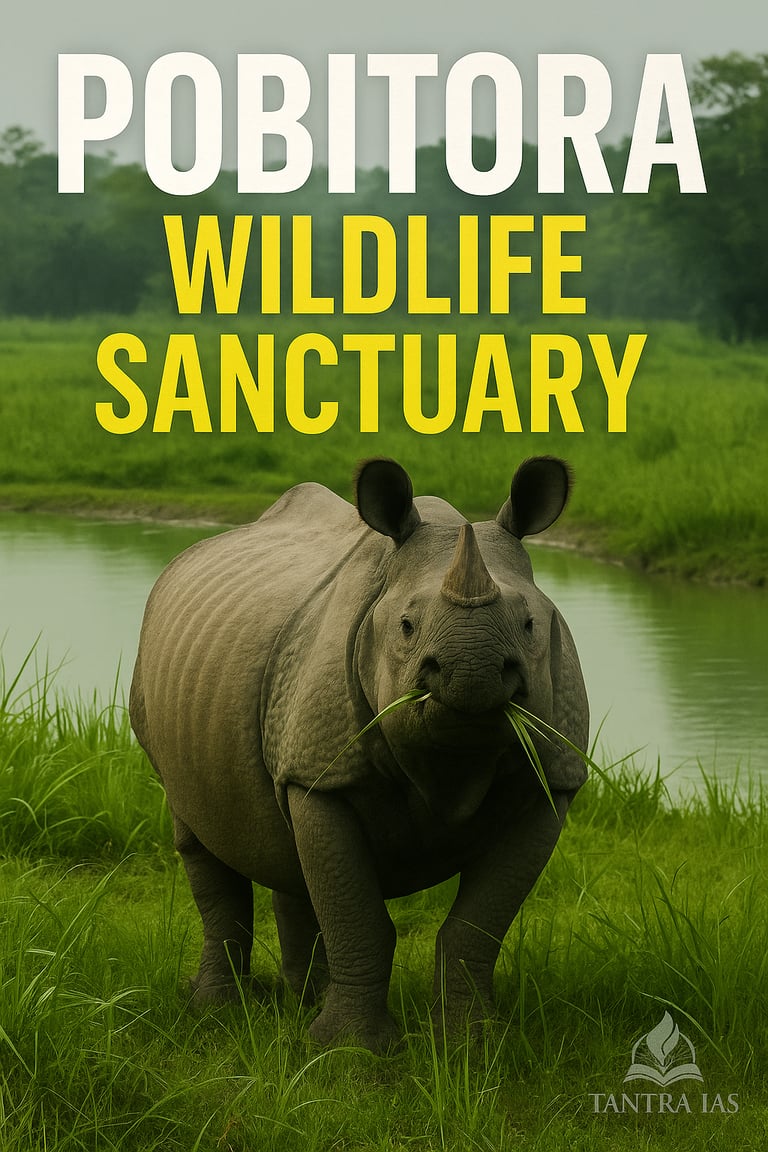

POBITORA WILDLIFE SANCTUARY
1) Context / About
Pobitora Wildlife Sanctuary (Assam) witnessing a surge in migratory birds this winter.
Thousands of species flock to its wetlands, grasslands, and riverbanks.
Sanctuary famous for highest density of One-Horned Rhinoceros globally.
2) UPSC Syllabus Mapping
Prelims: Environment & Ecology – Protected Areas, Wetlands, Biodiversity.
GS1: Geography – wildlife distribution, wetlands.
GS3: Conservation, habitat protection, human–wildlife interface.
3) Prelims — High-Yield One-Liners
Location: Morigaon district, Assam.
Category: Wildlife Sanctuary (not a National Park).
Known for: Highest density of Indian One-Horned Rhino.
Ecosystem: Brahmaputra floodplain grasslands + marshy wetlands.
Part of: East Asian–Australasian Flyway (major migratory corridor).
Species sighted: Storks, teals, pintails, gadwalls, bar-headed geese, etc.
Vulnerability: High flood-prone zone; habitat shrinkage; encroachment.
Prelims 2025 Pattern MCQ
Q. With reference to Pobitora Wildlife Sanctuary, consider the following statements:
It is known for having the highest density of Indian One-Horned Rhinoceros in the world.
It lies entirely within the Kaziranga–Orang Landscape.
It is a major wintering site for migratory birds under the East Asian–Australasian Flyway.
It is a Ramsar site notified under the Wetlands (Conservation and Management) Rules, 2017.
How many of the above statements are correct?
(a) Only one
(b) Only two
(c) Only three
(d) All four
✅ Answer: (b)
Correct: 1 and 3
Incorrect:
2 → Not entirely part of Kaziranga–Orang Landscape.
4 → Pobitora is NOT a Ramsar site.
4) Mains Relevance (GS1 + GS3):
Answer Structure
Intro: Assam’s floodplain sanctuaries are biodiversity hotspots.
Body:
Pobitora = micro-model of Rhino conservation success.
Critical wetland habitat supporting seasonal migratory birds.
Human settlement pressure → habitat fragmentation + conflict.
Integration with Kaziranga landscape needed for long-term sustainability.
Conclusion: Conservation must balance species protection + local livelihoods.
Value Addition / Pointers:
India hosts >10 million migratory birds each winter.
Rhino population in Pobitora ~>100 within only 38 sq km → highest density.
Assam floodplain wetlands shrinking due to excessive siltation.
Probable GS1/GS3 Mains 2026 Question:
Q. “Floodplain-based sanctuaries like Pobitora are critical for India’s wetland biodiversity. Examine the conservation challenges and landscape-level interventions required.”
5) Current Relevance (2024–25)
Winter migration peak across Northeast.
Assam’s rhino-bearing areas under continuous monitoring.
Wetland conservation central to India’s COP commitments.
6) Tantra IAS Takeaway
Pobitora shows a simple truth:
When wetlands survive, birds return… and biodiversity breathes again.
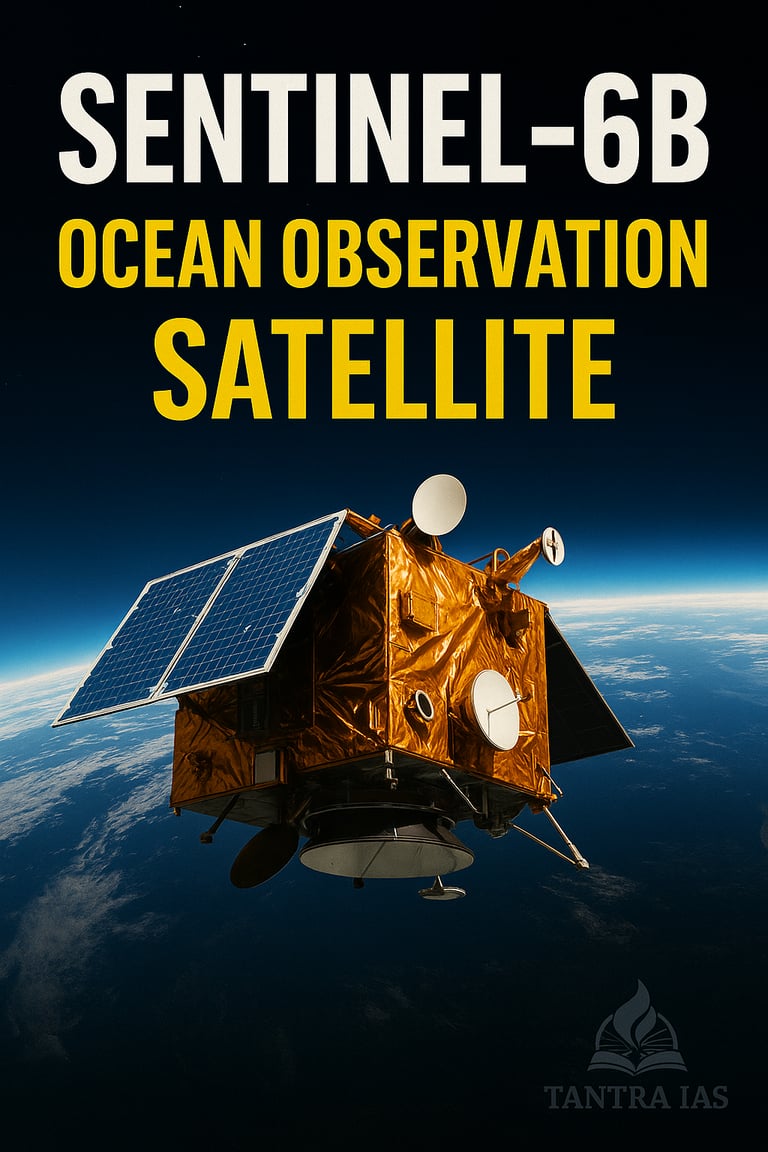

SENTINEL-6B (Ocean Observation Satellite)
1) Context / About:
Sentinel-6B launched from the Vandenberg Space Force Base (USA) for ocean monitoring.
An ocean-tracking satellite measuring sea level rise, temperature, and climate indicators.
Completes one Earth orbit in ~112 minutes; speed 7.2 km/s.
Forms part of the US–EU ocean monitoring mission (NASA + NOAA + ESA).
2) UPSC Syllabus Mapping:
Prelims: Space technology, Earth observation satellites, NASA/NOAA/ESA missions.
GS1: Geography – oceans, climate change, sea-level rise.
GS3: Disaster management, climate resilience, early warning systems.
3) Prelims — High-Yield One-Liners:
Mission type: Ocean altimetry + climate monitoring.
Key function: Measures sea-level rise with millimetre-level precision.
Coverage: Provides data for ~90% of global oceans.
Paired satellite: Works with Sentinel-6 Michael Freilich (launched 2020).
Agencies: Joint mission of NASA, NOAA, ESA, EUMETSAT.
Use cases: Weather forecasting, storm modelling, flood prediction, navigation, and coastal infrastructure planning.
UPSC Prelims 2025 Pattern MCQ:
Q. With reference to Sentinel-6B, consider the following statements:
It measures sea-level rise with millimetre-level accuracy.
It is jointly operated by NASA, NOAA, ESA, and EUMETSAT.
It covers less than 50% of global ocean surface.
It completes one revolution around Earth in less than two hours.
How many of the above statements are correct?
(a) Only one
(b) Only two
(c) Only three
(d) All four
✅ Answer: (c)
Correct: 1, 2, 4
Incorrect: 3 — It covers ~90% of global oceans.
4) Mains Relevance (GS1 + GS3):
Answer Structure:
Intro: Advanced ocean-monitoring satellites strengthen global climate governance.
Body:
Vital for tracking sea-level rise, marine heatwaves, and climate variability.
Enhances early warning for cyclones, storm surges, coastal hazards.
Supports blue economy and maritime security.
Conclusion: Space-based ocean monitoring = backbone of climate resilience.
Value-Adds:
IPCC: Sea-level rise accelerating due to thermal expansion + ice melt.
40% of world population lives in coastal zones → high vulnerability.
India’s CMEMS, INCOIS tools benefit from such global datasets.
Probable GS1/GS3 (2026) Question:
Q. “Discuss the role of modern ocean altimetry satellites in enhancing global climate resilience and coastal disaster preparedness.”
5) Current Relevance (2024–25):
Sea levels rising faster than previous IPCC projections — affects countries like Bangladesh, Maldives, India’s eastern coast.
Sentinel-6B strengthens planetary ocean-climate data ahead of COP-30 (Belém).
6) Tantra IAS Takeaway:
The next big climate battle will be fought on the coastlines.
Satellites like Sentinel-6B are not just machines —
they are our early alarms against a warming ocean.

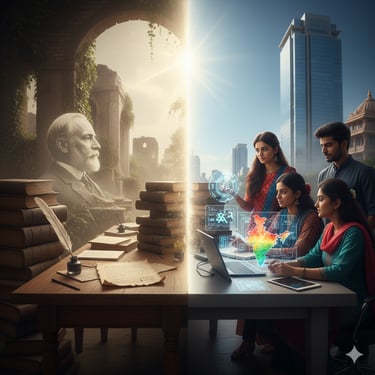
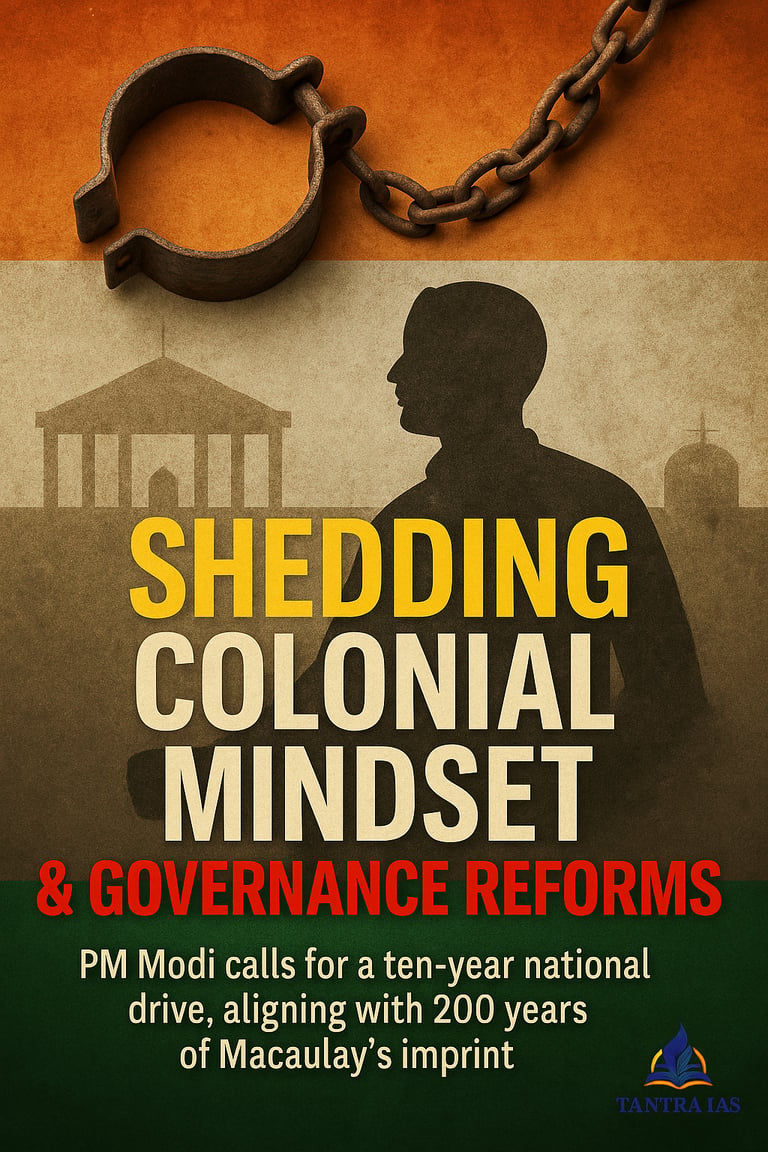

"SHEDDING COLONIAL MINDSET" & GOVERNANCE REFORMS
1) Context / About:
In the Ramnath Goenka Lecture, the PM called for a 10-year national effort to shed “colonial mindset”, coinciding with the 200-year legacy of Macaulay’s administrative imprint on India.
Emphasis: modern institutions, citizen-centric governance, media responsibility, and dismantling outdated colonial-era practices.
2) UPSC Syllabus Mapping:
GS2: Governance, reforms in administration, role of civil services, transparency.
GS1: Post-independence consolidation; colonial legacy in institutions.
GS4: Ethical governance, public trust.
3) Prelims — High-Yield One-Liners:
Colonial Legal Legacy: IPC (1860), CrPC (1898), Evidence Act (1872) — recently replaced with BNS, BNSS, and Bharatiya Sakshya Adhiniyam (2023).
Colonial Administrative Traditions: rigid hierarchy, secrecy, excessive paperwork, police structure under 1861 Act.
Macaulay: key architect of English education + Indian Penal Code.
Recent Moves:
Digitisation of services, RTI strengthening, citizen charters.
Abolition of interviews for lower-level recruitment.
Mission Karmayogi → civil services capacity-building.
UPSC 2025 Pattern MCQ:
Q. With reference to ongoing administrative reforms in India, consider the following statements:
The Bharatiya Nyaya Sanhita replaces the colonial-era Indian Penal Code.
Mission Karmayogi aims at competency-based training for civil servants.
The Police Act of 1861 has been fully replaced across all States.
Abolition of interviews for certain posts is part of the attempt to reduce colonial administrative hierarchy.
How many of the above statements are correct?
(a) Only one
(b) Only two
(c) Only three
(d) All four
✅ Answer: (c)
Correct: 1, 2, 4
Incorrect: 3 — the 1861 Police Act still remains in force in many States; not fully replaced.
4) Mains Relevance (GS2):
Answer Structure —
Intro: Shedding colonial mindset implies shifting from rule-centric to citizen-centric governance.
Colonial Hangovers: hierarchy, suspicion-based administration, slow procedures, police excesses, obsolete laws.
Reform Direction: modern legal codes, digital governance, service delivery, administrative accountability, scientific capacity-building.
Media Role: journalism as a bridge between state and society; promotes transparency.
Conclusion: A long-term reform arc rooted in constitutional values rather than colonial templates.
Value-Adds:
ARC Reports (2nd ARC: “Ethics in Governance”, “Public Order”, “Citizen-Centric Administration”).
Supreme Court Prakash Singh Case (2006) → police reforms.
UPSC linkage: “Transforming colonial administration into a democratic service institution.”
Probable GS2 (2026) Question:
Q. “What does ‘colonial mindset’ signify in the context of Indian administration? Examine recent reforms aimed at overcoming it.”
5) Current Relevance (2024–25):
New criminal law codes operationalised.
Push for procedural simplification, repeal of obsolete laws.
National debate on institutional redesign — judiciary, media, civil services.
6) Tantra IAS Takeaway:
A nation outgrows its past only when its institutions outgrow the habits that past inserted into them.
Reform is not a moment — it’s a mindset.
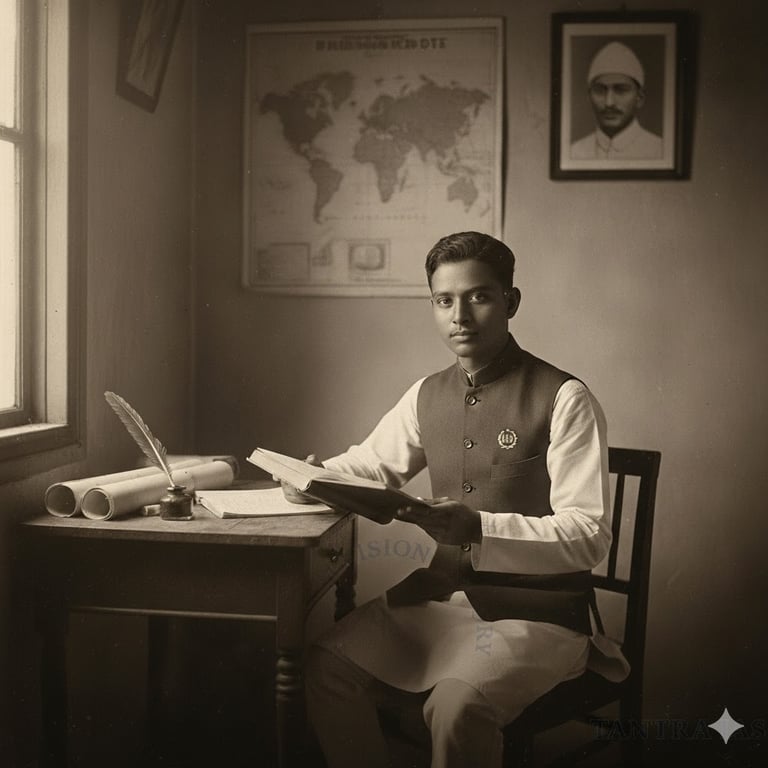

BATUKESHWAR DUTT
1) Context / About:
Remembering Batukeshwar Dutt (18 November 1910 – 20 July 1965), a revolutionary associated with the Hindustan Socialist Republican Association (HSRA).
Co-conspirator with Bhagat Singh in the Central Legislative Assembly bombing (1929).
Symbol of youthful defiance against colonial repression.
2) UPSC Syllabus Mapping:
GS1: Freedom struggle, revolutionary movements.
Prelims: HSRA, Lahore Conspiracy Case, revolutionary tactics.
3) Prelims — High-Yield One-Liners:
Member of HSRA (Hindustan Socialist Republican Association).
Along with Bhagat Singh, threw non-lethal bombs in the Central Legislative Assembly (8 April 1929) to protest repressive Bills.
Intended “to make the deaf hear,” not to kill.
Sentenced to transportation for life in the Lahore Conspiracy Case.
Imprisoned in Cellular Jail, Andamans; undertook hunger strikes for prisoner rights.
After independence, lived in relative neglect despite his contribution.
UPSC 2025 Pattern MCQ:
Q. With reference to Batukeshwar Dutt and the revolutionary movement in India, consider the following statements:
He was associated with the Hindustan Socialist Republican Association.
He and Bhagat Singh used non-lethal bombs in the Central Legislative Assembly to protest colonial Bills.
He was sentenced to death in the Lahore Conspiracy Case.
He participated in hunger strikes for the rights of political prisoners.
How many of the above statements are correct?
(a) Only one
(b) Only two
(c) Only three
(d) All four
✅ Answer: (c)
Correct: 1, 2, 4
Incorrect: 3 — Dutt received life imprisonment, not death.
4) Mains Relevance (GS1):
Answer Structure —
Intro: Dutt represents the revolutionary stream of the freedom struggle that challenged colonial authority through symbolic resistance.
Role: Assembly bombing as protest tactic; commitment to non-lethal, ideological messaging.
Struggle: Harsh imprisonment; hunger strikes for dignified treatment of political prisoners.
Legacy: Overshadowed by contemporaries yet central to the HSRA’s political awakening campaign.
Value-Adds:
Quote: “The aim was not to kill but to awaken.”
Link to Bhagat Singh’s trial & ideology.
Use in answers to show diversity of freedom struggle beyond Congress-led movements.
Probable GS1 (2026) Question:
Q. “Revolutionary movements played a crucial symbolic role in shaping nationalist consciousness. Discuss with reference to HSRA.”
5) Current Relevance (2024–25):
Renewed public attention on unsung revolutionaries.
Modern debates about recognition, state support, and historical memory.
6) Tantra IAS Takeaway:
Some fought with speeches, some with silence —
Batukeshwar Dutt fought with courage that expected nothing in return.
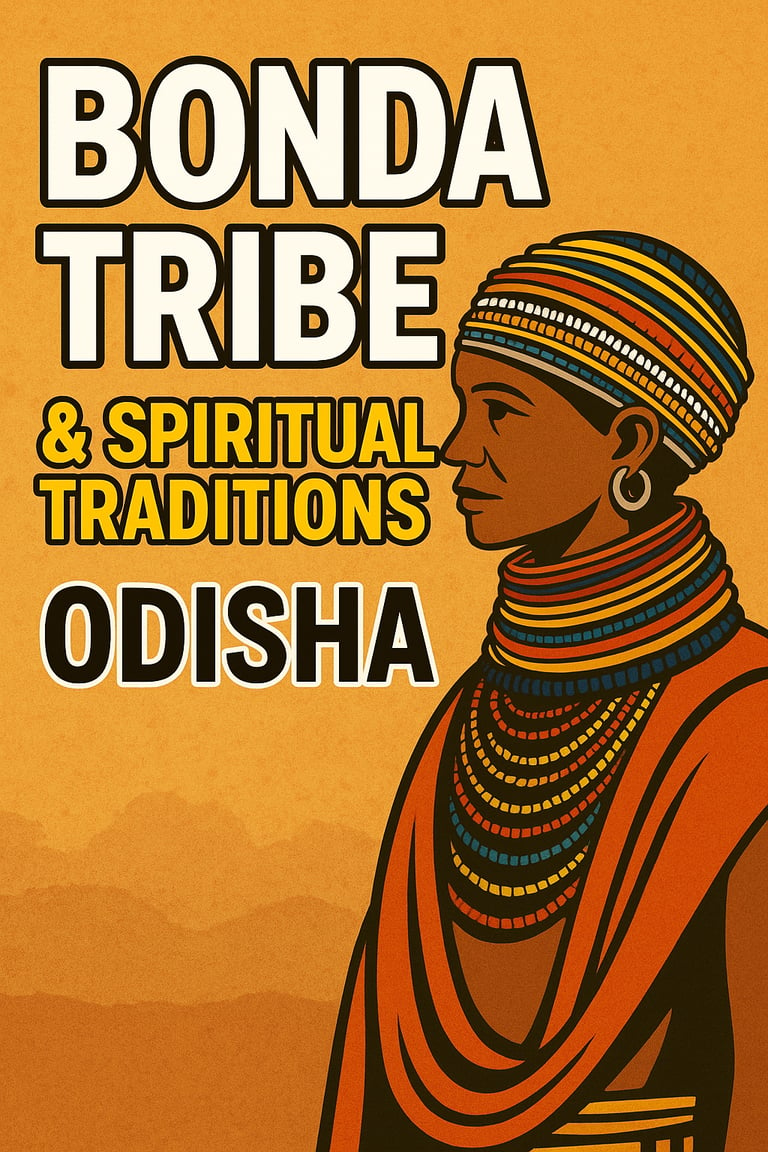

BONDA TRIBE (ODISHA)
1) Context / About:
Bonda tribe, one of India’s most isolated and culturally distinct tribal groups.
Known for ornamental neck rings, bead jewellery, shaved heads, and unique attire.
The Bonda people inhabit the hills of Malkangiri district, Odisha.
2) UPSC Syllabus Mapping:
GS1: Indian tribal communities, their culture & lifestyle.
Prelims: Particularly Vulnerable Tribal Groups (PVTGs), tribal geography, traditional attire.
3) Prelims — High-Yield One-Liners:
Status: Bonda = PVTG under the Ministry of Tribal Affairs.
Location: Bonda Hills, Malkangiri, Odisha (Eastern Ghats).
Language: Remo (Austroasiatic/Munda family).
Distinctive Features:
Women wear heavy aluminium neck rings, bead necklaces, and waist-wrapping cloths.
Matriarchal elements; women traditionally control trade and household decisions.
Economy: shifting cultivation, forest produce, small-scale pastoralism.
Religion: animistic beliefs; worship of nature spirits and ancestors.
Challenges: high vulnerability, low literacy, geographical isolation.
UPSC 2025 Pattern MCQ:
Q. With reference to the Bonda tribe of India, consider the following statements:
The Bonda tribe is classified as a Particularly Vulnerable Tribal Group (PVTG).
They inhabit the hilly regions of the Eastern Ghats in Odisha.
Their language belongs to the Austroasiatic (Munda) family.
The community practices settled plough-based agriculture as its primary livelihood.
How many of the above statements are correct?
(a) Only one
(b) Only two
(c) Only three
(d) All four
✅ Answer: (c)
Correct: 1, 2, 3
Incorrect: 4 — the Bonda rely on shifting cultivation & forest-based subsistence, not settled plough agriculture.
4) Mains Relevance (GS1):
Answer Structure:
Intro: The Bonda represent one of India’s oldest tribal populations with distinct cultural continuity.
Cultural Traits: attire, jewellery, matriarchal elements, traditional economic systems.
Social Structure: clan-based community, strong ties to nature and ancestral rituals.
Issues: underdevelopment, limited access to services, health vulnerabilities.
Government Interventions: Odisha’s Bonda Development Agency (BDA) + PVTG Development Plan.
Value-Adds
Mention: PVTG list (75 groups); Bonda among the most isolated.
Note: Mission Jeevan Jyoti & targeted tribal health initiatives.
Probable GS1 (2026) Question:
Q. “Discuss the socio-cultural characteristics and developmental challenges of the PVTGs of India with examples.”
5) Current Relevance (2024–25):
Ongoing government focus on PVTG Mission announced in Budget 2023–24.
Rising interest in documenting indigenous knowledge systems.
Concerns about cultural erosion due to external contact.
6) Tantra IAS Takeaway:
The Bonda identity isn’t just attire —
it’s a reminder of the fragile cultural worlds that survive on the margins of modernity.


EXPLOSIVE MATERIALS: AMMONIUM NITRATE & TATP
1) Context / About:
Forensic analysis confirmed that the explosive used in a recent incident was a mixture of Ammonium Nitrate and TATP (Triacetone Triperoxide).
Points to growing concerns over homemade explosive compounds (HMEs) and gaps in chemical precursor regulation in India.
2) UPSC Syllabus Mapping:
GS3: Internal Security — linkages between organised crime and terrorism.
Prelims: Explosives, chemical regulation, NDMA Act, and regulatory frameworks.
3) Prelims — High-Yield One-Liners:
Ammonium Nitrate (NH₄NO₃): commonly used in fertilizers and mining explosives; a strong oxidizer, not an explosive by itself.
TATP (Triacetone Triperoxide): highly unstable organic peroxide; used in terror attacks (e.g., 2015 Paris attacks).
Regulation:
Ammonium Nitrate regulated under the Explosives Act, 1884 and Ammonium Nitrate Rules, 2012.
Possession >100 kg requires licence from Chief Controller of Explosives (PESO).
India’s Security Mechanisms:
National Security Guard (NSG) bomb data centre monitors explosive-related threats.
NIA investigates use of banned or unlicensed explosives.
International Angle:
UN Security Council Resolution 1540 mandates control of WMD-related materials.
TATP is not industrially produced—illicit synthesis indicates high terror intent.
UPSC 2025 Pattern MCQ:
Q. With reference to explosive materials and their regulation in India, consider the following statements:
Ammonium Nitrate is classified as an explosive under the Explosives Act, 1884.
The manufacture and sale of TATP are permitted under licence by the Petroleum and Explosives Safety Organisation (PESO).
The possession of more than 100 kg of Ammonium Nitrate without a licence is prohibited.
India is a signatory to international norms requiring the control of chemical precursors of explosives.
How many of the above statements are correct?
(a) Only one
(b) Only two
(c) Only three
(d) All four
✅ Answer: (c)
Correct: 1, 3, 4
Incorrect: 2 — TATP is completely banned, not licensed.
4) Mains Relevance (GS3):
Answer Structure:
Intro: Rise of improvised explosive devices (IEDs) using commercial chemicals is a growing internal security threat.
Causes: Easy access to precursors, weak enforcement, poor end-use monitoring.
Challenges: unregulated trade, porous borders, coordination gaps among enforcement agencies.
Way Forward:
Strengthen PESO tracking & digital registry for chemical sales.
Public-private monitoring of fertilizer-grade ammonium nitrate.
Enhanced forensic coordination (NIA–NSG–FSL).
International cooperation on precursor chemicals.
Value Adds:
Reference: Standing Committee on Home Affairs Report (2021) on chemical explosives.
Example: Beirut Blast 2020 — ammonium nitrate negligence.
Diagram Suggestion:
Flowchart: Chemical source → Procurement → Misuse → Forensic tracking → Regulatory response.
Probable GS3 (2026) Question:
Q. “Discuss the internal security implications of chemical precursors like ammonium nitrate and the measures required for their effective regulation in India.”
5) Current Relevance (2024–25):
Recent forensic investigations revealing TATP use in India for the first time.
Review of Explosives Rules 2008 and tracking protocols underway.
Highlighting need for comprehensive precursor surveillance policy.
6) Tantra IAS Takeaway:
Explosives don’t just detonate on ground —
they expose the cracks in governance.
Modern security begins with chemical accountability.


INDIA’S FORESTS & THE FUTURE
1) Context / About
India targets sustainable forest management + climate-resilient growth.
25% of global population depends on forests for livelihood; India mirrors this rural dependence.
Editorial argues forests are development assets, not just conservation spaces.
2) UPSC Syllabus Mapping
GS3: Environment & ecology, forest governance, climate action, biodiversity.
GS2: Cooperative federalism in environmental governance.
Prelims: CAMPA, Forest Act, Joint Forest Management, carbon sinks.
3) Prelims — High Yield Shots
Forest & Tree Cover (India): ~24.62% (ISFR 2021).
Target: 33% under National Forest Policy.
CAMPA: Compensatory Afforestation Fund — to restore forests lost to diversion.
NFP 1988: people-centric forest management, ecological security priority.
Green India Mission: enhance carbon sinks via afforestation.
Hotspots: Western Ghats & Eastern Himalayas.
India’s carbon sink obligations under NDCs.
Key model: Joint Forest Management (JFM).
UPSC 2025 Pattern MCQ
Q. With reference to India’s forest governance, consider the following statements:
The Compensatory Afforestation Fund is meant to facilitate afforestation when forest land is diverted for non-forest use.
The National Forest Policy, 1988 prioritises ecological stability over commercial timber extraction.
India’s forest and tree cover has already crossed the national target of 33%.
The Green India Mission aims to enhance carbon sinks through afforestation and ecosystem restoration.
How many of the above statements are correct?
(a) Only one
(b) Only two
(c) Only three
(d) All four
✅ Answer: (c)
Correct: 1, 2, 4
Incorrect: 3 — forest/tree cover ~24.6%, below 33% target.
4) Mains Relevance (GS3)
Answer Structure:
Intro: Forests key to climate mitigation, water security, livelihoods.
Challenges: land diversion pressure, funding bottlenecks, CAMPA utilisation issues, plantations vs natural forests.
People: tribal rights & FRA compliance; JFM model needs strengthening.
Economy: forest-based enterprises, NTFPs, ecotourism.
Way forward: community-centric management, transparency in CAMPA, native species restoration, science-based land use planning.
Value Additions:
India’s NDC: 2.5–3 billion tonnes CO₂ sink by 2030.
FRA 2006: empowers forest dwellers.
UN Decade on Ecosystem Restoration relevance.
Probable GS3 (2026)
Q:“Critically analyse India’s strategy of combining afforestation, community rights, and climate commitments to enhance forest sustainability.”
5) Current Relevance (2024–25)
Need to accelerate CAMPA utilisation and quality plantation norms.
Focus on native species over monoculture.
Green economy + forest-based livelihoods gaining momentum.
Climate change impacts: forest fires, invasive species, rainfall shifts.
6) Tantra IAS Takeaway
Forests are not India’s past —
they’re its climate insurance, hydration system, and rural economy base.
We don’t protect forests for nostalgia.
We protect them for survival.
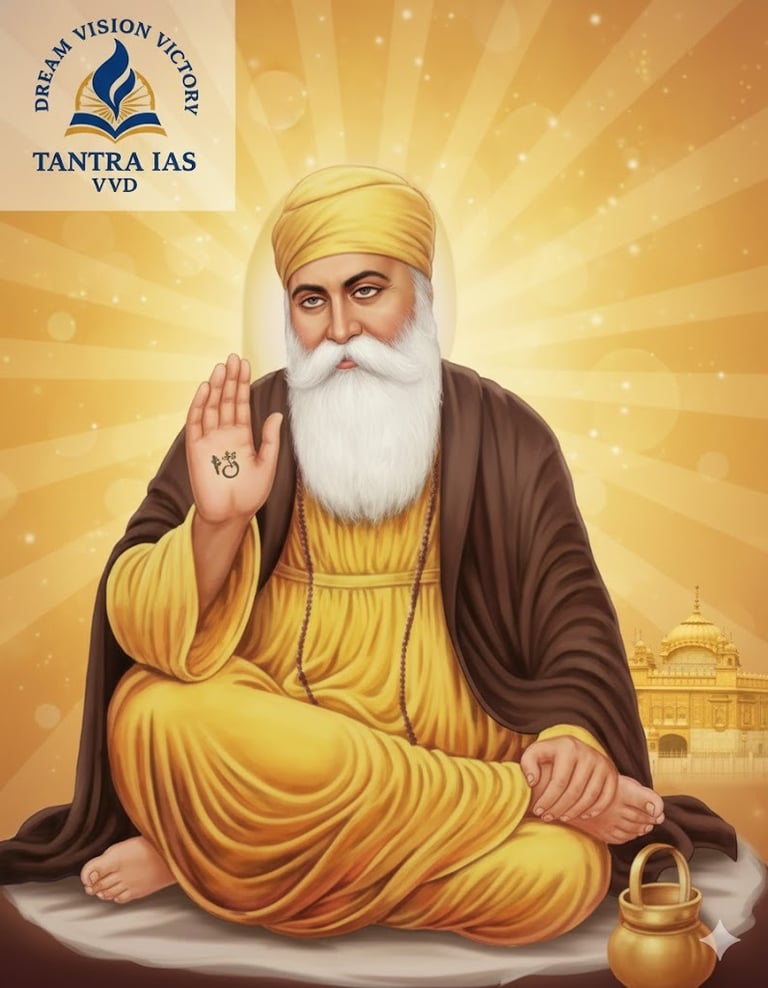

GURU NANAK JAYANTI
1) Context / About
Observed as Prakash Utsav / Guruparab marking the birth anniversary of Guru Nanak (1469–1539).
Guru Nanak’s spiritual message laid the foundation of the Sikh tradition, later institutionalised by successive Gurus.
Core themes: divine unity, equality, compassion, ethical life, service to humanity.
2) UPSC Syllabus Mapping:
GS1: Indian culture, Bhakti-Sufi movement, socio-religious reform.
Prelims: Sikh Gurus, sacred sites, doctrines, scriptures.
3) Prelims — High-Yield One-Liners:
Birthplace: Nankana Sahib (now in Pakistan).
Early travels (Udasis) → spread spiritual reform message.
Central doctrine: Ik Onkar (One Supreme Reality).
Teachings emphasised:
Naam Japna (meditation on the Divine)
Kirat Karna (honest labour)
Vand Chakna (share with others)
Rejects caste distinctions, empty rituals, and superstitions.
Sangat & Langar traditions emphasised equality & community service.
Teachings preserved in Guru Granth Sahib (compiled later by Guru Arjan).
UPSC 2025 Pattern MCQ:
Q. With reference to Guru Nanak’s teachings, consider the following statements:
He emphasised devotion to a single formless divine reality.
He discouraged caste distinctions and ritualism.
He advocated ritual fasting as a primary means to attain liberation.
His message stressed honest work and sharing one’s earnings for social good.
How many of the above statements are correct?
(a) Only one
(b) Only two
(c) Only three
(d) All four
✅ Answer: (c)
Correct: 1, 2, 4
Incorrect: 3 — he rejected ritualism in favour of ethical living.
4) Mains Relevance (GS1):
Answer Structure —
Intro: Guru Nanak’s teachings marked a transformative phase in India’s spiritual and social thought.
Ethical Code: equality, compassion, dignity of labour, women’s dignity.
Social Impact: challenged caste hierarchy & religious orthodoxy.
Legacy: spiritual movement later formalised by successive Gurus; culminated in Khalsa formation (1699) and Guru Granth Sahib as eternal Guru.
Value-Add:
Concept: Sarbat da Bhala — welfare of all.
Line often quoted in UPSC: “There is no Hindu, there is no Muslim.”
Probable GS1 (2026) Question:
Q. “Bhakti and Sufi saints shaped both spiritual thought and social ethics in medieval India. Examine.”
5) Current Relevance (2024-25)
Kartarpur Corridor and faith diplomacy.
Langar as global humanitarian model.
Values of equality, fraternity, community service resonate in modern social justice discourse.
6) Tantra IAS Takeaway:
He didn’t organise a religion —
He awakened a conscience that later shaped one.
Spiritual reform is strongest when lived, not imposed.
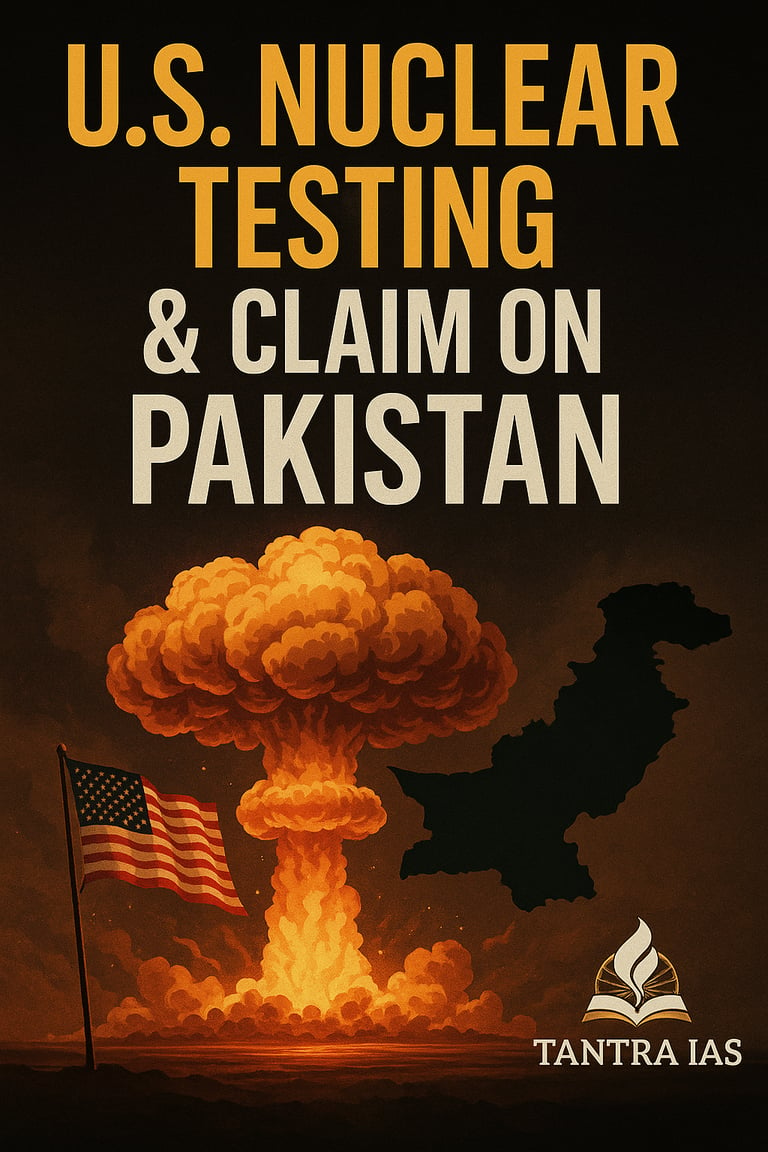

US NUCLEAR TESTING & CLAIM ON PAKISTAN!
1) Context / About
US President announced decision to resume nuclear testing after over three decades.
Public justification included claim that Pakistan, Russia, China, and North Korea are already testing.
Marks a major break from long-standing moratorium policy since 1992.
Raises global concerns on arms race & treaty erosion.
2) UPSC Syllabus Mapping
GS2: International relations — nuclear non-proliferation architecture.
GS3: Security challenges, deterrence, strategic stability.
Prelims: CTBT, NPT basics, global disarmament frameworks.
3) Prelims — High Yield One-Liners
CTBT (1996) bans all nuclear explosions, but not in force yet.
India, Pakistan, North Korea are non-signatories to CTBT.
US signed CTBT, never ratified it.
Last publicly known US nuclear test: 1992.
Last publicly known Pakistan test: 1998 (Chagai).
Allegations of secret testing are unverified in open intelligence domain.
UPSC 2025 Pattern — MCQ
Q. With reference to nuclear testing and global treaties, consider the following statements:
The CTBT prohibits all nuclear test explosions in all environments.
Pakistan has publicly conducted nuclear tests after 2010.
The United States has not ratified the CTBT.
The CTBT has entered into force and is binding on all UN member states.
How many of the above statements are correct?
(a) Only one
(b) Only two
(c) Only three
(d) All four
✅ Answer: (b)
Correct: 1 & 3
Incorrect:
2 → No public test after 1998
4 → CTBT not yet in force
4) Mains Relevance (GS2/GS3): ANSWER WRITING GUIDE:
Intro: Global nuclear norms under stress; US shifting posture.
Drivers: strategic competition with China & Russia; deterrence signalling.
Risks: treaty dilution, testing cascade, arms race escalation.
Non-Proliferation Impact: undermines global disarmament consensus.
India Angle: nuclear restraint stance; South Asian stability concerns.
Value Adds
CTBT needs ratification by all Annex-II states → pending, therefore inactive.
NPT framework intact but credibility concerns rising.
India follows NFU + credible minimum deterrence doctrine.
Probable GS2/GS3 Q (2026)
Q. “Recent geopolitical developments signal renewed nuclear competition. Discuss implications for global arms-control regimes and India’s security calculus.”
5) Current Relevance (2024-25)
New strategic competition: US–China–Russia.
South Asia: heightened scrutiny on Pakistan & India posture.
UN disarmament mechanisms under renewed debate.
6) Tantra IAS Takeaway
When nuclear restraint weakens, diplomacy becomes the first casualty.
UPSC demands clarity on treaty law + power politics + India’s doctrine — not noise.

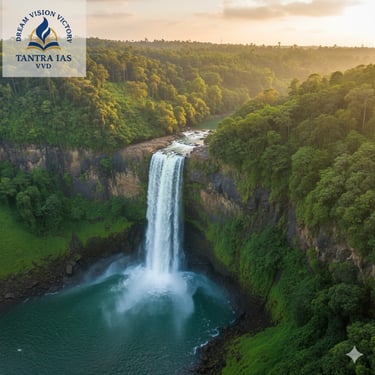
NOHKALIKAI FALLS (MEGHALAYA)
1) Context / About
Nohkalikai Falls, Meghalaya — among tallest plunge waterfalls in India.
Located near Cherrapunji (Sohra), East Khasi Hills.
Known for sheer drop, rainforest basin, seasonal flow, and tourism value.
2) UPSC Syllabus Mapping:
Prelims: Indian physical geography — waterfalls, rainfall regimes, physiography.
GS1: Landforms, North-East geography, climate regions, eco-tourism.
GS3: Environment & biodiversity of Himalayan region; sustainable tourism.
3) Prelims — High Yield One-Liners:
Height ~340 metres (approx).
Plunge waterfall type (vertical free-fall).
Formed by erosion on Khasi plateau edge — plateau escarpment.
Region = highest rainfall zone globally (Cherrapunji–Mawsynram belt).
Under tropical monsoon climate with orographic rainfall.
Falls feed into rainforest pool; seasonal intensity.
Vulnerability: landslides, deforestation, monsoon variability.
UPSC 2025 Pattern MCQ:
Q. With reference to Nohkalikai Falls, consider the following statements:
It is a plunge-type waterfall located on the edge of a plateau in the Khasi Hills.
The region receives some of the highest annual rainfall in the world due to orographic uplift.
Nohkalikai Falls flows throughout the year with uniform discharge during all seasons.
It is located near Cherrapunji in Meghalaya.
How many of the above statements are correct?
(a) Only one
(b) Only two
(c) Only three
(d) All four
✅ Answer: (c)
Correct: 1, 2, 4
Incorrect: 3 — seasonal variation; strongest during monsoon.
4) Mains Relevance (GS1/GS3):
Answer Structure :
Intro: High-rainfall plateau escarpment waterfall, NE physiography highlight.
Formation: uplifted plateau + steep river drop + monsoon regime.
Significance: tourism, ecology, watershed.
Challenges: landslides, climate shifts, tourism pressure.
Way forward: eco-tourism infrastructure, carrying capacity norms, slope stabilization.
Value Additions:
Cherrapunji & Mawsynram — world’s rainiest belt.
Karst features also seen in Meghalaya (limestone caves).
Mention Eastern Himalaya + NE biodiversity hotspot.
Probable GS1 (2026)
Q. “Explain how physiographic features and monsoon patterns shape the waterfalls and drainage characteristics of the North-East region.”
5) Current Relevance (2024–25)
Push for Northeast tourism, sustainable travel, Village Tourism Promotion.
Govt focus on eco-tourism + local community livelihoods.
Climate change affecting rainfall patterns in Meghalaya.
6) Tantra IAS Takeaway:
Geography isn’t just terrain —
it’s climate, people, ecology, and policy converging at one cliff edge.
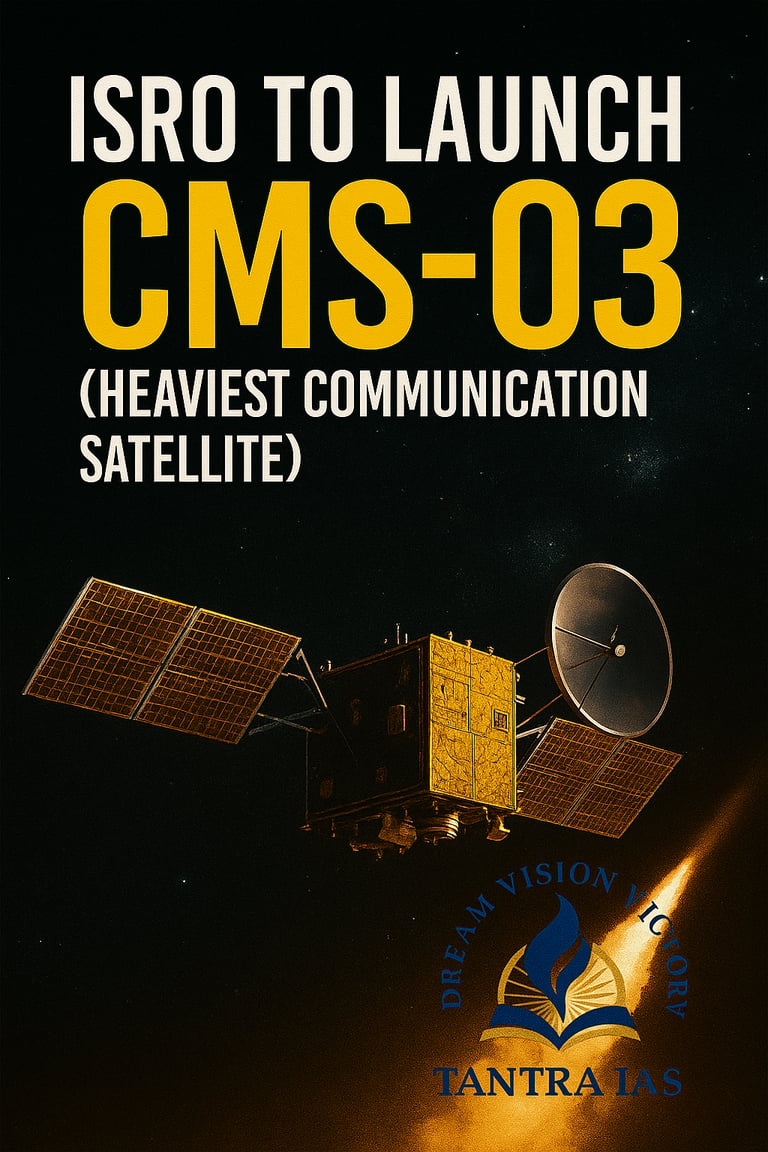

ISRO TO LAUNCH CMS-03 (HEAVIEST COMMUNICATION SATELLITE)
1) Context / About:
CMS-03 = India’s heaviest communication satellite (as per announcement).
Launched by ISRO to strengthen satellite-based telecom, broadband, and broadcasting.
Part of India’s expanding GEO communication capability.
Supports digital infrastructure + security communications.
2) UPSC Syllabus Mapping
GS3: Science & Tech — space technology, communication, digital infrastructure.
Prelims: ISRO missions, satellite categories (LEO/MEO/GEO), launch vehicles.
3) Prelims — High Yield Shots:
CMS series = Communication satellites (formerly GSAT series new naming).
GEO orbit (~36,000 km) → fixed over one spot → ideal for telecom & TV.
Launch vehicle: GSLV-Mk III / LVM3 class capable of heavy satellites (context dependent).
Continuous broadband + secure comm support → Digital India backbone.
Users: civil + strategic + disaster response.
India’s comsat capacity = mix of indigenous + leased transponders earlier, now localisation push.
UPSC 2025 Pattern MCQ:
Q. With reference to India’s satellite communication programme, consider the following statements:
CMS-03 is a geostationary satellite intended to enhance broadband and communication services.
The CMS series was launched to replace the earlier GSAT naming system for communication satellites.
GEO satellites typically provide fixed coverage over a region by orbiting at approximately 36,000 km altitude.
LVM3 is capable of launching heavy communication satellites into geostationary orbit.
How many of the above statements are correct?
(a) Only one
(b) Only two
(c) Only three
(d) All four
✅ Answer: (d) All four
(Correct: 1, 2, 3, 4)
4) Mains Relevance (GS-3):
Answer Structure — One-liners
Intro: India expanding high-capacity space communication infrastructure.
Need: Digital public infrastructure, secure communication, remote connectivity, disaster links.
Significance: Telecom expansion, digital inclusion, defence comm resilience.
Strategic angle: Reduces dependence on foreign leased transponders.
Way forward: private space participation, satellite internet (LEO+GEO mix), cost reduction.
Value-Additions:
India’s SpaceCom Policy 2023.
BharatNet + satellite backhaul for remote villages.
Collaboration potential with startup ecosystem under IN-SPACe guidelines.
Diagram Suggestion
Quick sketch: LEO vs GEO vs MEO satellites — height + use case.
Probable GS-3 (2026) Question
Q. “Examine the role of satellite communication capacity in advancing India’s digital public infrastructure agenda.”
5) Current Relevance (2024-25):
Boost to satellite-based broadband.
Complement to NavIC, GSAT, and LEO initiatives by private players.
Strengthens self-reliance in space-based communication assets.
6) Tantra IAS Takeaway:
Connectivity is sovereignty in a tech-driven century.
A nation online stays ahead.
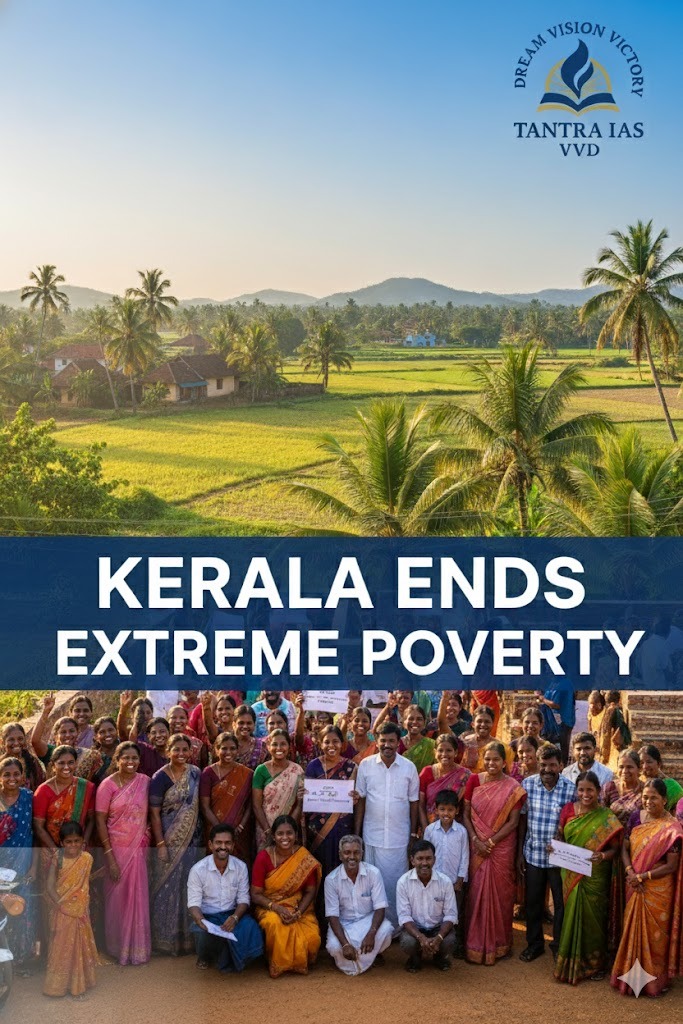

KERALA ENDS EXTREME POVERTY
1) Context / About:
Kerala declared zero extreme poverty (2025 announcement).
Driven by state welfare architecture + human development focus.
Linked to Extreme Poverty Eradication Project (EPEP).
Key strengths: health, education, decentralisation, women collectives (Kudumbashree).
2) UPSC Syllabus Mapping
GS1: Poverty & Development
GS2: Welfare schemes, federalism, decentralised governance
GS3: Inclusive growth, social sector, poverty alleviation
3) Prelims — High-Yield Bullets
Kerala poverty model: social democratic welfare + grassroots governance.
Kudumbashree = world’s largest women's cooperative network.
Aardram Mission → public health strengthening.
Public Distribution System coverage high; nutrition initiatives.
Kerala Infrastructure Investment Fund Board (KIIFB) → infra financing.
Panchayat-driven development since 73rd Constitutional Amendment implementation.
Education + health → HDI leadership in India.
UPSC 2025 Pattern MCQ:
Q. With reference to Kerala’s poverty eradication efforts, consider the following statements:
The Extreme Poverty Eradication Project in Kerala is implemented primarily through local self-governments.
Kudumbashree plays a major role in livelihood support and social mobilisation.
Kerala achieved zero extreme poverty solely through cash transfer schemes.
Kerala’s model emphasises universal public health and education services.
How many of the above statements are correct?
(a) Only one
(b) Only two
(c) Only three
(d) All four
✅ Answer: (c)
Correct: 1, 2, 4
(3) is wrong — model = multi-pillar (public services, decentralisation, community networks), not cash-only.
4) Mains Relevance (GS2/GS3)
Answer Structure (One-liners)
Intro: Kerala claims elimination of extreme poverty; welfare-driven development model.
Pillars: decentralisation; Kudumbashree; education-health access; social security; affordable food.
Strengths: human capital, gender inclusion, community institutions.
Constraints: fiscal stress, ageing society, unemployment challenges.
Way forward: expand productive jobs, skilling, private-sector growth, youth retention.
Value-Additions
Kerala HDI ~ top in India; literacy ~ highest.
UNDP case studies on human development governance.
73rd/74th Amendments → Kerala deep implementation.
Kudumbashree = ~50 lakh women network.
Diagram Suggestion
Small 5-box wheel: Education | Health | Kudumbashree | PDS/Nutrition | Decentralisation.
Probable GS2/GS3 Question (2026):
Q. “Kerala’s success in eliminating extreme poverty highlights the role of decentralisation and social development. Examine the model’s strengths and future challenges.”
5) Current Relevance (2024–25):
State claim → national debate on poverty metrics & methodology.
Global context: SDG-1 (No Poverty).
Push for people-centric welfare + community governance.
Discussion on jobs vs welfare balance.
6) Tantra IAS Takeaway
Poverty ends not by slogans but by systems — institutions, dignity, and steady income pathways.
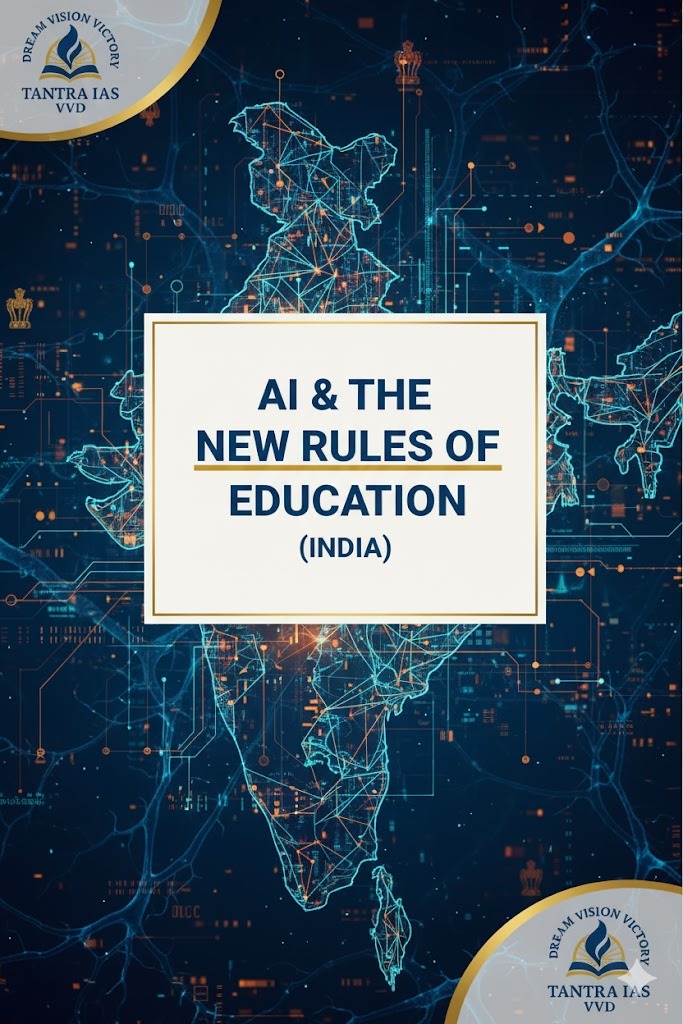

AI & THE NEW RULES OF EDUCATION
1) Context / About:
Govt. introducing AI Modules from Class 6 (NEP 2020 alignment).
Aim: prepare students for AI-driven economy & workforce.
Use cases: teacher support, adaptive learning, special-needs inclusion, language learning.
Key tension: innovation vs equity; tech rollout vs digital divide.
2) UPSC Syllabus Mapping:
GS2: Education policy, inclusion, governance, digital public goods.
GS3: Technology, AI ethics, innovation, employment, future-skills.
Prelims: NEP-2020 provisions, Digital India, DIKSHA, PM-SHRI, AI for All initiative.
3) Prelims — High Yield Bullets:
NEP 2020 → AI, coding, computational thinking integrated early.
PM-SHRI schools + DIKSHA + NDEAR for digital ecosystem.
AI For All initiative (NCERT + Intel).
AI for Accessibility → language & disability inclusion.
Concerns: access, affordability, algorithmic bias, teacher training.
Focus: human-in-loop, not AI replacing teachers.
Prelims MCQ (UPSC 2025 Pattern):
Q. With reference to the integration of Artificial Intelligence in India's school education ecosystem, consider the following statements:
The National Education Policy 2020 recommends early exposure to computational thinking and AI.
The DIKSHA platform and PM-SHRI schools are key instruments for nationwide AI-enabled learning.
India’s “AI For All” initiative is a government programme implemented solely by the Ministry of Education.
AI-based school interventions are expected to especially support multilingual and special-needs learners.
How many of the above statements are correct?
(a) Only one
(b) Only two
(c) Only three
(d) All four
✅ Answer: (c)
Correct: 1, 2, 4
Incorrect: 3 — “AI For All” = collaboration (Govt + Intel), not solely MoE.
4) Mains Relevance (GS2/GS3):
Answer Structure — One-liners
Intro: AI adoption in schools as per NEP vision for future skills.
Opportunities: personalisation, teacher support, inclusion, local-language learning, data insights.
Risks: digital divide, bias, privacy, over-automation, pedagogical mismatch.
Requirements: training teachers, infra, ethical guidelines, audits, public digital infrastructure.
Conclusion: AI must augment, not replace; equity first, innovation parallel.
Value-Additions:
NEP-2020: tech-integrated pedagogy.
UNESCO guidelines on AI in education.
NDEAR + DIKSHA = DPG (Digital Public Goods).
“Human-in-loop” principle for safe AI learning.
Diagram Suggestion:
Simple box: AI in Education = Access + Personalisation + Teacher-support + Safeguards.
Probable GS2/GS3 Q (2026)
“AI in education can democratize learning, but only if supported by inclusive digital ecosystems and teacher capacity building. Discuss.”
5) Current Relevance (2024–25):
NCERT AI curriculum rollout in phases across states.
Global debate: AI tutors vs human pedagogy.
Govt focus on EdTech regulation + digital public infra.
Increased attention on AI for regional languages.
6) Tantra IAS Takeaway:
Real reform isn’t AI replacing teachers — it’s AI freeing teachers to teach.
Tech is a tool; equity is the exam.
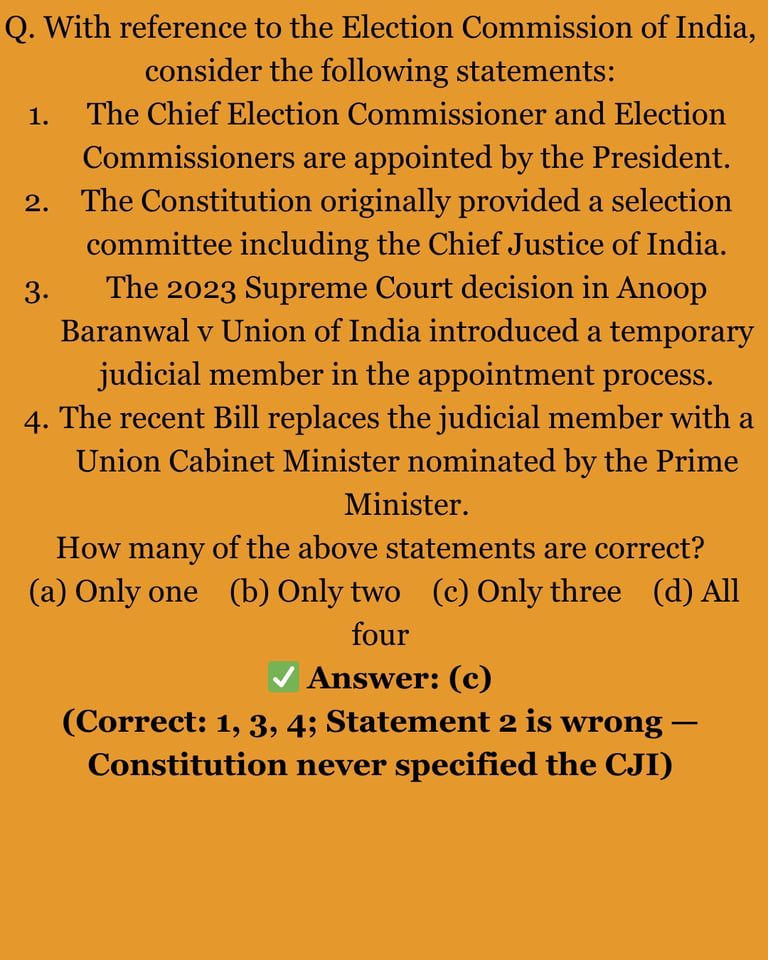

AMENDED EC APPOINTMENT BILL: CONCERNS & CONSTITUTIONAL ANGLE:
1) Context / About:
New Bill changes selection panel for CEC + ECs.
Replaces CJI in committee; adds Union Cabinet Minister alongside PM & Leader of Opposition.
Seen as expanding executive footprint in EC appointments.
Raises questions on independence of election authority.
2) UPSC Syllabus Mapping
GS2: Constitution — bodies, elections, separation of powers, judicial review
Prelims: Constitutional bodies (Art. 324), EC structure, appointment process
3) Prelims — High Yield Bullets:
Article 324: EC independence + superintendence of elections
1991 Act → service conditions/tenure of CEC/EC
T.N. Seshan vs Union (1995): EC = multi-member body
Anoop Baranwal v UoI (2023): CJI in selection till Parliament legislates
New Bill removes CJI → Cabinet Minister
EC = Constitutional authority, not a statutory one
Prelims 2025 MCQ
Q. With reference to the Election Commission of India, consider the following statements:
The Chief Election Commissioner and Election Commissioners are appointed by the President.
The Constitution originally provided a selection committee including the Chief Justice of India.
The 2023 Supreme Court decision in Anoop Baranwal v Union of India introduced a temporary judicial member in the appointment process.
The recent Bill replaces the judicial member with a Union Cabinet Minister nominated by the Prime Minister.
How many of the above statements are correct?
(a) Only one (b) Only two (c) Only three (d) All four
✅ Answer: (c)
(Correct: 1, 3, 4; Statement 2 is wrong — Constitution never specified the CJI)
4) Mains Relevance (GS-2):
Answer Structure (One-liners)
Intro: Constitutional autonomy of EC under Art. 324
Issue: Executive-heavy appointment panel
Concerns: Independence, checks & balances, level-playing field in elections
Judicial link: Anoop Baranwal — CJI inclusion to avoid executive monopoly
Way forward: Bipartisan committee, fixed tenure protection, transparent process
Value-Additions
Article 324; 1991 Act
SC: "Level playing field is basic feature of free elections"
ARC-II recommendation — bipartisan appointment mechanism
Diagram Suggestion: Small box chart:
Old panel (SC suggestion) → PM + CJI + LoP
New panel → PM + Cabinet Minister + LoP
Probable GS-2 (2026) Q. “Critically examine whether the new mechanism for appointing Election Commissioners strengthens or weakens constitutional independence of the Election Commission.”
5) Current Relevance (2024-25):
Part of ongoing institutional reform debates
Civil society & former CECs expressed concerns
Election years → direct governance + fairness implications
6) Tantra IAS Takeaway:
Institutions fall not in one moment but in slow shifts.
UPSC wants thinkers who recognise quiet constitutional changes, not just headline ones.
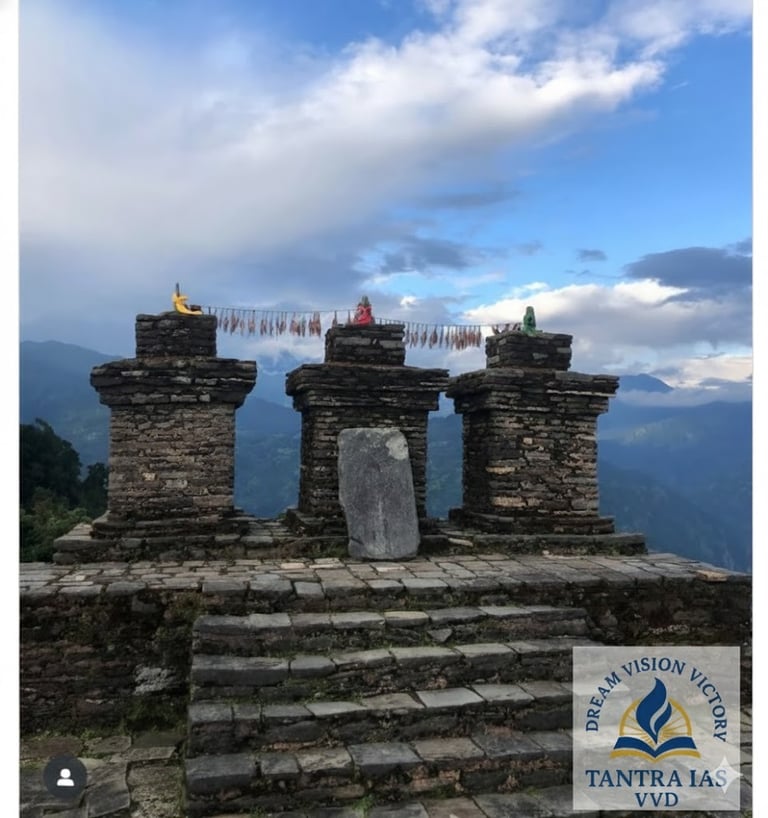

RABDENTSE RUINS, SIKKIM
1. Context / About
Capital: Second capital of Kingdom of Sikkim (1670–1814 CE).
Dynasty: Namgyal dynasty.
Location: Near Gyalshing, West Sikkim.
Significance: Seat of Sikkim’s monarchy before Gurkha invasion.
Site Features: Royal palace remains, throne platform (Namphogang), religious complex.
Cultural Note: Audience space where common people met the king.
2. UPSC Syllabus Mapping
Prelims: Indian Culture → historical sites, regional kingdoms, Himalayan heritage.
Mains (GS-1): Modern history & regional polities → Himalayan kingdoms & cultural heritage.
3. Prelims Relevance
Former capital of Sikkim before Gangtok.
Linked to Buddhist monarchy — Namgyal lineage.
Destroyed after Gurkha invasion (early 19th century).
Archaeological site under ASI.
Located near Pemayangtse Monastery (important Buddhist centre).
UPSC 2025 Pattern MCQ
Q. With reference to the Rabdentse Ruins, consider the following statements:
It served as the second capital of the Kingdom of Sikkim under the Namgyal dynasty.
The site includes a throne platform and a Buddhist monastic complex used by the royal family.
It was abandoned following the invasion of the Gurkhas in the 18th century CE.
Rabdentse is located near Gyalshing in West Sikkim.
How many of the above statements are correct?
(a) Only one
(b) Only two
(c) Only three
(d) All four
✅ Answer: (c)
Correct: 1, 2, 4
Incorrect: 3 — Abandoned after Gurkha invasion in early 19th century (1814), not 18th.
Sources: ASI Sikkim site record; Sikkim Govt. cultural portal.
4. Mains Relevance (GS-1)
Answer Structure (One-Liners)
Intro: Capital site of Namgyal dynasty; key to Sikkim’s monarchical past.
Body:
– Political centre before Gangtok rise.
– Buddhist-monarchical fusion; spiritual-royal architecture.
– Symbol of Himalayan statecraft and religious legitimacy.Conclusion: Reflects continuity of Buddhist monarchy in Eastern Himalayas.
Value Additions
Connect to Pemayangtse Monastery and Chogyal rulers.
Shows Himalayan political culture beyond mainstream Delhi-centric history.
Link to Buddhist governance traditions and monastic patronage.
Diagram Suggestion
Simple India map marking West Sikkim — Rabdentse & Pemayangtse Monastery.
5. Current Relevance (2024–25)
Highlighted by Ministry of Culture’s Bharat Heritage series.
Part of Northeast heritage tourism circuits.
Conservation under ASI + Sikkim tourism push for historic Buddhist routes.
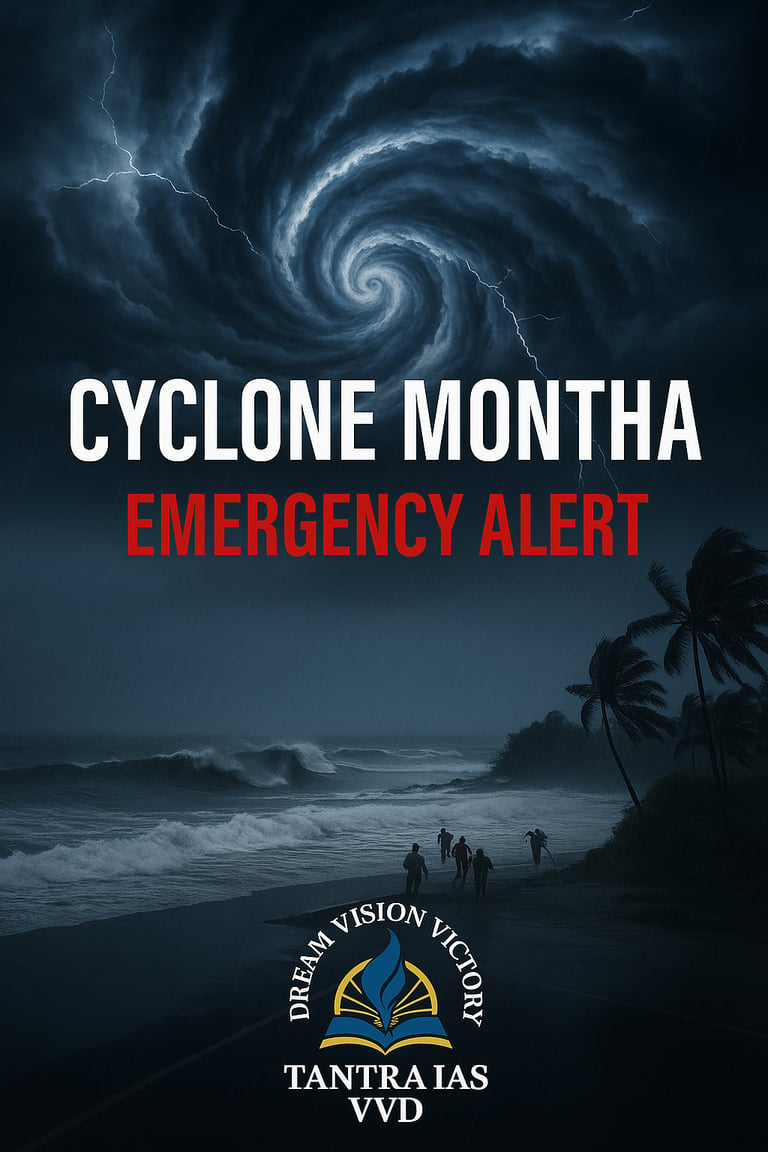

Cyclone Montha: The Storm and the Lesson
In the News
Cyclone Montha, classified as a very severe cyclonic storm, has formed over the east-central Bay of Bengal and is moving towards the eastern coast. The India Meteorological Department (IMD) has issued red alerts for Odisha and West Bengal. Evacuation drives and disaster response teams have been deployed as wind speeds cross 120 km/h.
Syllabus Mapping
Prelims: Indian Physical Geography – Climatology: Tropical Cyclones; Disaster Management – Natural Hazards in India.
Mains: GS Paper 1 – Geography (Physical Geography: Cyclones, Climatic Systems); GS Paper 3 – Disaster Management: Preparedness and Mitigation.
Prelims Relevance — High-Yield Boosters:
✔ Cyclone Classification:
Depressions (≤31 km/h), Deep Depression (32–50 km/h), Cyclonic Storm (51–61 km/h), Severe Cyclonic Storm (62–88 km/h), Very Severe (89–117 km/h), and Super Cyclone (>222 km/h).
✔ Naming Authority:Cyclones in the North Indian Ocean are named by 13 countries under the World Meteorological Organization (WMO) / ESCAP panel. “Montha” was proposed by Myanmar.
✔ Formation Conditions:Sea surface temperature ≥ 27°C, Coriolis effect, low vertical wind shear, and pre-existing low-pressure disturbance.
✔ Seasonal Pattern:Bimodal peaks — April–May and October–December.
✔ Recent Data:According to IMD 2025, India faces 5–6 cyclonic storms annually; the frequency has increased on the eastern coast due to rising sea surface anomalies in the Bay of Bengal.
✔ Government Mechanisms:IMD, NDMA, NDRF, and the Coastal Disaster Risk Reduction Project under the Ministry of Home Affairs.
Mains Relevance (GS1 – Geography / GS3 – Disaster Management):
Cyclone Montha fits into the broader theme of climate vulnerability and coastal governance.
In GS1, it links to geophysical phenomena, while in GS3, it demonstrates the management dimension — preparedness, institutional coordination, and rehabilitation.
Answer Writing Tip:
Frame answers through C–C–C approach — Cause → Consequence → Corrective Measures, integrating IMD data and NDMA guidelines for depth.
Topper’s Toolkit:
Keywords: storm surge, coastal vulnerability index, ENSO linkage, early warning systems, IMD bulletins, disaster preparedness.
2024–25 Data Points:
IMD report: 15% increase in severe cyclonic storms over the Bay of Bengal since 2010.
World Bank (2024): $3.1 billion annual loss due to coastal climate disasters in India.
NDMA (2025): 90% of cyclone-related deaths occur within 10 km of the coastline.
Case Studies / Examples:
Cyclone Amphan (2020): Urban flooding and mangrove loss in the Sundarbans.
Odisha Model: Community-led evacuation and zero casualty approach (praised by UNDRR).
Answer Angle:
Focus on resilience-building and local governance capacity rather than only response measures.
Mention Sendai Framework 2015–30 and PM Gati Shakti Coastal Resilience initiative.
Tantra IAS Takeaway:
Cyclone Montha is more than a weather event — it’s a reminder that India’s coastal governance is still reactive, not preventive. The future of disaster management will depend on how fast India moves from forecasting to foresight.

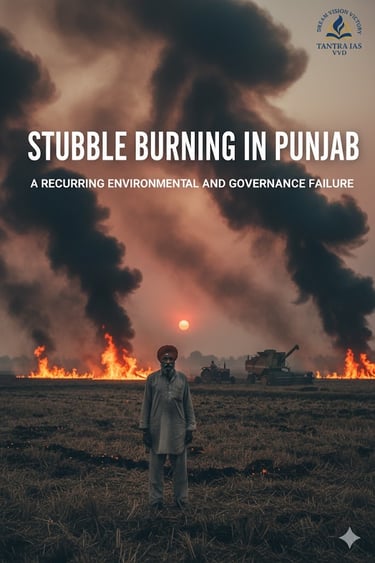
STUBBLE BURNING: AGRARIAN ECONOMICS VS ENVIRONMENTAL GOVERNANCE
1. What is Stubble Burning?
Stubble burning is the deliberate setting fire to leftover paddy or wheat straw after harvest to quickly clear fields for the next crop cycle.
It is most prevalent in Punjab, Haryana, and western Uttar Pradesh, coinciding with the post-harvest period of kharif paddy (October–November).
Scientifically, this leads to the release of particulate matter (PM 2.5 and PM 10), carbon monoxide, and nitrous oxide, aggravating air pollution across the Indo-Gangetic plain.
2. Why Farmers Do It — and Its Link to Agriculture & Farmers’ Welfare:
Despite awareness campaigns and penalties, many farmers still resort to burning due to:
Economic compulsion: Removing residue manually or with machinery (Happy Seeder, Super SMS) costs ₹2,000–₹3,000 per acre.
Time pressure: Only a 15–20 day window between harvesting paddy and sowing wheat.
Lack of viable alternatives: Limited reach of crop residue management (CRM) schemes and inadequate bio-decomposer usage.
Policy-technology mismatch: Incentives are delayed, and institutional support for residue collection is weak.
From a welfare lens, this shows how environmental responsibility cannot precede economic security. The transition must be incentive-led, not penalty-led.
3. What the Data Says:
743 cases of stubble burning between Sept 15–Oct 26, 2025 (PPCB).
122 cases in a single day — the highest of the season.
31.72 lakh hectares under paddy; 56.5% harvested so far.
266 FIRs filed under Section 223 of the Bharatiya Nyaya Sanhita (BNS).
₹16.8 lakh fines imposed; 296 “red entries” in land records (for habitual offenders).
70% drop in farm fire cases vs 2023 — but pollution impact persists due to weather and wind flow stagnation.
4. Prelims Relevance:
Policies: National Policy for Management of Crop Residues (2014); CAQM (statutory body).
Schemes:
Crop Residue Management (CRM) Scheme under DACFW
PUSA Bio-Decomposer (ICAR innovation)
Central Sector Scheme on Promotion of Agricultural Mechanization
Acts: Air (Prevention and Control of Pollution) Act, 1981; Environment Protection Act, 1986.
Concept Focus: Agro-based pollution, sustainable farming, and resource-use efficiency.
5. Mains Relevance (GS3):
Question:
“Why has stubble burning persisted despite legal and technological interventions? Evaluate the role of behavioural economics and governance design in addressing it.”
Answer Outline:
Intro: Stubble burning mirrors the gap between policy design and farmer pragmatism.
Causes: Cost, time, institutional fragmentation, and lack of awareness.
Consequences: Air pollution, soil nutrient loss, and greenhouse gas emissions.
Solutions:
Decentralized composting & biomass-based energy generation.
Farmer producer organization (FPO)-based machinery banks.
Timely compensation and performance-based rewards to Panchayats.
Behavioural nudges and participatory enforcement instead of pure penalization.
Conclusion:
Environmental sustainability in agriculture must be built on economic logic, not administrative fear.
6. Current Relevance (2025):
Punjab’s 2025 spike underlines India’s struggle to meet National Clean Air Programme (NCAP) targets.
Section 223 (BNS) used for farm-fire offences for the first time.
CAQM has begun real-time satellite mapping of fire incidents using ISRO data.
Policy takeaway for aspirants: Coordination failure between Centre–State, poor ground-level institutional capacity, and weak incentive architecture remain India’s core governance bottlenecks.
TANTRA IAS – INSIGHT NOTE:
“Farmers don’t burn fields because they want to pollute; they burn because governance hasn’t yet offered them an affordable alternative.”
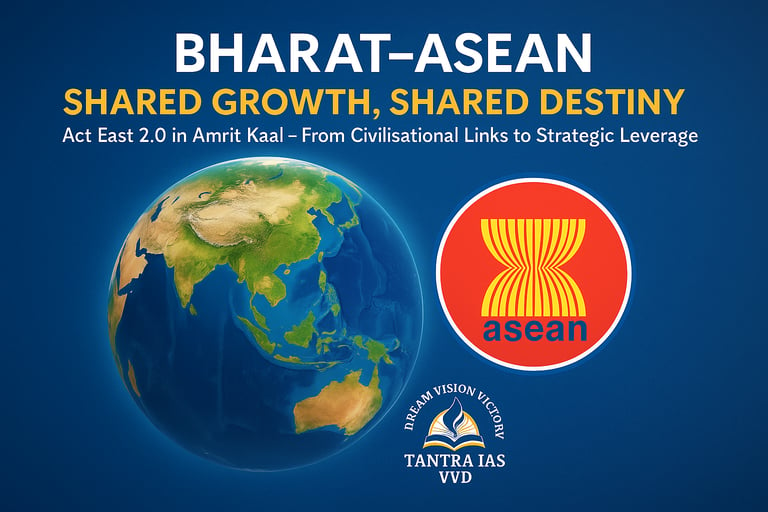

🌏 “BHARAT–ASEAN: SHARED GROWTH, SHARED DESTINY”
Act East 2.0 in Amrit Kaal — From Civilisational Links to Strategic Leverage
(Tantra IAS Masala Daily | Prelims + Mains + Mindset Edition)
🇮🇳 CONTEXT — THE QUIET REVOLUTION IN ASIA:
At the 47th ASEAN–India Summit (2025), Prime Minister Modi described ASEAN as “Bharat’s natural partner in peace, prosperity and people-centred progress.”
He reaffirmed that the Comprehensive Strategic Partnership is the bedrock of the Indo-Pacific Vision, announcing collaboration in maritime security, digital connectivity, and climate-smart growth by 2026.
“The 21st century belongs to Asia — and Bharat and ASEAN will co-author its future.”
UPSC EXAM RELEVANCE: CLICK TO READ:
📊 DATA BREW | PRELIMS POINTERS (2025 Focus)
🧠 UPSC VALUE CHAIN (Each Line Carries Marks)
THE OXYMORON FILE (Tantra IAS Signature Table)
📚 MAINS PRACTICE QUESTIONS (2026 Probables)
🕊️ TANTRA TAKEAWAY | THE BHARAT MODEL OF DIPLOMACY:
“Bharat doesn’t dominate Asia — it connects it.”
The ASEAN engagement proves that Bharat’s power lies in predictability, not provocation.
In Amrit Kaal, foreign policy has shifted from alignment to agency — where every partnership advances both Viksit Bharat 2047 and regional harmony.
This is Bharat’s soft strength re-engineered as hard strategy.
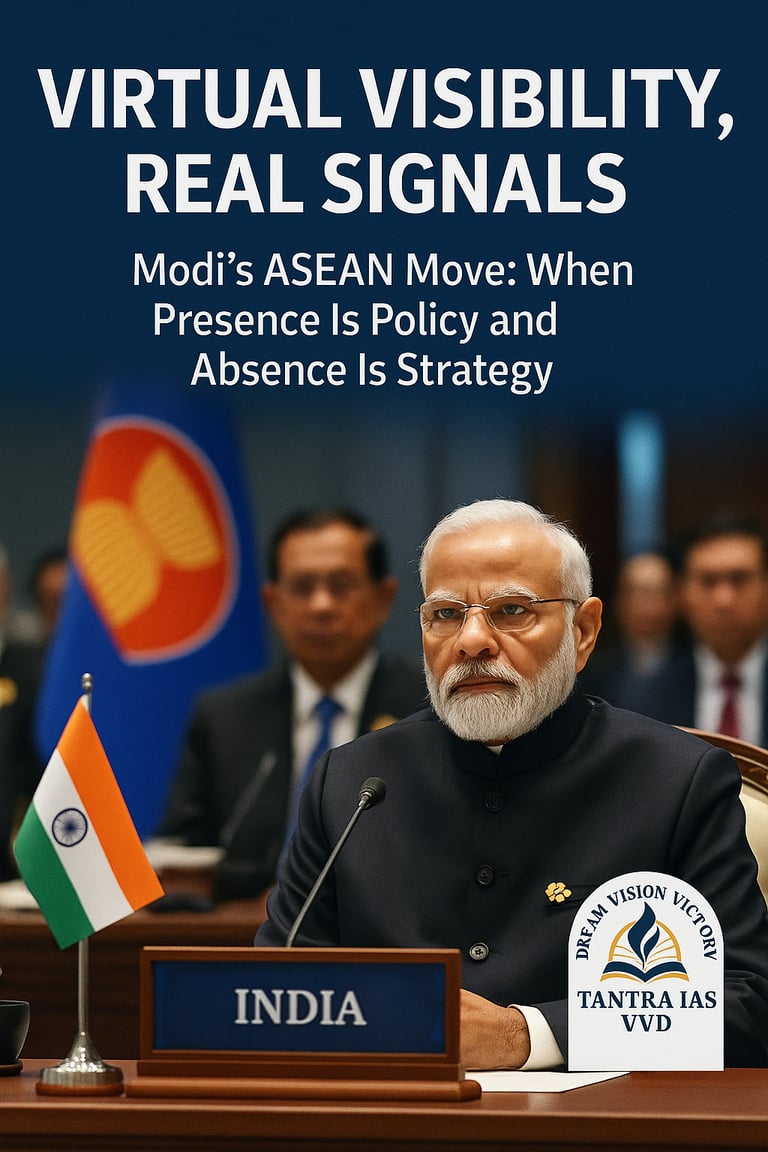

🌏 “VIRTUAL VISIBILITY, REAL SIGNALS”
PM Modi’s ASEAN Move: When Presence Is Policy and Absence Is Strategy!
(Tantra IAS Masala Daily | Prelims + Mains + Mindset Edition)
🧭 CONTEXT:
Prime Minister Narendra Modi will attend the 47th ASEAN–India Summit virtually, skipping a physical appearance in Kuala Lumpur.
Officially, it’s due to scheduling constraints — but diplomatically, it’s a masterclass in calibrated caution.
In the backdrop of renewed unpredictability in U.S. foreign policy under Donald Trump’s influence, India has chosen strategic restraint over performative diplomacy.
🇮🇳 AMRIT KAAL DIPLOMACY – “CAUTIOUS IS THE NEW COURAGE”:
This decision signals India’s confidence in a multi-aligned foreign policy — engaging all, aligning with none.
It embodies the Modi government’s evolved external doctrine:
“Global but grounded, assertive yet autonomous.”
India avoided being theatrically positioned between Trump’s transactional diplomacy and ASEAN’s multilateral subtleties.
The move reflects the “Neighbourhood First, World Next” mindset — prioritising stability over spectacle.
It’s consistent with the Doctrine of Multi-alignment, a key IR theme for GS2: balancing QUAD, BRICS, ASEAN, and G20 equations simultaneously.
In strategic terms, India reaffirms Strategic Autonomy 2.0 — modernised from non-alignment to interest alignment.
⚙️ UPSC VALUE CHAIN (Every Line Counts):
GS2 – International Relations: Virtual participation highlights India’s diplomatic recalibration amid shifting U.S.–China dynamics in the Indo-Pacific.
GS3 – Economy & Energy: Avoiding a direct Trump–Modi meet keeps trade and energy negotiations insulated from unpredictable optics.
GS1 – Geography: ASEAN remains India’s maritime bridge between Act East and Indo-Pacific vision.
GS4 – Ethics in Diplomacy: Leadership restraint becomes a form of ethical statecraft — power with patience.
📊 DATA BREW | PRELIMS POINTERS:
ASEAN (Association of Southeast Asian Nations): 10-member regional bloc headquartered in Jakarta.
India–ASEAN Trade: Over US $110 billion (2024–25) — India’s 4th largest trading partnership.
India–U.S. Trade: Tariff friction continues, with duties on some goods rising up to 50 percent.
Virtual Diplomacy: India has attended over 40 global summits online since 2020, signalling the institutionalisation of “Digital Geopolitics.”

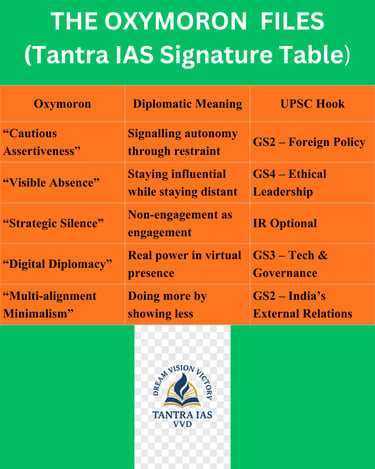
📚 MAINS PRACTICE QUESTIONS (2026 Probables)
1️⃣ “India’s virtual diplomacy reflects a shift from presence-based participation to perception-based influence. Discuss in the context of the ASEAN–India Summit.”
2️⃣ “Evaluate how India’s pursuit of ‘Strategic Autonomy 2.0’ enables it to balance major power competition in the Indo-Pacific region.”
🕊️ TANTRA TAKEAWAY:
“In diplomacy, silence is not absence — it’s assertion in disguise.”
India’s virtual visibility is not a retreat, but a recalibration.
In the age of power projection, strategic patience is the new superpower.
Modi’s ASEAN strategy perfectly mirrors the ethos of Amrit Kaal foreign policy —
Pragmatic. Proactive. Purpose-driven.
🧩 READY DIAGRAM FOR MAINS (Tantra IAS Visual):
Hub: Virtual ASEAN Participation
Spokes:
U.S. (Trade Tensions)
ASEAN (Regional Balancing)
Indo-Pacific (Security Calculus)
Russia (Energy Leverage)
Domestic Optics (Controlled Narrative)

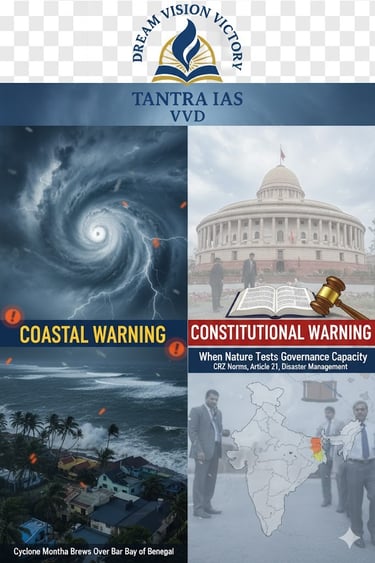

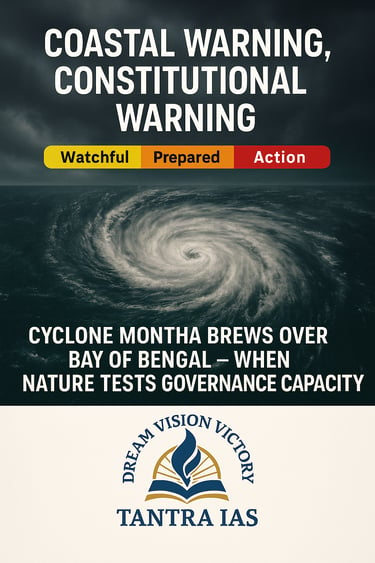
🌪 COASTAL WARNING, CONSTITUTIONAL WARNING!
When Nature Sends Alerts, Governance Gets Tested
(Tantra IAS Masala Daily | Prelims + Mains + Mindset Edition)
🌊 CONTEXT
A low-pressure system over the southeast Bay of Bengal is intensifying and may evolve into Severe Cyclone Montha, putting Chennai and coastal Tamil Nadu on high alert.
The IMD has issued orange warnings for heavy rain and strong winds — a test not only of meteorology but of multi-level governance preparedness.
🧠 UPSC VALUE CHAIN (Each Line Counts):
The event exemplifies Disaster Risk Governance — a GS2 & GS3 intersection of policy, federalism, and resilience.
Early warning systems under the Sendai Framework (2015–2030) showcase India’s alignment with global disaster goals.
The National Disaster Management Act (2005) institutionalizes coordinated response from NDMA → SDMA → District Disaster Units — a real-world example for GS2.
In climate discourse, it reflects “tropical cyclone intensification” linked to warming sea surface temperatures, a probable UPSC GS3 question area.
The use of IMD color-coded alerts (Yellow–Orange–Red) embodies the shift from reactive relief to predictive prevention.
Ethically, it raises the dilemma of economic coastal expansion vs ecological resilience — a GS4 layer.
⚙️ DATA BREW | PRELIMS POINTERS:
Cyclone Montha: expected to form by October 27–28 in the Bay of Bengal’s southeast quadrant.
Wind speed could touch 90–110 km/h, rainfall exceeding 200 mm in coastal belts.
The Bay of Bengal accounts for 80% of India’s cyclones, largely due to warmer waters and funnel-shaped topography.
Alert colors:
🟡 Yellow – “Be Watchful”
🟠 Orange – “Be Prepared”
🔴 Red – “Take Action”Tamil Nadu State Disaster Management Authority (TNSDMA) coordinates local preparedness; NDRF teams pre-positioned in vulnerable districts.
📚 MAINS QUESTIONS (2026 Probables):
“Cyclone Montha highlights the maturing of India’s disaster risk governance architecture. Critically examine the role of institutions like NDMA and IMD in minimizing loss of life.”
“Discuss how India’s coastal urbanisation policies must evolve to ensure resilience against intensifying tropical cyclones in the Bay of Bengal.”
📜 ETHICAL REFLECTION (For GS4 Integration):
“Nature doesn’t negotiate — it only notifies.”
True resilience lies not in relief camps, but in responsible planning.
In Amrit Kaal, the moral duty of governance is foresight, not firefight.
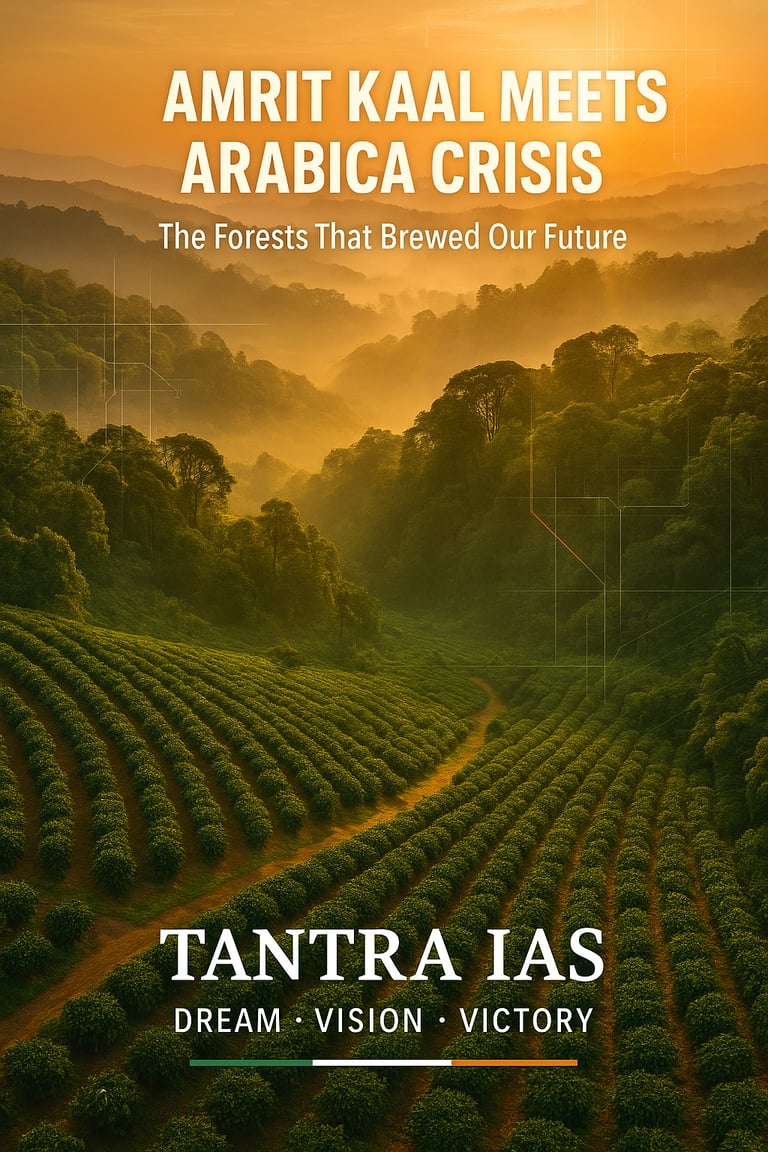


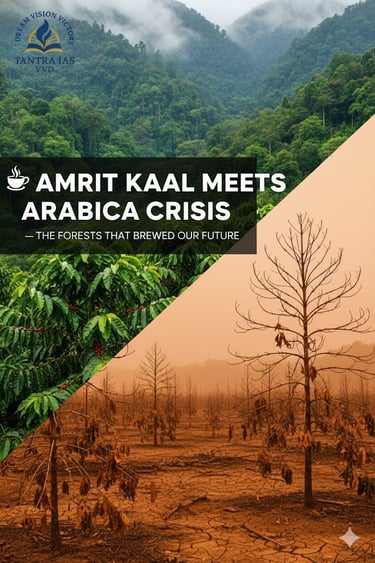
☕ AMRIT KAAL MEETS ARABICA CRISIS — THE FORESTS THAT BREWED OUR FUTURE!
🌍 CONTEXT: THE CLIMATE CAFFEINE PARADOX
Every morning, the world begins with 2 billion cups of coffee—and possibly, 2 billion acts of climate amnesia.
Brazil’s rainforests are being cleared to plant more coffee, but deforestation is cutting the rainfall that coffee itself needs.
This is the new oxymoron of globalisation: “Grow More, Rain Less.”
When Arabica meets Amrit Kaal, development without forests becomes like coffee without caffeine—bitter and unsustainable.
In India, sustainability has moved from slogan to statecraft.
Schemes like:
Mission LiFE (Lifestyle for Environment): Promotes pro-planet choices.
Green Credit Programme (2023): Monetises eco-conservation.
PM-PRANAM (Promotion of Alternate Nutrients): Incentivises less chemical, more mindful farming.
Amrit Kaal Vision 2047: Envisions a “Green GDP” economy — balancing ecology with economy.
“India isn’t just growing coffee; it’s brewing consciousness.”
⚖️ THE UPSC VALUE CHAIN:
GS1: Agro-climatic zones shifting due to deforestation.
GS2: Balancing food & forest policy, Cooperative federalism in environmental law.
GS3: Climate–rainfall–crop–economy link.
GS4: Ethical consumerism, Intergenerational equity
📉 DATA BREW (For MAINS + PRELIMS):
Deforestation ↓ rainfall in Brazil’s coffee zone by 75% (Nature Communications, 2024)
Global coffee output ↓ 30% projected by 2050 (FAO Report, 2024)
India ranks 6th in global coffee production (~3.5 lakh tonnes, Coffee Board of India, 2023)
Western Ghats: India’s coffee heartland; UNESCO biodiversity hotspot under threat from land-use change.
Soil–Moisture Feedback Loop: Reduced canopy → less evapotranspiration → weaker monsoon → reduced yield.
🧩 PRELIMS BOOSTER BOX (MCQ POTENTIAL):
1️⃣ Coffee Cultivation in India – Climatic Conditions
Requires 15–28°C temperature, 1500–2500 mm rainfall.
Mostly in Karnataka (65%), Kerala (20%), Tamil Nadu (10%).
2️⃣ Coffee Varieties
Arabica (mild, high-altitude, shade-loving)
Robusta (low-altitude, hardy, disease-resistant)
3️⃣ India’s Coffee Board (1942) – Statutory body under Ministry of Commerce & Industry.
4️⃣ Mission LiFE – Launched at COP27 (Egypt, 2022) by India to promote individual climate action.
5️⃣ Green Credit Programme (2023) – Under Environment (Protection) Act, 1986, administered by MoEFCC.
6️⃣ Western Ghats – Receives orographic rainfall; forms part of UNESCO World Heritage; hotspot for climate–agriculture interdependence.
📜 UPSC MAINS PRACTICE QUESTION (2025 | GS3):
“Deforestation for cash crops exemplifies the paradox of growth and degradation. Discuss how Mission LiFE and the Green Credit Programme can reconcile environmental integrity with economic development.”
🧭 TANTRA TAKEAWAY
“Climate is not an environmental issue anymore—it’s a governance exam we all keep failing.”
Forests are the real GDP—Gross Determinants of Precipitation.
In Amrit Kaal, green ambition must be matched by green accountability.
Every coffee sip must echo the ethics of sustainability—because “no rain, no grain, no gain.”




🩺 THE DOCTOR WHO EXPOSED A SWEET LIE: ETHICS THAT CHANGED POLICY:
GS Paper 4 – Ethics, Integrity & Aptitude | GS Paper 2 – Health Governance & Consumer Protection
🧭 1️⃣ CONTEXT / IN THE NEWS:
For eight relentless years, Dr. Sivaranjini Santhosh, a Hyderabad-based paediatrician, fought a lonely battle against the misbranding of sugary beverages as “ORS” (Oral Rehydration Solution) — drinks falsely marketed as life-saving formulations for children.
Her evidence-based advocacy led the Food Safety and Standards Authority of India (FSSAI) in April 2022 to ban the use of the word “ORS” on any beverage that does not meet the WHO-prescribed rehydration formula.
💬 “There were big companies — but truth was bigger.”
This victory stands as a shining example of ethics in public action, proving that moral courage can influence national policy.
🎯 2️⃣ UPSC RELEVANCE:
Prelims Boosters
FSSAI: Statutory body under the Food Safety and Standards Act, 2006.
ORS (WHO-formula): Balanced ratio of glucose, sodium, potassium, chloride.
Front-of-Pack Labelling (FOPL): Key upcoming reform for nutritional transparency.
Mains Relevance
GS4: Integrity, Professional Ethics, Courage of Conviction, Whistle-blowing, Public Interest.
GS2: Health Regulation, Consumer Awareness, Accountability in Governance.
Case Study Use: “An ethical professional challenging systemic complacency for the public good.”
⚖️ 3️⃣ ISSUE & ETHICAL DIMENSIONS:
Integrity & Moral Courage: She confronted powerful brands and bureaucratic inertia, guided only by conscience.
Professional EthicsUpheld “Do No Harm” beyond her clinic — ensuring community welfare.
AccountabilityHighlighted regulatory lapses within the food-safety framework.
Corporate EthicsExposed unethical marketing that exploited consumer trust.Citizen ActivismShowed how informed individuals can trigger systemic change.
Moral LeadershipPractised value-based decision-making — a model for administrators.
🛠️ 4️⃣ WAY FORWARD:
Institutionalise Ethical Whistle-blowing: Protect professionals who raise genuine public-interest issues.
Strengthen Market Regulation: Ensure random audits and strict penalties for misbranding of food-health products.
Integrate Ethics in Medical & Administrative Training: Reinforce moral reasoning, conflict-of-interest handling.
Public Health Literacy: National campaigns to educate consumers on safe hydration and product labelling.
Collaborative Oversight: Coordination among FSSAI, DCGI, and state health departments for cross-sector regulation.
🧩 5️⃣ TOPPER’S TOOLKIT:
Keywords: Integrity, Whistle-blowing, Consumer Safety, Ethical Governance, Courage of Conviction.
Thinkers to Quote:
Immanuel Kant: “Act out of duty, not desire.”
Mahatma Gandhi: “Truth never damages a cause that is just.”
Diagram Idea: Flowchart – “Misbranding → Public Risk → Ethical Action → Regulation → Awareness.”
Current Links: FSSAI Ban (2022), Consumer Awareness Mission 2024, National Nutrition Strategy.
Answer Use: Ethics Case Study, GS2 Governance, or Essay on Integrity in Public Life.
🔱 6️⃣ TANTRA IAS TAKEAWAY:
🩺 “One doctor’s conscience cured a policy blind spot.”
Dr. Sivaranjini Santhosh embodies ethical citizenship — blending science, courage, and integrity to protect the public.
Her story is not just medical — it’s moral.
It shows how values can outlast vested interests, and how ethical conviction can be governance in action.
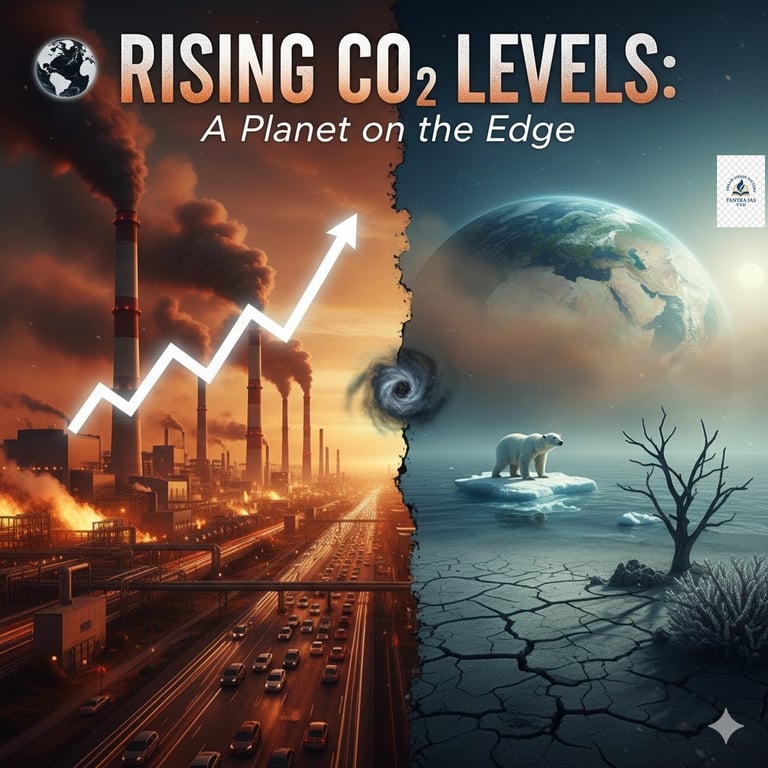

🌍 RISING CO₂ LEVELS: A Planet on the Edge
🔹 Context
Carbon dioxide (CO₂) concentrations have increased by a record margin between 2023 and 2024, marking one of the sharpest annual rises in atmospheric CO₂ ever recorded.
This spike underscores the accelerating pace of climate change driven by fossil fuel combustion and natural climatic variability.
Highlights:
Record CO₂ Rise: +2.9 ppm in one year (2023–24).
Present CO₂ concentration: ~51% higher than pre-industrial (1750) levels.
Main contributors: Power sector, transport, cement and steel industries.
Other GHGs:
Methane (CH₄): 30% of warming since 1750; rising from agriculture, landfills.
Nitrous Oxide (N₂O): From fertilizers, livestock manure.
2024 likely among the warmest years ever recorded.
🔹 India’s Efforts
Target: Net-Zero by 2070; 500 GW renewables by 2030.
Policies: National Hydrogen Mission, Carbon Credit Trading Scheme (2024), National Bioenergy Policy.
India’s per-capita emission: 1.9 tonnes vs global average of 4.4 tonnes.
🎯 UPSC Relevance:
🔸 Prelims Boosters
“CO₂ concentration in atmosphere (2024)” → ~423 ppm
“Main contributors to global warming” → CO₂ > CH₄ > N₂O
“Mission LiFE” launched by → India at COP26 (Glasgow, 2021)
“Net-Zero by 2070” – India’s target year.
“National Hydrogen Mission” aims at green fuel transition.
🔸 Mains Utility
GS Paper 3: Environment, Climate Change
Q. “Discuss the causes and consequences of rising CO₂ levels and suggest measures to meet India’s Net-Zero commitments.”
🔹 Challenges
Continued fossil fuel dependence.
Inadequate progress on Net-Zero and NDCs.
Limited climate finance and tech transfer to developing nations.
Weak carbon market regulation and CCS adoption.
🔹 Way Forward
Energy Transition: Rapid scaling of renewables and EVs.
Carbon Pricing Mechanisms: Enforce “polluter pays” principle.
Natural Carbon Sinks: Reforestation, wetland restoration, soil carbon storage.
Climate Governance: Strengthen COP compliance, global monitoring.
Lifestyle Revolution: Promote Mission LiFE for sustainable consumption.
📰 TANTRA IAS INSIGHT:
“Each ppm of CO₂ is a warning — not just a statistic. The planet’s patience is measurable, and it’s thinning fast.”
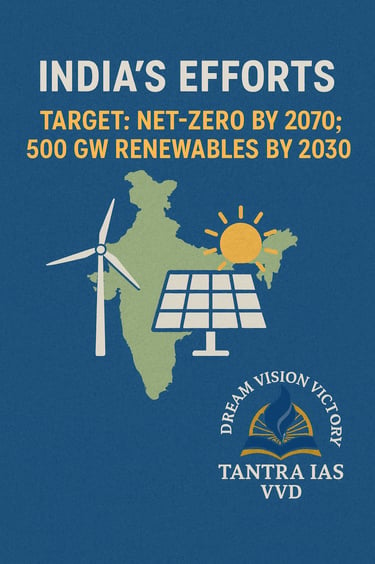



📈 EVOLUTION, REVOLUTION — Nobel Economics 2025 & the Freedom to Innovate
Theme: Economic Growth | Institutional Change | Knowledge Economy
📌 Context:
The 2025 Nobel Prize in Economic Sciences has been awarded to Nicholas Bloom, Peter Howitt, and Ned Phelps — for their groundbreaking work linking innovation, freedom, and productivity in driving long-term economic growth.
Their models bridge technological evolution with institutional flexibility, arguing that societies thrive when they balance creativity with stability — when reform and risk-taking coexist with rule-based governance.
🧠 Core Ideas of Their Work:
Innovation as an Economic Engine:
Economies grow not merely by capital or labour, but by ideas and adaptability.
Creative Destruction (Schumpeterian model):
New firms and technologies displace old ones — generating productivity and growth.
Freedom + Security:
Economic vitality depends on institutional freedom — allowing experimentation while ensuring safeguards.
Societal Resilience:
Innovation requires tolerance for uncertainty — societies that embrace this see faster technological diffusion.
⚖️ GS2–GS3 Relevance
GS2:
Institutional reforms, governance, and ease of doing business.
Role of government in fostering innovation.
GS3:
Inclusive growth and employment.
Science & tech–driven development; innovation ecosystems; productivity & reforms.
Essay Link:
“Freedom is not the absence of regulation, but the presence of opportunity.”
🌍 Contemporary Significance (2024–25):
India’s Economic Reforms 4.0: Push for MSME digitization, AI-enabled logistics, and startup policy reforms.
Global AI Race: Productivity surge vs ethical regulation dilemma.
Climate Tech Boom: Linking innovation with sustainability — the new growth paradigm.
Gati Shakti & ONDC: India’s digital infrastructure aligning with the “freedom to innovate, freedom to trade” model.
💡 Toolkit for Mains/Essay:
Keywords: Innovation Ecosystem | Institutional Evolution | Dynamic Efficiency | Creative Destruction | Economic Freedom | Productive Risk-taking
Diagram Idea: Flowchart – Freedom → Innovation → Productivity → Inclusive Growth.
Quote for Enrichment:
“The engine of progress is freedom guided by responsibility.” — Nicholas Bloom
🧩 Prelims Boosters:
Nobel Prize in Economics (official name): Sveriges Riksbank Prize in Economic Sciences in Memory of Alfred Nobel.
First Awarded: 1969 (to Ragnar Frisch and Jan Tinbergen).
2025 Winners: Nicholas Bloom (Stanford), Peter Howitt (Brown), Ned Phelps (Columbia).
Core Field: Endogenous growth theory & innovation economics.
India Link: Aligns with DPIIT’s Startup India Mission & National Innovation Ecosystem 2.0 (2025 draft).
💬 Tantra IAS Takeaway
Innovation isn’t chaos — it’s structured freedom.
The 2025 Nobel laureates remind policymakers that progress demands space for ideas to evolve — where regulation nurtures, not restrains.
India’s true growth revolution lies not in control, but in confidence.

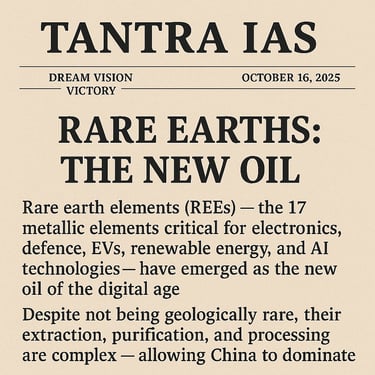

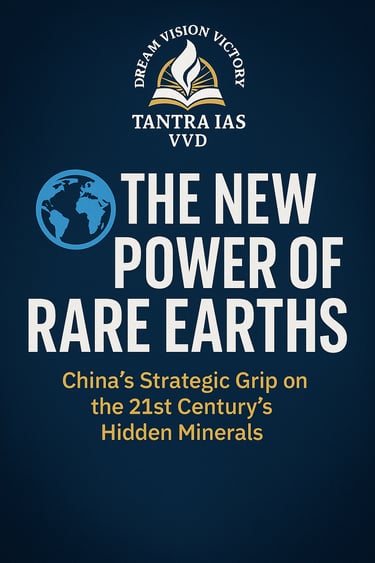
🌍 THE NEW POWER OF RARE EARTHS — China’s Strategic Grip on the 21st Century’s Hidden Minerals
Theme: Global Trade | Strategic Resources | Science & Tech Diplomacy | Economic Security
📌 Context
Rare earth elements (REEs) — the 17 metallic elements critical for electronics, defence, EVs, renewable energy, and AI technologies — have emerged as the new oil of the digital age.
Despite not being geologically rare, their extraction, purification, and processing are complex — allowing China to dominate the global supply chain.
⚙️ Facts
China’s Dominance: Controls ~70% of global production and 85–90% of processing capacity.
Major Producers: China, USA, Myanmar, Australia, Thailand, Madagascar, India.
Top Reserves: China (44 Mt), Vietnam (22 Mt), Brazil (21 Mt), Russia (12 Mt), India (6.9 Mt).
India’s Output (2023): ~3% of global total — led by Indian Rare Earths Ltd (IREL) under DAE.
🧠 Why REEs Matter?
Green Tech Backbone: Used in EV batteries, wind turbines, and solar panels.
Defence Applications: Guidance systems, radars, missile tech.
Electronics: Smartphones, semiconductors, lasers, fiber optics.
Strategic Leverage: Beijing uses supply restrictions as a geopolitical tool in trade conflicts (notably with the US & Japan).
⚖️UPSC MAINS Relevance
GS2:
International trade politics; resource diplomacy; India’s Act East & Indo-Pacific strategies.
GS3:Economy, science & tech, and security linkage; resource management; Atmanirbhar Bharat initiatives.
🔋 India’s Strategic Push
Domestic Exploration:
Atomic Minerals Directorate mapping new REE reserves in Odisha, Kerala, and Jharkhand.
Quad Critical Minerals Partnership (2023): Collaborative supply-chain diversification.
India–Australia Rare Earths MOU: Focused on securing lithium & REEs.
Atmanirbhar Rare Earth Mission (2024 draft): Indigenous value addition & recycling.
Recycling & Circular Economy: National Resource Efficiency Policy in pipeline.
🧩 Toolkit for Mains
Keywords: Techno-geoeconomics | Resource Nationalism | Critical Mineral Security | Supply Chain Resilience | Green Industrial Policy
Diagram Idea:
World map showing rare earth reserves + pie chart of production share (China vs rest).
Data Nugget: China — 70% production; India — 6.9 million tonnes reserves.
Quote (for GS3 Essay link): “He who controls rare earths, controls the 21st century’s energy transition.” — Anonymous Geopolitical Maxim
🌱 Prelims Boosters
Rare Earths (17 Elements): Lanthanides + Scandium + Yttrium.
India’s Major Sources: Monazite sands (Kerala, Odisha, Tamil Nadu).
Nodal Body: Department of Atomic Energy (DAE) via IREL.
Global Initiative: Minerals Security Partnership (MSP) — USA-led grouping to counter China.
India’s Membership: India joined MSP in June 2023.
REE Minerals in Demand: Neodymium, Dysprosium, Terbium (used in magnets & EVs).
🧭 2024–25 Current Linkages
✅ India’s inclusion in US-led MSP (2023) for securing global mineral chains.
✅ Quad Critical Minerals Dialogue (2024): Joint exploration, processing tech sharing.
✅ ISRO–IREL Collaboration (2025): REE-based high-performance alloys for space components.
💬 Tantra IAS Takeaway:
Rare earths are the invisible arteries of modern economies — powering everything from smartphones to missiles.
India’s next strategic frontier lies not underground, but in mastering the geo-economics of extraction, processing, and partnership diplomacy.

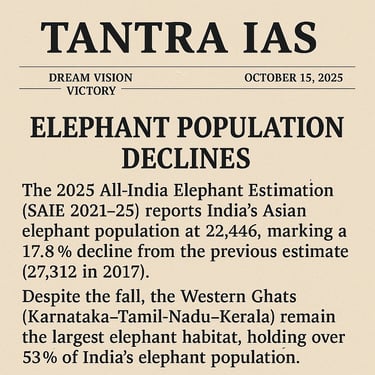
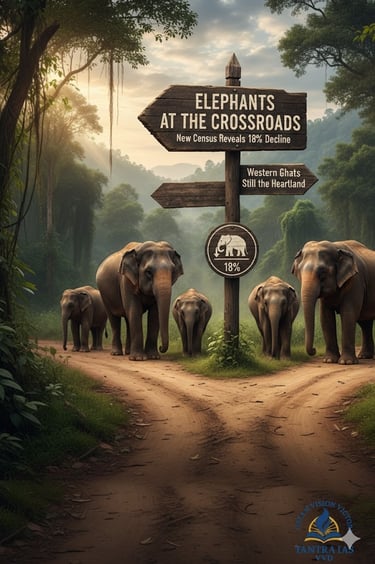

🐘 “ELEPHANTS AT THE CROSSROADS” — New Census Reveals 18% Decline; Western Ghats Still the Heartland:
Theme: Environment | Biodiversity | Conservation Governance
📌 Context
The 2025 All-India Elephant Estimation (SAIE 2021–25) reports India’s Asian elephant population at 22,446, marking a 17.8% decline from the previous estimate (27,312 in 2017).
Despite the fall, the Western Ghats (Karnataka–Tamil Nadu–Kerala) remain the largest elephant habitat, holding over 53% of India’s elephant population.
🌿 Key Findings (SAIE 2025)
Western Ghats: 11,934 elephants (53.2%) – primary habitat.
Northeast & Brahmaputra floodplains: 6,559 (29.2%).
Central India & Eastern Ghats: 1,891 (8.4%).
Shivalik Hills & Gangetic plains: 2,062 (9.2%).
Top states: Karnataka (6,013) > Assam (4,159) > Tamil Nadu (3,186) > Kerala (3,178).
🧠 Reasons for Decline
✅ Habitat fragmentation due to linear infrastructure & mining.
✅ Encroachment on elephant corridors.
✅ Crop raiding–human conflict escalation.
✅ Data limitations — undercounting, delayed NE surveys.
✅ Genetic isolation of smaller herds in central/eastern India.
Prelims Boosters (High-Value Facts):
SAIE 2021–25: Conducted by MoEFCC, coordinated by Project Elephant Division & Wildlife Institute of India (WII).
Species: India hosts >60% of global Asian elephants (Elephas maximus indicus) — Schedule I under WPA 1972; Endangered on IUCN Red List.
Elephant Reserves: 33 notified across 14 states; latest addition: Singphan ER (Nagaland) & Agasthyamalai ER (TN-Kerala).
Census Method: Combines DNA analysis, dung-based ID, and direct block sampling.
Corridor Protection: Elephant Corridors under Project Elephant and Eco-Sensitive Zone (ESZ) demarcation.
Conflict Hotspots: Odisha, Assam, Chhattisgarh, and Jharkhand — account for over 70% of deaths due to train/rail collisions.
Cultural Symbolism: Declared National Heritage Animal of India (2010) for ecological & cultural significance.Convention LinksIndia is part of CITES Appendix I for Asian elephants.
⚖️ GS3 Mains Relevance (Environment Section):
Conservation, environmental pollution, and degradation, environmental impact assessment.
→ Use as case study in biodiversity loss, anthropogenic pressure & eco-restoration.
→ Example: “The 18% decline in elephants highlights the need for a landscape-based conservation model integrating ecology with livelihoods.”Government initiatives:
🟩 Project Elephant (1992)
🟩 Elephant Corridors Project under CAMPA
🟩 Gaj Yatra (awareness initiative)
🟩 National Elephant Action Plan (2025 draft) — focus on human-elephant coexistence zones.
🌏 GS1 Linkage (Geography + Ecology):
Western Ghats: UNESCO Biodiversity Hotspot — continuous forests sustain elephant migration.
Shivalik & Terai: corridor under stress due to infrastructure and population pressure.
Integrated Conservation: Aligns with SDG 15 (Life on Land).
💡 Toolkit for Mains/Essay Answers:
Keywords: Keystone Species | Corridor Connectivity | Coexistence Model | Ecological Ethics | Genetic Mapping | Bio-Indicators
Data Nugget: 22,446 elephants; 17.8% decline; 53% in Western Ghats.
Quote (GS4 tie-in): “The greatness of a nation can be judged by the way its animals are treated.” – Mahatma Gandhi
🧩 2024–25 Case Studies:
Nilgiri Elephant Corridor verdict (SC, 2024): Upheld ecological corridors as legal commons.
Odisha Elephant Death Audit (2025): Linked to train collisions and deforestation.
Kaziranga–Karbi Anglong model: Community patrols reduce man-animal conflict.
🌱 Tantra IAS Takeaway:
India’s elephants stand at a moral and ecological threshold — between fragmented forests and fragmented conscience.
The next decade’s success will depend on how effectively India turns Project Elephant from a protection plan into a coexistence revolution.
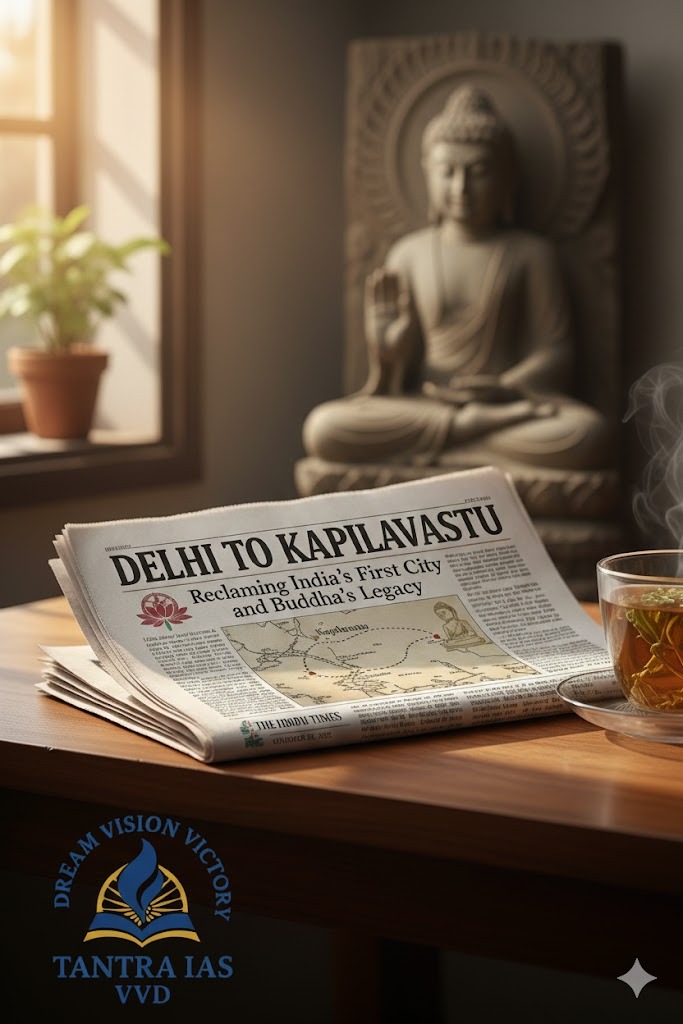

🏛️ QILA RAI PITHORA & PIPRAHWA RELICS — RECLAIMING INDIA’S CIVILIZATIONAL CONTINUUM:
Theme: Indian Culture | Art & Architecture | Heritage Diplomacy
📌 Context
The 12th-century fort city Qila Rai Pithora, built by Prithviraj Chauhan, Delhi’s earliest known ruler, is being redeveloped into a cultural exhibition site that will display Lord Buddha’s Piprahwa relics (from ancient Kapilavastu).
This marks a symbolic bridge between India’s earliest Hindu–Rajput architecture and Buddhist spiritual heritage, reinforcing the country’s civilizational unity.
🏺 Historical Background
Qila Rai Pithora (Mehrauli, Delhi): Expansion of Lal Kot, built by Tomar and Chauhan dynasties; marks the first urban fortification of Delhi before the Sultanate.
Piprahwa Relics (Siddharthnagar, UP): Archaeological site identified with Kapilavastu, excavated in 1898; contains Buddha’s sacred relics (inscribed reliquary casket).
🧠 Cultural & Political Significance
Cultural Continuity: Connects Indic kingship (Rajput valor) with Buddhist compassion and moral order — a living proof of India’s syncretic civilization.
Heritage Conservation: Example of adaptive reuse of monuments, aligning with UNESCO’s living heritage approach.
Cultural Diplomacy: Showcases India’s role as the cradle of Buddhism, strengthening South and Southeast Asian ties.
Decolonizing Narratives: Reclaims Delhi’s pre-Sultanate past, diversifying its historical memory beyond medieval empires.
Integration with Modern Policy: Linked to Azadi ka Amrit Mahotsav, Ek Bharat Shreshtha Bharat, and National Cultural Revival Mission (2025).
🧾 Prelims Pointers
Qila Rai Pithora: 12th-century fort by Prithviraj Chauhan, expanded from Lal Kot.
Piprahwa: Archaeological site linked to Kapilavastu, Buddha relics found by W.C. Peppe (1898).
Ministry: Culture Ministry & ASI under Azadi ka Amrit Mahotsav Heritage Series.
Inauguration: Likely by PM in October 2025.
⚖️ Mains Relevance
🧾 GS Paper 1 (History & Culture)
Indian culture will cover salient aspects of Art Forms, Literature, and Architecture from ancient to modern times.
→ Exam use: “The Qila Rai Pithora–Piprahwa revival exemplifies India’s multi-layered civilizational continuity—where political architecture meets spiritual archaeology.”
→ Case study reference: Heritage management & public engagement in monuments.
🧩 Topper’s Toolkit (Tantra IAS Add-ons)
Keywords: Civilizational Continuity | Heritage Diplomacy | Adaptive Conservation | Cultural Syncretism | Ethical Custodianship
2024–25 Case References:
Kashi Vishwanath Corridor, Purana Qila Revamp, Ajanta Conservation Project — similar heritage-restoration initiatives.
India–Nepal Buddhist Circuit as cultural diplomacy case.
Quote Use (GS1/GS4):
“A nation that forgets its heritage forgets its soul.” – A.P.J. Abdul Kalam
🌱 Tantra IAS Takeaway
The Qila Rai Pithora–Piprahwa project transforms archaeology into diplomacy — blending history, ethics, and identity into India’s 21st-century soft power.
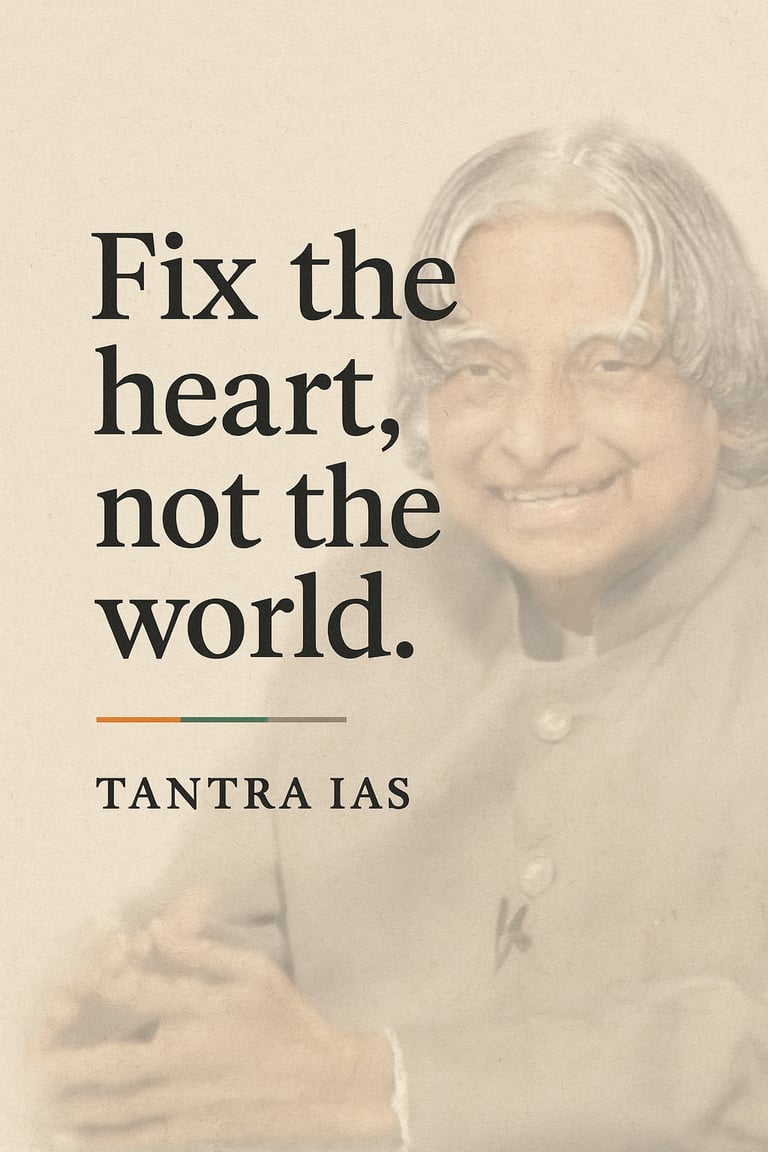

Dr. A.P.J. ABDUL KALAM: THE SCIENTIST, STATESMAN & ETHICAL VISIONARY:
Theme: Leadership | Ethics in Governance | Science & Human Values
📌 Context
Born October 15, 1931, Dr. A.P.J. Abdul Kalam—India’s “People’s President” and “Missile Man”—embodied the fusion of scientific innovation and ethical nation-building.
His legacy continues to inspire policy direction, youth engagement, and value-based governance in 2025, when India advances toward “Viksit Bharat @2047.”
🧪 Scientific & Strategic Contributions
ISRO (1969): Project Director for SLV-III; launched Rohini Satellite (1980).
DRDO: Architect of IGMDP—developed Agni, Prithvi, Akash, Nag.
Pokhran-II (1998): Strengthened India’s nuclear deterrence.
Authored India 2020, Wings of Fire, Ignited Minds—merging science, spirituality, and service.
⚖️ Ethical Leadership & Governance Vision
As President (2002–07), upheld dignity of office with empathy and humility.
Advocated Technology for Humanity — linking innovation to social equity.
Pioneered “Vision 2020” → now echoed in Vision India @2047 roadmaps.
Practiced “Leadership by Example” — personal integrity, simplicity, and public accountability.
Promoted values in youth: courage, curiosity, and compassion.
🧠 UPSC RELEVANCE
GS Paper 4:
Role of moral integrity in leadership.
Ethical responsibility of technocrats and public servants.
Application of scientific temper and human values in administration.
GS Paper 3:
Science & technology for inclusive development.
Indigenous innovation in defence and space.
Essay Paper:
“Dreams are not what you see in sleep, they are what keep you awake.”
🧩 Topper’s Toolkit (Tantra Signature Add-Ons)
Keywords: Ethical Innovation | Visionary Leadership | Service through Science | Integrity | Creative Accountability
Quotes & Their GS4 Applications:
“If you want to shine like a sun, first burn like a sun.”
→ Application: Dedication, perseverance, and sacrifice in civil service ethics.“Great dreams of great dreamers are always transcended.”
→ Application: Visionary leadership and inspiration in governance reform.“Excellence is a continuous process, not an accident.”
→ Application: Work ethics, self-evaluation, and institutional improvement.“You cannot change your future, but you can change your habits.”
→ Application: Personal conduct, integrity, and administrative discipline.
Case Study (2025 Integration):
Young IAS officers implementing Aspirational District Programme 2.0 inspired by Kalam’s model of “Leadership through Service and Innovation.”
🧾 Prelims Pointers
SLV-III (1980): Launched Rohini Satellite.
Awards: Bharat Ratna (1997), Padma Vibhushan, Padma Bhushan.
Missions: IGMDP, Pokhran-II.
Books: India 2020, Wings of Fire, Ignited Minds.
🌱 Tantra IAS Takeaway
“Kalam showed that science without ethics is power without purpose — and leadership without humility is authority without soul.”
THE STORY OF THE CALORIE: SCIENCE, SOCIETY & SELF-CONTROL
Theme: Science & Technology | Ethics in Nutrition | History of Scientific Ideas
📌 Context
The calorie, now an everyday metric of diet and energy, was born not in kitchens but in 18th-century laboratories. From being a scientific tool to measure energy, it evolved into a social and moral symbol of health, productivity, and body image — illustrating how scientific concepts acquire cultural power.
🧪 Scientific Evolution
Antoine Lavoisier (1780s): Linked breathing and metabolism to combustion — laid foundation for calorimetry.
Max Rubner & Wilbur Atwater (19th century): Quantified energy in food → “calorie” introduced to U.S. food labels.
The calorie became central to nutrition science, industrial labour studies, and early public health reforms.
💃 Social Transformation
1920s: Physician Lulu Hunt Peters’ bestseller Diet and Health turned calorie counting into a symbol of modernity, self-discipline, and female liberation — merging science, fashion, and morality.
“Counting calories” became not just health arithmetic but a language of self-control, influencing body ideals and consumption ethics.
🧭 Ethical & Governance Dimensions
GS4 Lens: Calorie counting evolved into a form of “moral arithmetic” — tying self-worth to restraint and discipline.
Reflects how science can influence values, body politics, and societal norms.
Raises ethical questions on body image, social pressure, and scientific neutrality.
🧠 Modern Scientific Reassessment (2020s)
“Calories in, calories out” now seen as oversimplified.
Nutrigenomics & Nutrimetabolomics: Study how genes interact with nutrition.
Personalized diet science shows calorie values differ by metabolism, gut bacteria, and food processing.
Illustrates limits of reductionist science — calls for holistic models of health and well-being.
💡 UPSC RELEVANCE
GS Paper 3:
Science & Technology in everyday life.
Historical evolution of scientific measurement systems.
Nutrition, health, and societal implications.
GS Paper 4:
Ethics of self-regulation, societal ideals, and scientific responsibility.
Interplay between science and human values.
Prelims Pointers:
Calorie: Unit of energy (1 cal = 4.184 joules).
Inventor: Antoine Lavoisier.
First practical use: Wilbur Atwater’s calorimeter (1890s).
Modern fields: Nutrigenomics, Nutrimetabolomics.
🧩 Topper’s Toolkit (Tantra Add-Ons)
Keywords: Calorimetry | Nutritional Ethics | Science of Self-Control | Anthropometry | Nutrigenomics
Quote: “Science shapes societies as much as it explains them.”
Case Insight: “Calories as governance” — early 20th-century public health reforms tied moral worth to energy efficiency.


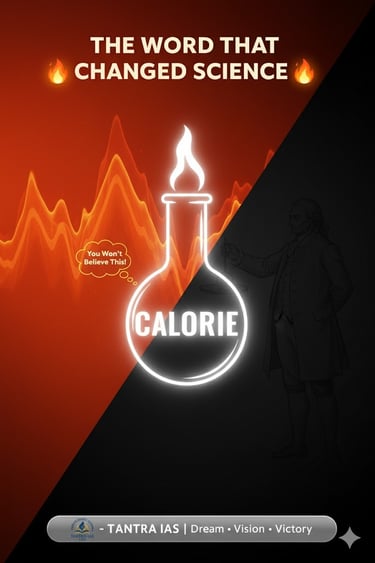

SPECIAL INTENSIVE REVISION (SIR) OF ELECTORAL ROLLS 2025
Theme: Electoral Reforms | Transparency & Accountability in Governance
📌 Context
The Election Commission of India (ECI) has launched a Pan-India Special Intensive Revision (SIR) of the electoral rolls to ensure error-free, transparent, and updated voter lists ahead of upcoming elections.
This follows pilot exercises in Bihar, where over 69 lakh duplicate/ineligible entries were removed and ~7.43 crore valid voters were confirmed.
⚙️ What is SIR?
A special, field-based revision drive under Section 21 of the Representation of the People Act, 1950.
Conducted beyond the normal annual revision when large-scale corrections or deletions are required.
Focuses on removal of duplicates, deceased, shifted, or ineligible voters and inclusion of first-time and migrant voters.
🧭 Objectives
✅ Purification of Voter Rolls: Ensure one-person-one-vote principle.
✅ Inclusion & Accessibility: Add eligible young voters (18–19 years).
✅ Transparency: House-to-house verification by Booth Level Officers (BLOs).
✅ Digital Integration: Use of Voter Helpline App & National Grievance Service Portal for self-verification.
⚖️ Legal & Constitutional Framework
Article 324: Powers of ECI to supervise, direct, and control elections.
Representation of the People Act, 1950: Section 21 – Electoral roll preparation and revision.
2003 Rules & 2016 Guidelines: Provide for Special Revision under extraordinary circumstances.
🔍 Recent Developments (2024–25)
Bihar: 69 lakh deletions; SC asked ECI to focus on “inclusion, not exclusion.”
West Bengal: SIR preparations reviewed; digital verification system introduced.
Supreme Court Monitoring: Ensuring no eligible voter is disenfranchised.
Pan-India Launch: Planned across all States/UTs by mid-2025.
💡 Significance
🌐 Strengthens democratic integrity and public confidence in electoral process.
📊 Enhances data accuracy for election management.
👥 Promotes youth participation and inclusivity.
⚙️ Aligns with Digital India for real-time voter authentication.
⚠️ Concerns & Criticism
⚠️ Allegations of mass deletions without due verification (Bihar case).
⚠️ Risk of bureaucratic overreach and voter disenfranchisement.
⚠️ Political sensitivity in states with migrant populations.
⚠️ Need for better grievance redressal and citizen awareness.
🧠 UPSC RELEVANCE
GS Paper 2:
Electoral reforms, transparency in governance, role of ECI.
Democratic participation, trust in institutions.
Prelims Pointers:
Body: Election Commission of India.
Legal Basis: Article 324, RP Act 1950 (Sec. 21).
Purpose: Clean, inclusive voter lists.
Current Data: Bihar – 7.43 crore voters post-SIR; 69 lakh deletions.
Apps Used: Voter Helpline App, Garuda App.
🧩 Topper’s Toolkit
Keywords: Electoral Integrity | Clean Voter Roll | Inclusion over Exclusion | Voter Verification
Quote: “Free and fair elections begin with free and fair lists.”
Case Study (2025): Bihar SIR controversy – highlighted balance between accuracy and inclusion, prompting SC oversight.


“MAITRI II: INDIA’S NEW FRONTIER IN ANTARCTICA”
Theme: Science & Technology | Environment | International Relations
📌 Context
The Finance Ministry has approved the establishment of Maitri II, India’s fourth Antarctic research base, to be built in eastern Antarctica by January 2029.
🔹 Outlay: ₹2,000 crore (over 7 years)
🔹 Implementing Agency: NCPOR (Goa) under the Ministry of Earth Sciences
🌍 Background
India’s first base Dakshin Gangotri (1983) — decommissioned.
Maitri (1989) and Bharati (2012) — currently operational.
Maitri II will advance India’s long-term polar research and commitments under the Antarctic Treaty (1959) and Antarctic Act (2022).
🔬 Features of Maitri II
✅ Located in eastern Antarctica (near Schirmacher Oasis)
✅ Focus on climate change, glaciology, ocean–atmosphere dynamics, biodiversity, and renewable energy
✅ Equipped for remote-sensing studies, sustainable waste management, & zero-carbon operations
✅ Will strengthen India’s role in global polar research networks
💡 Significance
🌡️ Enhances understanding of polar-climate interactions with the Indian Ocean.
🌊 Strengthens India’s scientific diplomacy and environmental leadership.
⚙️ Encourages innovation in clean energy, logistics, and extreme-climate infrastructure.
🧭 UPSC MAINS RELEVANCE
GS Paper 1: Geophysical phenomena, polar geography.
GS Paper 3: Scientific Research & Innovation, Environmental protection & climate cooperation, India’s Antarctic policy & international obligations.
🧾 UPSC PRELIMS RELEVANCE
Maitri II: India’s fourth Antarctic research base.
Implementing Agency: National Centre for Polar and Ocean Research (NCPOR), Ministry of Earth Sciences.
Existing Bases: Maitri (1989), Bharati (2012); Dakshin Gangotri (1983) – now decommissioned.
Antarctic Act 2022: Provides legal framework for India’s Antarctic activities.
Antarctic Treaty 1959: Ensures peaceful scientific cooperation; India a signatory since 1983.
Location: Eastern Antarctica → Schirmacher Oasis region.
🧠 Topper’s Toolkit (Tantra Signature)
Keywords: Polar Diplomacy | Antarctic Act 2022 | Sustainable Research | Climate Governance
Quote: “Science in service of sustainability defines India’s polar mission.”
Diagram Idea: Map showing India’s 3 operational bases + proposed Maitri II (East Antarctica).

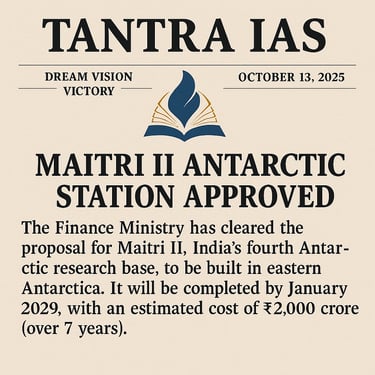
“BASE YEAR REBOOT: Aligning Numbers with New India”
Theme: Growth & Development | Industrial Policy | Economic Indicators
📌 Context
The Ministry of Statistics and Programme Implementation (MoSPI) has initiated the process to revise the base year of the Index of Industrial Production (IIP) from 2011–12 to 2022–23.
This aims to better reflect current industrial structure, technological shifts, and new production patterns in India.
⚙️ About IIP
Published by: NSO, MoSPI
Measures: Volume of production in manufacturing, mining, and electricity.
Base Year (current): 2011–12
Use: Serves as a short-term indicator of industrial growth and contributes to GDP estimates and policy planning.
📈 Why Base Year Revision?
Structural changes post–COVID (Make in India, PLI, MSME expansion).
Inclusion of new industries and emerging technologies (EVs, LEDs, semiconductors).
Alignment with latest GDP series and International Recommendations (UN, IRIP 2010).
Reflects sectoral diversification — services, green manufacturing, and data-driven innovation.
💡 Key Changes Proposed
✅ Expansion of product coverage – inclusion of EVs, batteries, chips, solar modules.
✅ Elimination of obsolete items.
✅ Integration of GST and ASI data for real-time accuracy.
✅ Seasonally-adjusted IIP for improved forecasting.
✅ Use of digital factory returns to ensure reliability.
🧭 UPSC Relevance
GS Paper 3:
Inclusive growth & industrial policy.
Role of data in economic governance.
Government reforms for productivity and competitiveness.
Prelims:
Publisher: NSO (MoSPI)
Frequency: Monthly
Current Base Year: 2011–12 (proposed: 2022–23)
Three sectors: Mining, Manufacturing, Electricity
🔍 Value Addition (Toppers’ Toolkit)
Keywords: Data-driven Industrial Policy | Structural Change | Economic Modernisation
Diagram Idea: Flowchart — IIP Revision → Better Data → Informed Policy → Industrial Growth
🧠 Takeaway
Updating IIP’s base year to 2022–23 is a timely reform to capture India’s new-age industrial economy, ensuring evidence-based policymaking and stronger growth forecasting for the decade ahead.
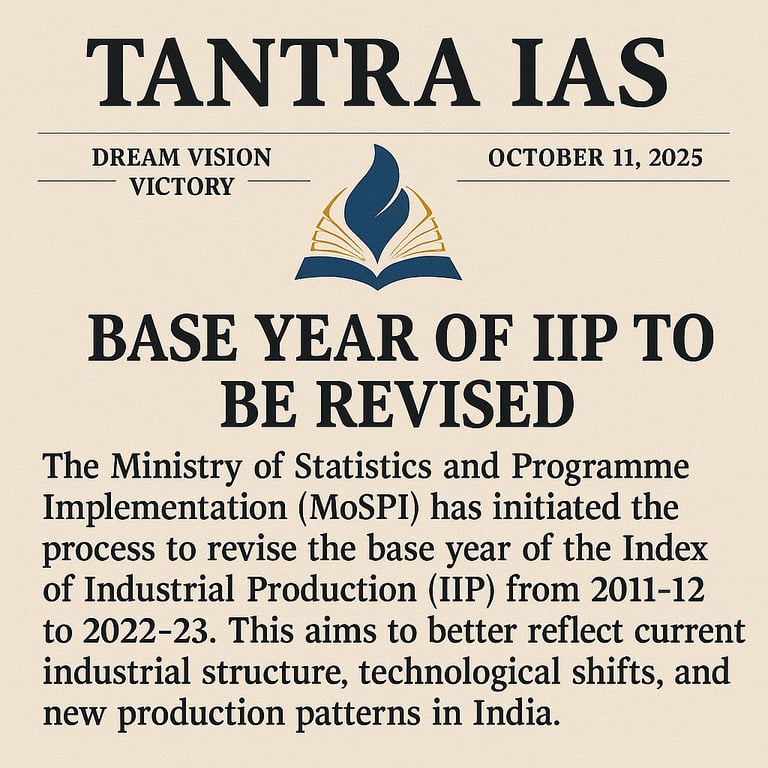

NOBEL PEACE PRIZE 2025: MARIA CORINA MACHADO
Theme: Democracy | Ethics in Public Life | International Relations
📌 Context:
The 2025 Nobel Peace Prize was awarded to Maria Corina Machado, Venezuelan opposition leader, for her non-violent struggle to defend democracy and human rights against the authoritarian regime of Nicolás Maduro.
Her recognition highlights the ethical and civic responsibility of individuals in protecting democratic institutions.
⚙️ Facts (Prelims Focus)
Awarded by: Norwegian Nobel Committee, Oslo.
Country: Venezuela.
Field: Defence of democracy, civic courage, and political freedom.
First Venezuelan laureate to receive the Nobel Peace Prize.
Prize citation: “For her unwavering fight for democracy, truth, and the rule of law.”
🧭 UPSC Mains Relevance:
GS Paper 2:
Role of individuals and civil society in democratic strengthening.
Authoritarianism vs participatory governance.
Global efforts toward peace and human rights.
GS Paper 4:
Ethical courage and integrity in public life.
Moral duty under political oppression.
Leadership rooted in justice and truth.
💡 Significance:
✅ Symbolises the moral defence of democracy amid rising global authoritarianism.
✅ Reinforces values of freedom, accountability, and ethical leadership.
✅ Highlights how individual conscience can inspire institutional reform.
🎯 Prelims Takeaways:
Nobel Peace Prize 2025: Maria Corina Machado (Venezuela).
Awarded for: Defence of democracy and civil rights.
Presented in: Oslo, Norway.
Associated Concept: Civic resistance, human rights, ethical governance.
🧠 Toppers’ Toolkit:
Keyword: Civic Courage | Democratic Ethics | Moral Resistance
Quote: “Democracy must be defended every day.” — Nobel Committee
Diagram Idea: Concentric layers — Individual → Civil Society → Global Peace.
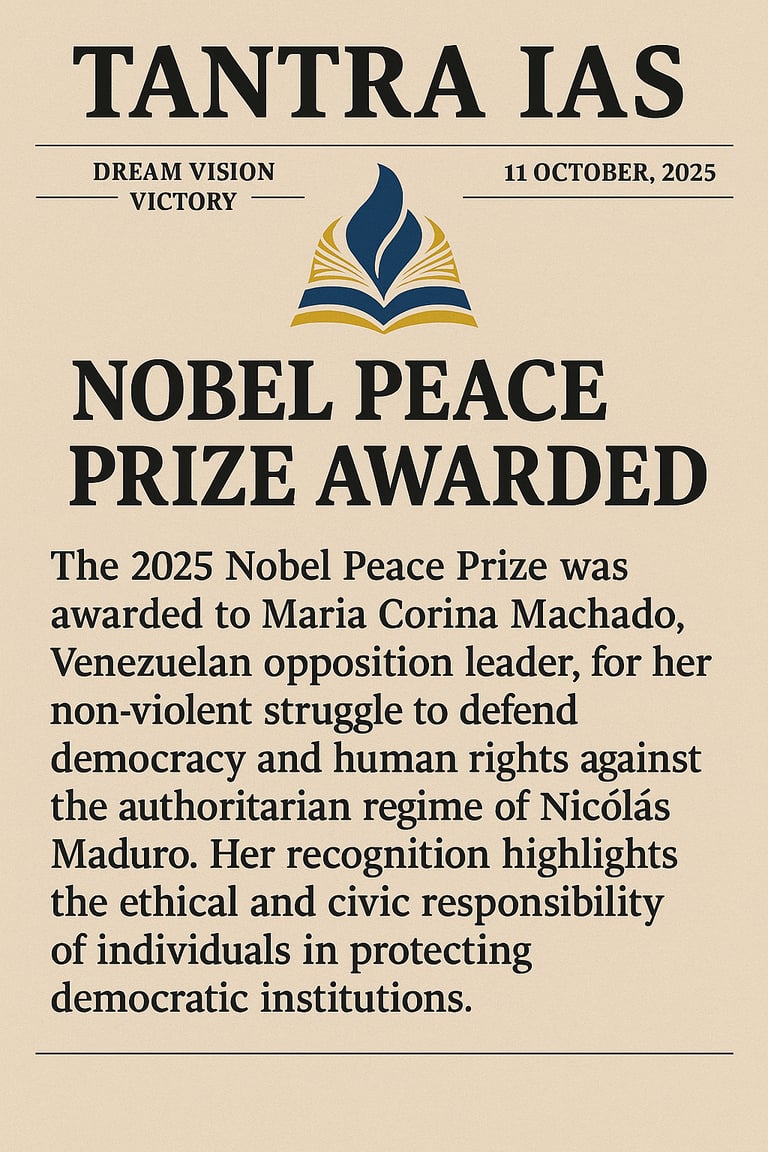

KERALA’S RIGHT TO PUBLIC SERVICE BILL, 2025
Theme: Governance | Accountability | Citizen-Centric Administration
🧠 Context
The Kerala Legislative Assembly has passed the Right to Public Service Bill (2025), which ensures time-bound delivery of government services, introduces penalties for delays, and creates a robust grievance redressal mechanism.
Chief Minister Pinarayi Vijayan called it a major step in ensuring transparency, accountability, and efficiency in governance — making it a citizen’s right to receive timely public services.
📜 Key Provisions
🔹 Right to Timely Services:
Citizens can demand notified public services within a prescribed time frame.
🔹 Penalty for Delay:
Officials failing to deliver services within the deadline will face fines or disciplinary action.
🔹 Appellate Mechanism:
Aggrieved citizens can appeal to higher authorities through a Commission for Public Service Delivery.
🔹 Designated Officers:
Each service will have an officer responsible for its timely provision; similar to RTI’s “Public Information Officer” model.
🔹 Transparency Mandate:
Departments must publicly display service timelines and officer responsibilities.
🧭 UPSC Mains Relevance
GS Paper 2:
Governance: Transparency, accountability, and citizen charter.
E-Governance: Time-bound delivery of services via digital platforms.
Constitution: Article 38 (social justice), Article 41 (right to work, education, and assistance).
⚙️ Comparative Insights
✅ Madhya Pradesh (2010) and Bihar (2011) pioneered similar Right to Service Acts.
✅ Kerala’s model strengthens the citizen’s legal recourse by adding a penalty clause and public accountability charter.
💡 Significance
✅ Empowers citizens to demand efficient governance.
✅ Builds trust and responsiveness in administration.
✅ Reduces corruption and bureaucratic delay.
✅ Enhances public service ethics and accountability.
⚖️ Challenges
⚠️ Possible bureaucratic resistance and delay in grievance disposal.
⚠️ Capacity constraints in monitoring compliance.
⚠️ Digital access gap for rural citizens.
🧩 Way Forward
🌐 Integrate with e-governance portals (Kerala Citizen Portal) for faster grievance tracking.
👥 Train officials in service ethics and citizen facilitation.
📊 Periodic audit and citizen feedback for improvement.
💬 Conclusion
Kerala’s Right to Public Service Bill reinforces the principle that “delay in service is denial of justice.” It marks a shift from a bureaucratic state to a citizen-centric democracy, institutionalising governance as a right.
🧠 Topper’s Toolkit (Value Add)
Keyword: Citizen Charter, Service Accountability, Time-bound Governance.
Quote: “Good governance is not an act of grace — it is a citizen’s right.”
Diagram Idea: Flowchart — Citizen → Application → Designated Officer → Timeline → Appeal Mechanism → Accountability Loop.
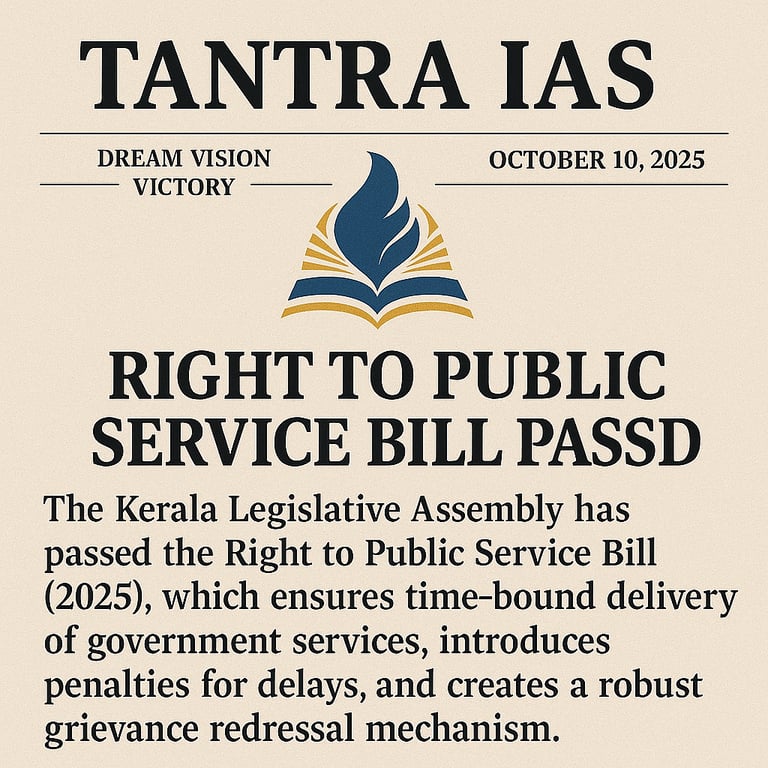

SC STAYS ARAVALLI SAFARI PARK PROJECT: ECO-TOURISM VS ECOLOGY
Theme: Environment | Sustainable Development | Conservation vs Development
🧠 Context
The Supreme Court has directed the Haryana Government to pause work on the proposed Aravalli Jungle Safari Project, citing concerns over environmental impact and violation of forest and wildlife protection norms.
The project, envisioned as India’s largest curated safari park across 10,000 acres in the Aravalli range (Gurugram–Nuh districts), was inspired by global models like Dubai’s Safari Park but faced criticism for potential ecological destruction.
📍 About the Project
Area: 10,000+ acres across Gurugram and Nuh.
Aim: To create a world-class eco-tourism hub combining safaris, adventure zones, and conservation education.
Estimated Cost: ₹500–₹1000 crore.
Funding: PPP (Public–Private Partnership) model.
Claimed Objective: “Maximising recreation and conservation synergy.”
⚖️ Supreme Court’s Concerns
✅ Whether the project violates Aravalli Notification (1992) and Forest (Conservation) Act, 1980.
✅ Fear of deforestation, fragmentation of wildlife corridors, and commercialisation of fragile ecosystems.
✅ Sought Environmental and Forest Clearances before proceeding.
🌱 Environmental Significance of Aravallis
Acts as green lungs for NCR — absorbs pollution and checks desertification.
Groundwater recharge and biodiversity hotspot (leopards, hyenas, peacocks, etc.).
Natural barrier against desert expansion from Rajasthan.
Over 20% forest cover already lost due to mining and construction.
🧩 Petitioners’ Argument
The park risks being an “eco-disaster in the name of eco-tourism.”
Violates principles of “Sustainable Development” and “Precautionary Approach.”
May threaten wildlife corridors connecting Sariska–Nuh–Asola–Bhatti Sanctuary.
🧭 Government Argument
Claims it promotes eco-tourism, jobs, and awareness.
Part of Haryana’s Vision 2047 for sustainable recreation.
Government assures adherence to green norms and sustainable models like safari zones and conservation parks.
📚 UPSC Mains Relevance:
GS Paper 3:
Conservation, environmental pollution, and degradation.
EIA, Environmental Governance, Wildlife Corridors.
GS Paper 2:Balance between developmental priorities and environmental ethics.
⚖️ Ethical & Policy Insight:
“When nature becomes a spectacle, conservation turns into commerce.”
Keyword: Sustainable Tourism vs Commercial Eco-tourism
Concept: Ecological Carrying Capacity
🌍 Way Forward
✅ Conduct Comprehensive EIA with wildlife impact analysis.
✅ Implement carrying capacity limits before eco-tourism expansion.
✅ Promote community-based ecotourism with local participation.
✅ Strengthen Aravalli Biodiversity Conservation Authority.
💬 Conclusion
The Aravalli case highlights India’s broader dilemma — how to balance developmental aspirations with ecological survival. The SC’s intervention reaffirms that true eco-tourism must serve nature, not profit.
🧠 Topper’s Toolkit
Keyword: Ecological Fragility, Sustainable Tourism, PPP Eco-parks.
Quote: “Protecting ecology is the highest form of economy.”
Diagram Idea: Balance scale — “Eco-Tourism Development” ⚖️ “Aravalli Conservation.”

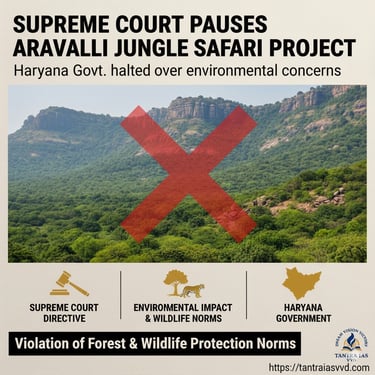


INDIA’S CONNECTIVITY GAP WIDENS (OOKLA 2025 REPORT)
Theme: Governance | Infrastructure | Digital Divide | Inclusive Growth
📰 Context
According to Ookla (2025 H1 Report), rural India’s mobile internet penetration stood at 58.8%, compared to 125.3% in urban areas, highlighting India’s widening digital connectivity gap.
The national average stood at 82.74%, showing persistent inequality in digital access and telecom infrastructure despite cheap data and widespread 4G coverage.
📊 Findings
🔹 Urban vs Rural Divide:
Urban penetration: 125.3% (multi-device, dual SIM usage common).
Rural penetration: 58.8% — only half the population connected.
Gap: 66.5 percentage points.
🔹 Regional Disparities:
High connectivity: Delhi, Goa, Chandigarh.
Low connectivity: Bihar, Dadra & Nagar Haveli, Diu.
🔹 Access ≠ Inclusion:
Availability of telecom networks hasn’t translated into digital empowerment due to affordability, awareness, and literacy gaps.
⚙️ Reasons for the Digital Divide
⚫ Unequal infrastructure rollout (private focus on profit-rich urban zones).
⚫ Low digital literacy & awareness in rural India.
⚫ Gender gap in mobile ownership.
⚫ Poor power supply & weak last-mile connectivity.
⚫ Limited regional-language digital content.
🧭 UPSC Mains Relevance
GS Paper 2:
Government policies and interventions for development.
Issues of governance and service delivery in rural areas.
GS Paper 3:
Infrastructure: Energy, Ports, Roads, Airports, Railways, and Telecommunications.
Inclusive growth and issues arising from it.
💡 Government Initiatives
✅ BharatNet Project: Optical fiber to all gram panchayats.
✅ Digital India Mission: Universal digital literacy and e-governance.
✅ PM-WANI Scheme: Public Wi-Fi hotspots for affordable access.
✅ 5G Bharat Vision 2030: Bridging connectivity across rural clusters.
⚖️ Challenges
⚠️ Infrastructure rollout delays.
⚠️ Weak regulatory oversight in universal service obligations.
⚠️ Underutilisation of funds like USOF (Universal Service Obligation Fund).
⚠️ Lack of indigenous digital ecosystem for rural needs.
🧩 Way Forward
🌐 Focus on “Digital Equity”, not just coverage.
🌐 Promote regional-language content and digital skilling.
🌐 Incentivise private–public partnerships in rural telecom expansion.
🌐 Ensure gender-responsive digital policies.
💬 Conclusion
India’s digital revolution remains urban-centric. To ensure inclusive growth, digital access must become a public utility—as essential as electricity or healthcare.
🧠 Topper’s Toolkit
Keyword: “Connectivity Deficit = Development Deficit.”
Quote: “Digital empowerment of one India must not mean digital exclusion of the other.”
Diagram Idea: Bar chart — Urban vs Rural penetration; Map highlighting high and low connectivity states.


CULTURAL BRIDGE: SOUTH–NORTH INTEGRATION THROUGH MUSIC IN AYODHYA
Theme: Indian Culture | Bhakti Movement | Integration of Arts & Spiritual Traditions
📰 Context
On October 8, 2025, Union Finance Minister Nirmala Sitharaman and UP CM Yogi Adityanath unveiled statues of three eminent South Indian saint-musicians — Purandaradasa, Tyagaraja Swami, and Arunachala Kavi — in Ayodhya, symbolising the cultural unity between North and South India through Ram Bhakti and Carnatic traditions.
About the Saint-Musicians:
1️⃣ Purandaradasa (1484–1564)
Known as the “Father of Carnatic Music.”
Introduced structured music pedagogy (Sarali, Janta, and Alankaras).
Composed devotional songs in Kannada praising Lord Vishnu and Rama.
His works shaped both Karnataka Sangeeta and the Bhakti tradition.
2️⃣ Tyagaraja (1767–1847)
Central figure of the Trinity of Carnatic Music (with Muthuswami Dikshitar and Syama Sastri).
Composed Pancharatna Kritis (five gems) in Telugu devoted to Lord Rama.
Bridged classical technique with spiritual devotion — “Nadopasana” (music as worship).
3️⃣ Arunachala Kavi (1711–1779)
Tamil poet-musician who composed Rama Natakam, a musical drama narrating Ramayana.
Helped shape Tamil devotional art and theatre.
🌉 Significance of the Event
✅ Represents a North–South cultural synthesis centred on Lord Rama and Bhakti.
✅ Highlights Ramayana’s pan-Indian universality across languages and musical forms.
✅ Promotes Ek Bharat Shreshtha Bharat — unity in spiritual and artistic expression.
✅ Connects Ayodhya (North) with Carnatic tradition (South), integrating devotional heritage.
🧭 UPSC Mains Relevance (GS Paper 1)
Art & Culture: Development of music forms and devotional movements.
History: Role of Bhakti saints in socio-cultural unity.
Society: Integration of regional identities through religion & art.
🎯 UPSC Prelims Angles
Purandaradasa → Father of Carnatic Music, Kannada compositions.
Tyagaraja → Pancharatna Kritis, Telugu bhakti compositions.
Arunachala Kavi → Rama Natakam, Tamil musical literature.
All three linked by Rama devotion (Ram Bhakti).
💡 Cultural Insight
“Bhakti transcends region and language — from Ayodhya’s kirtans to Thiruvaiyaru’s kritis, Rama unites India’s musical soul.”
🧩 Conclusion
The installation of these statues at Brihaspati Kund, Ayodhya, symbolises a living cultural dialogue between India’s diverse traditions — reaffirming that art, faith, and unity form the essence of Bharatiya Sanskriti.
🧠 Topper’s Toolkit
Keyword: “Cultural Integration through Bhakti Music.”
Quote: “North sings his glory, South composes his rhythm — both echo one Rama.”
Diagram Idea: Map linking Ayodhya → Karnataka (Purandaradasa) → Andhra (Tyagaraja) → Tamil Nadu (Arunachala Kavi) under “Ram Bhakti.”
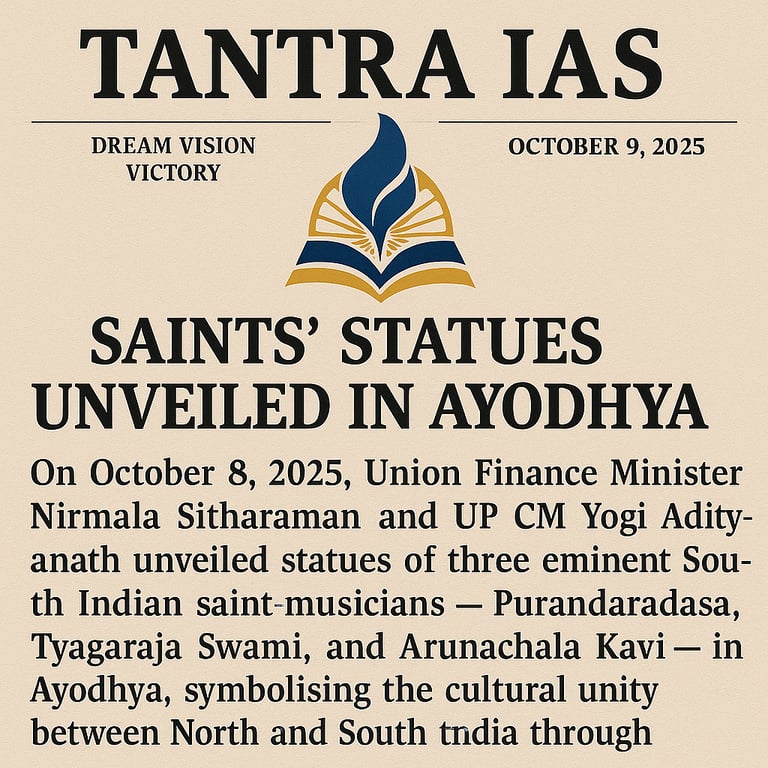

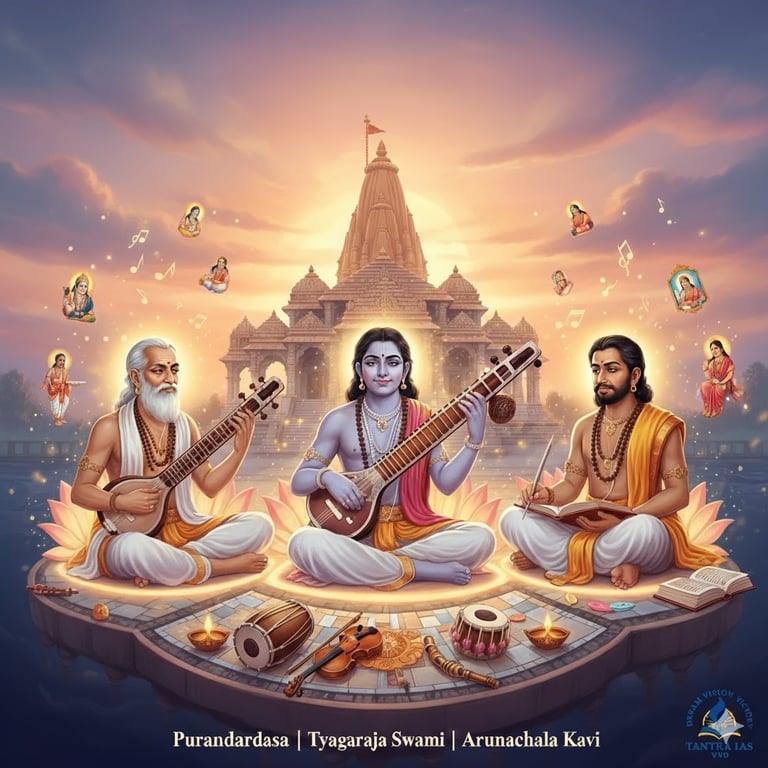

2025 NOBEL PRIZE IN CHEMISTRY:
Theme: Science & Technology | Chemistry | Environmental Sustainability
🧠 Context
The 2025 Nobel Prize in Chemistry has been awarded to Richard Robson (Australia), Susumu Kitagawa (Japan), and Omar M. Yaghi (USA) for their pioneering work on metal–organic frameworks (MOFs) — a revolutionary class of materials that “engineer empty space at the molecular level” to address environmental challenges.
⚙️ What Are MOFs?
🔹 Metal–Organic Frameworks are crystalline compounds made of metal ions linked by organic molecules, forming a porous 3D lattice.
🔹 These frameworks trap, store, or filter gases and molecules due to their tunable nano-sized voids.
🔹 Often called “sponges at the atomic scale.”
💡 Applications
✅ Carbon Capture & Storage (CCS): MOFs absorb CO₂ efficiently, mitigating greenhouse emissions.
✅ Water Harvesting: Capable of extracting moisture from arid air (used in desert water harvesters).
✅ Pollution Control: Capture of VOCs and toxic gases.
✅ Energy Storage: Hydrogen and methane storage for clean fuels.
✅ Catalysis & Drug Delivery: Tunable surfaces aid targeted molecular reactions.
🧭 UPSC Mains Relevance
GS Paper 3:
Science & Technology: Nanomaterials, innovative materials.
Environment: Climate change mitigation, carbon management.
Industry: Sustainable technologies and green chemistry.
Keywords: Metal–Organic Frameworks, Porous Materials, Carbon Capture, Sustainable Chemistry.
🎯 UPSC Prelims Relevance
Possible MCQ Angles:
1️⃣ MOFs are composed of metal ions + organic linkers forming porous networks.
2️⃣ They are used in carbon capture, hydrogen storage, and pollution control.
3️⃣ Discovered by Richard Robson, Susumu Kitagawa, and Omar Yaghi.
4️⃣ Term “Engineering Empty Space” refers to MOF design.
🌍 Significance
MOFs represent a new frontier in “chemistry of emptiness” — using voids to solve material and environmental problems.
Offer scalable solutions for climate resilience, renewable energy, and sustainable industry.
Bridge between materials science and molecular architecture.
⚖️ Challenges
⚠️ High synthesis cost and scalability issues.
⚠️ Thermal and chemical stability under real-world conditions.
⚠️ Limited awareness in industrial adoption.
🧩 Conclusion
The 2025 Nobel Prize celebrates “chemistry that shapes the invisible” — a discipline where molecular voids are engineered for human survival, transforming chemistry from a science of matter to a science of possibility.
🧠 Topper’s Toolkit
Keyword: “Engineering emptiness for environmental resilience.”
Quote: “Science begins not with what we see, but with what we shape in the unseen.”
Diagram Idea: MOF structure showing metal nodes + organic linkers + voids trapping CO₂ molecules.

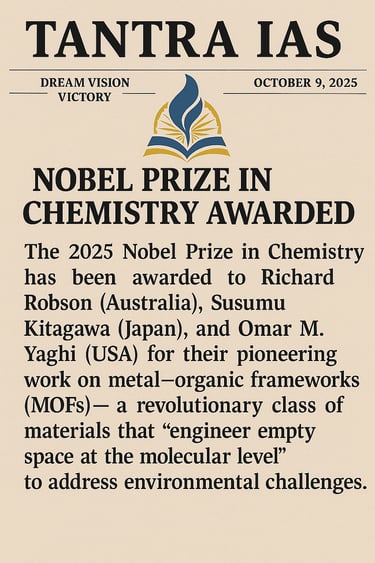
🗺️ PLACES IN THE NEWS — BAGRAM AIR BASE (AFGHANISTAN)
📍 WHERE IS THIS BAGRAM LOCATED?
In Afghanistan:
Province: Parwan Province, about 65 km north of Kabul (the capital).
Coordinates: Approx. 34°56′N 69°15′E
Situated in the Shomali Plain, close to the Hindu Kush mountains.
(On your world/Afghanistan map — mark it slightly north of Kabul.)
⚙️ Strategic Importance:
Largest military base in Afghanistan; built by the Soviets in the 1950s, expanded during the US-led war (2001–2021).
Served as headquarters for US & NATO forces during the “War on Terror.”
Equipped with two runways, surveillance facilities, and detention infrastructure.
After the US withdrawal (2021), control passed to the Taliban.
🌍 Geo-Politics:
India, Russia, China, Pakistan, and others opposed US re-deployment plans at Bagram during the Moscow Format consultations on Afghanistan.
India’s stance: deployment of foreign forces would “destabilise regional peace.”
Symbolic of regional consensus against renewed Western military presence.
🧭 UPSC Relevance:
GS Paper 2: India & its Neighbourhood, Regional Groupings, Foreign Policy.
GS Paper 3: Internal Security, Counter-terrorism cooperation.
Prelims Tip: Bagram is not in Kabul province — it’s in Parwan Province.
🧠 Mnemonic
👉 “Bagram Beyond Kabul” — remember: north of Kabul, near Hindu Kush.
UPSC PYQs:
Q. Consider the following pairs :
Towns sometimes mentioned in news Country. (UPSC PRE-2018)
1. Aleppo: Syria
2. Kirkuk: Yemen
3. Mosul: Palestine 4. Mazar-i-sharif: Afghanistan
Which of the pairs given above are correctly matched?
[A] 1 and 2
[B] 1 and 4
[C] 2 and3
[D] 3 and 4
Answer: B
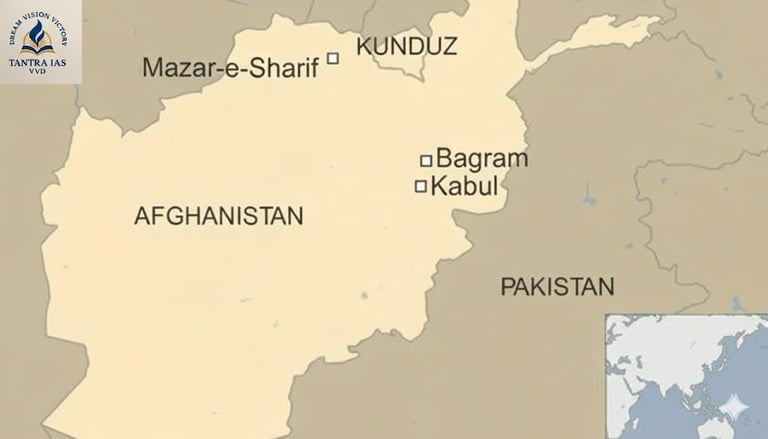

INDIA & THE MOSCOW FORMAT: AFGHANISTAN POLICY REALIGNMENT
Theme: International Relations | India & Its Neighbourhood | Global Groupings & Agreements
📰 Context
In a significant diplomatic move, India joined the Moscow Format Consultations alongside Russia, China, Pakistan, Iran, and the Taliban regime, issuing a joint statement opposing the US plan to deploy military infrastructure in Afghanistan — particularly at the Bagram Airbase.
This marks a rare instance where India aligned with regional actors including the Taliban, reflecting nuanced strategic recalibration in the Afghan peace process.
⚙️ About the Moscow Format
🔹 Established in 2017, led by Russia, to foster regional consensus on Afghan stability.
🔹 Includes India, Iran, Pakistan, China, Russia, and Central Asian nations.
🔹 Focus: Counter-terrorism, narcotics control, inclusive government, humanitarian aid, and regional security.
🧭 India’s Position
✅ Strategic Recalibration: Pragmatic engagement with the Taliban regime while avoiding formal recognition.
✅ Regional Stability Focus: Opposes foreign (US/NATO) military presence, aligning with Eurasian security interests.
✅ Humanitarian Assistance: Continued aid via UN agencies — wheat, medicine, and vaccines.
✅ Balancing Act: Supports Afghan sovereignty while maintaining concerns over Pakistan’s influence.
🧩 UPSC Mains Relevance
GS Paper 2:
India’s neighbourhood policy.
Bilateral & multilateral diplomacy.
Effect of policies of developed countries (US) on India’s interests.
Role of regional groupings (Moscow Format, SCO).
Themes:
“India’s strategic autonomy in multipolar Asia.”
“Balancing values with realpolitik in Afghanistan.”
🎯 UPSC Prelims Relevance:
Possible MCQ Angles:
1️⃣ Moscow Format is a regional mechanism for Afghan peace led by Russia.
2️⃣ India participated in the 2025 meeting alongside China, Iran, Pakistan, and Taliban representatives.
3️⃣ Bagram Airbase is located in Afghanistan, formerly used by the US forces.
4️⃣ India’s aid to Afghanistan is channelled through UN World Food Programme and WHO.
💡 Significance for India
✅ Prevents US re-entry into the Afghan theatre.
✅ Strengthens India’s role in Eurasian security architecture.
✅ Protects regional interests through dialogue over confrontation.
✅ Expands India’s diplomacy via “strategic pragmatism” — engaging without endorsement.
⚖️ Challenges
⚠️ Legitimacy dilemma — engaging Taliban without formal recognition.
⚠️ China–Pakistan bloc dominance in Afghan affairs.
⚠️ Limited on-ground leverage compared to 2001–2021 era.
🧩 Conclusion
India’s participation in the Moscow Format reflects a realist shift — from moral distance to strategic dialogue. It reaffirms India’s commitment to regional peace and sovereignty over unilateral interventions, while keeping counter-terrorism and stability at the forefront.
🧠 Topper’s Toolkit (Value Add)
Keyword: “Strategic Pragmatism.”
Quote: “In diplomacy, engagement is not endorsement — it’s an instrument of influence.”
Diagram Idea: Map — Moscow Format participants + India’s multi-alignment strategy in Eurasia.
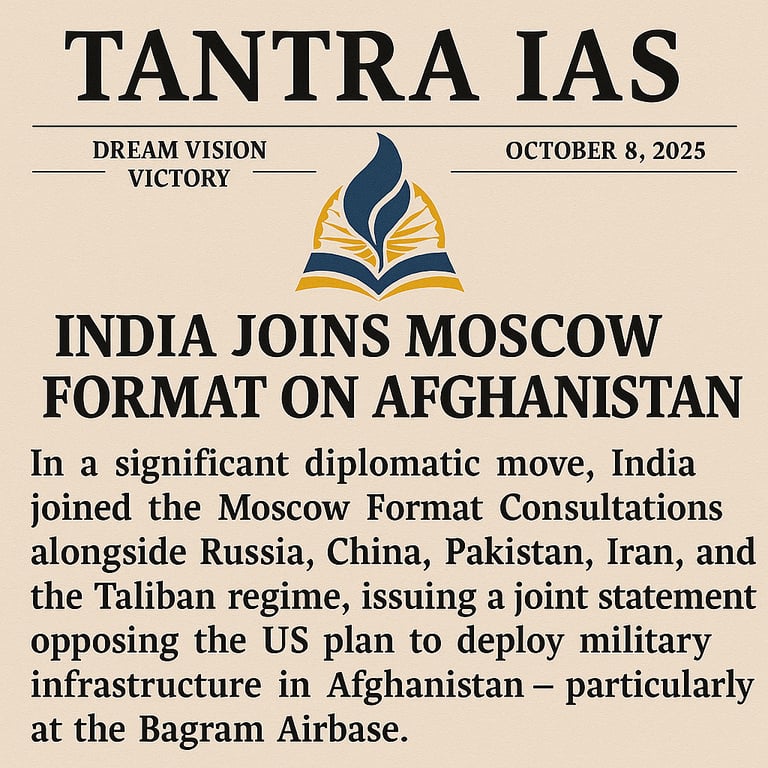

SPURIOUS COUGH SYRUPS & INDIA’S DRUG REGULATION CRISIS.
Theme: Health Sector | Governance | Regulatory Mechanisms | Ethics in Public Administration.
🧬 Context
Deaths of 14 children in Madhya Pradesh and Rajasthan (2025) due to contaminated cough syrups once again exposed gaps in India’s drug quality control system.
This follows a disturbing pattern — similar tragedies in Gambia (2022) and Uzbekistan (2023) linked to diethylene glycol (DEG) contamination in Indian-made syrups.
⚙️ The Issue
🔹 Toxic Ingredient: Diethylene glycol (DEG) — a solvent that causes acute kidney failure when consumed.
🔹 Regulatory Failure: Inadequate testing, poor coordination between state drug controllers and CDSCO (Central Drugs Standard Control Organisation).
🔹 Global Fallout: Export bans, reputational damage to India’s pharma sector.
🔹 Industry Paradox: India — “pharmacy of the world” — yet faces rising cases of spurious or substandard drugs domestically and abroad.
📊 Key Facts & Data
India supplies 40% of generic drugs to the US and 20% of global generics.
DEG-related deaths: Over 300 worldwide (past 30 years).
WHO flagged critical lapses in drug testing & traceability post-COVID.
Over 8% of India’s sampled drugs failed quality tests (CDSCO 2024 data).
🧭 UPSC Mains Relevance
GS Paper 2:
Issues relating to health, regulation & governance.
Role of statutory bodies (CDSCO, NPPA).
Accountability & ethical governance in public administration.
GS Paper 3:
Biotechnology & health research applications.
Industrial policy and pharma exports.
GS4 (Ethics):
Conflict between profit motive & public safety.
Ethical responsibility of regulators and manufacturers.
💡 Significance
✅ Urgent need for uniform national drug regulatory standards.
✅ Strengthen Central–State coordination for real-time product testing.
✅ Adoption of QR-based traceability for every medicine batch.
✅ Empower Drug Regulatory Authority of India (DRAI) with statutory autonomy.
✅ Ensure ethical accountability within the pharma sector.
⚖️ Challenges
⚠️ Fragmented federal structure for drug control.
⚠️ Weak enforcement & staff shortages in testing labs.
⚠️ Overdependence on exports — neglect of domestic oversight.
⚠️ Public trust erosion in “Make in India” pharma products.
🧩 Conclusion
India’s image as the “pharmacy of the world” cannot rest on low-cost mass production alone. Quality, ethics, and transparency must form the new foundation of Pharma 2.0 — where public health trumps profit.
🧠 Topper’s Toolkit (Value Add)
Keyword: “Pharma without ethics is a prescription for disaster.”
Quote: “Regulation is not a hurdle to innovation — it is its moral compass.”
Diagram Idea: Flowchart → Drug Manufacture → Testing → Export → Regulatory Failure → Policy Reform.
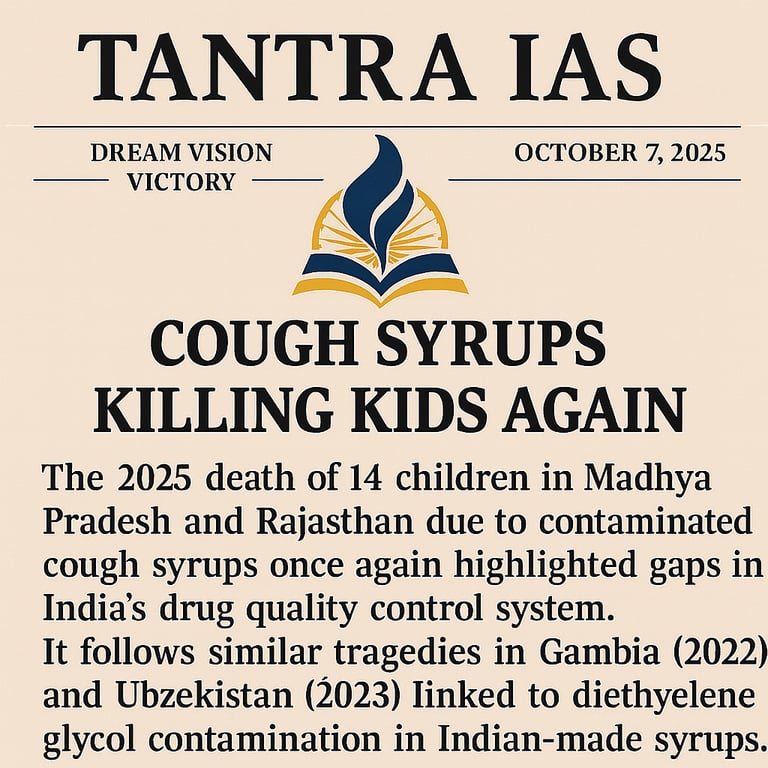

💧 WATER CONSERVATION PRIORITISED UNDER MGNREGA
Theme: Government Policies & Interventions | Rural Development | Sustainable Water Management.
📰 Context
The Central Government has amended the Schedule of the Mahatma Gandhi National Rural Employment Guarantee Act (MGNREGA), 2005, to prioritise water conservation and harvesting works in rural areas.
The Ministry of Rural Development (MoRD) notified this policy change on September 23, 2025.
⚙️ Key Highlights of the Amendment
🔹 New Focus: Rural water assets — check dams, percolation tanks, ponds, and recharge wells.
🔹 Minimum Share: 60% of MGNREGA works must now relate to agriculture and water conservation.
🔹 Groundwater Stress Priority: Over-exploited and semi-critical blocks will receive preferential funding.
🔹 Integrated Implementation: Linked with the Jal Shakti Abhiyan, Atal Bhujal Yojana, and PM Krishi Sinchai Yojana.
💦 Objectives
✅ Strengthen water resilience and sustainable rural livelihoods.
✅ Reduce dependence on monsoons and enhance farm productivity.
✅ Create durable community assets to tackle drought and climate stress.
✅ Promote convergence between environmental regeneration and employment.
🧭 UPSC Mains Relevance
GS Paper 2: Welfare schemes for vulnerable sections; issues in implementation.
GS Paper 3: Conservation of natural resources, Environmental impact and rural development synergy, Climate change adaptation through water management.
🎯 UPSC Prelims Pointers
Implementing Ministry: Ministry of Rural Development (MoRD).
Legal Backing: Section 16, Schedule I of the MGNREGA, 2005.
Key Classification:
Over-exploited blocks → >100% groundwater extraction.
Critical blocks → 90–100%.
Semi-critical → 70–90%.
MGNREGA Asset Types: Water harvesting, afforestation, flood control, and irrigation channel repair.
💡 Significance
✅ Aligns wage employment with long-term resource creation.
✅ Tackles India’s water crisis — over 70% districts water-stressed.
✅ Encourages decentralised, people-led water management.
✅ Strengthens climate adaptation under LiFE (Lifestyle for Environment).
⚖️ Challenges
⚠️ Skill & monitoring gaps at panchayat level.
⚠️ Delays in fund release and capacity building.
⚠️ Need for transparency in work prioritisation.
🧩 Conclusion
The amendment transforms MGNREGA into a “Water Security Employment Mission”, ensuring that livelihood generation and ecological balance go hand in hand — a critical step toward climate-smart rural governance.
🧠 Topper’s Toolkit (Value Add)
Keyword: “MGNREGA 2.0 — from Wage Security to Water Security.”
Quote: “Water is the foundation of both life and livelihoods.”
Diagram Idea: Flow → MGNREGA Amendment → Water Projects → Livelihood + Sustainability + Resilience.
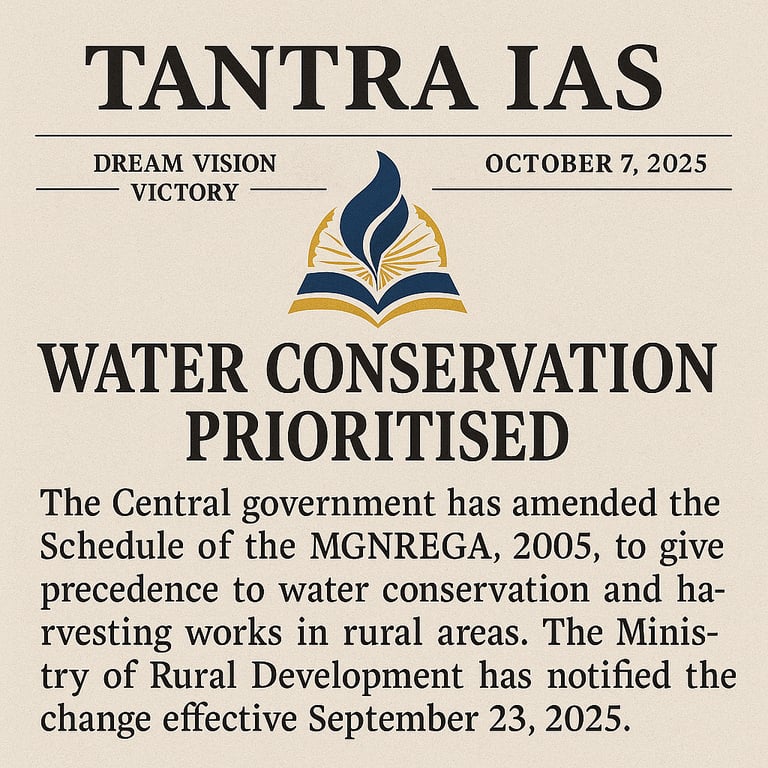

2025 NOBEL PRIZE IN MEDICINE
Theme: Science & Technology | Biotechnology | Human Physiology
🧠 Context
The 2025 Nobel Prize in Physiology or Medicine was awarded to Mary E. B. Runkow (USA), Frederick Ramsdell (USA), and Shimon Sakaguchi (Japan) for discovering Regulatory T Cells (Tregs) — the “police cells” that prevent the immune system from attacking the body’s own tissues.
⚙️ Key Discovery
🔹 Regulatory T Cells (Tregs): A subset of white blood cells that maintain immune tolerance — preventing the immune system from damaging self-tissues.
🔹 Gene Identified: FOXP3 — the master gene that controls Treg development.
🔹 Function: Tregs suppress overactive immune responses that can cause autoimmune diseases such as type-1 diabetes, rheumatoid arthritis, multiple sclerosis, and lupus.
🔹 Mechanism: They act as “brakes” of the immune system — balancing attack and restraint.
🔍 UPSC Mains Relevance (GS Paper 3)
Science & Technology: Developments in biotechnology & health research.
Health Sector: Understanding autoimmune disorders & immune regulation.
Applications: Future scope in immunotherapy, organ transplantation, and cancer treatment.
🎯 UPSC Prelims Relevance
Possible MCQ Angles:
1️⃣ 2025 Nobel Prize awarded for discovery of Regulatory T Cells (Tregs).
2️⃣ FOXP3 gene is associated with development of immune tolerance.
3️⃣ Function of Tregs → prevent immune system from attacking self-tissues.
4️⃣ Shimon Sakaguchi first identified Tregs in the 1990s.
5️⃣ Autoimmune diseases arise when immune tolerance fails.
💡 Significance
✅ Deeper understanding of immune balance → better treatment of autoimmune diseases.
✅ Foundation for next-generation cell-based immunotherapies.
✅ May lead to customised immune modulation in cancer & organ transplant medicine.
✅ Reinforces India’s focus on immunology under National Biotech Development Strategy 2025.
⚖️ Ethical Dimensions (GS4 Link)
Balancing medical innovation with safety & equity.
Ethical trials in gene therapy & immune modulation.
Access to immunotherapies in low-income nations.
🧩 Conclusion
This Nobel-winning discovery unravels one of biology’s deepest puzzles — how the immune system knows when to fight and when to stand down. It opens the path to curing autoimmune diseases through precision immunology.
🧠 Topper’s Toolkit (Value Add)
Keyword: “Immune tolerance through Regulatory T cells.”
Quote: “The immune system’s greatest strength is knowing its limits.”
Diagram Idea: Immune balance — Active T Cells vs Regulatory T Cells.

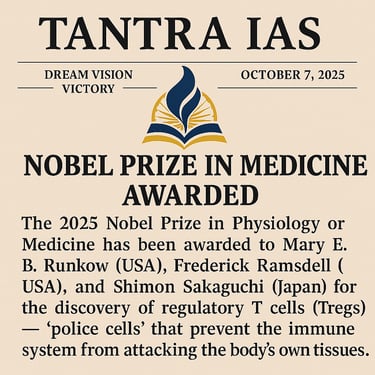
🚀 GAGANYAAN: INDIA’S LEAP INTO SPACE
Theme: Science & Technology | Indigenisation | Space Technology
🌍 Context
Gaganyaan Mission, led by ISRO, aims to send a 3-member Indian crew into low Earth orbit (400 km) for 3 days and bring them safely back to Earth. It represents India’s entry into the elite group of nations with human spaceflight capability — after the USA, Russia, and China.
🛰️ Features
🔹 Crew Module (CM): Pressurised capsule carrying astronauts with life support and emergency systems.
🔹 Service Module (SM): Supplies power, propulsion, and thermal control.
🔹 Launch Vehicle: HLVM3 (Human-rated LVM3).
🔹 Training: Astronauts trained in India and Russia; Gaganyaan Astronaut Training Facility in Bengaluru.
🔹 Safety Systems: Crew Escape System (CES) tested successfully.
🔹 Mission Partners: ISRO, DRDO, HAL, BEL, IN-SPACe, and private tech firms.
⚙️ Objectives
✅ Validate indigenous spaceflight capability.
✅ Strengthen aerospace R&D, robotics, and life-support systems.
✅ Inspire youth & promote STEM innovation.
✅ Build international collaboration for deep space missions (e.g., LUPEX, Chandrayaan-Next).
🧭 UPSC Mains Relevance (GS Paper 3):
Science & Technology: Achievements of Indians in space technology.
Indigenisation: Development of indigenous launch vehicles & space tech.
Security: Strategic & scientific self-reliance under “Atmanirbhar Bharat”.
🎯 UPSC Prelims Relevance:
Possible MCQ Angles:
1️⃣ Gaganyaan involves Human-rated LVM3 launch vehicle.
2️⃣ Crew Module designed for re-entry & safe landing in Indian Ocean.
3️⃣ Mission partners include ISRO, DRDO, HAL, BEL.
4️⃣ Training collaborations with Russia’s Gagarin Cosmonaut Training Center.
5️⃣ HLVM3 stands for Human Launch Vehicle Mark-3.
💡 Significance
✅ Positions India as a global space power.
✅ Boosts indigenous innovation & manufacturing.
✅ Expands private sector & academia participation in space ecosystem.
✅ Strengthens “IndiaAI” & advanced robotics integration for future missions.
⚖️ Challenges
⚠️ High cost & complexity (~₹9,000 crore).
⚠️ Astronaut safety, life support validation, re-entry precision.
⚠️ Maintaining global cooperation amid strategic competition.
🧩 Conclusion
Gaganyaan is not just a space mission — it’s India’s declaration of scientific confidence, technological maturity, and visionary ambition.
🧠 Topper’s Toolkit
Keyword: “Human-rated launch vehicle.”
Quote: “Space exploration is the ultimate expression of human curiosity and courage.”
Diagram Idea: Gaganyaan architecture — Crew Module, Launch Vehicle, Orbital Path.
UPSC PYQ:
Q. Consider the following space missions: (UPSC PRE-2025)
I. Axiom-4
II. SpaDeX
III. Gaganyaan
How many encourage mesogravity research?
Only one
Only two
All three
None
ANSWER: Option 3: All three.
Explanation: All three missions — Axiom-4, SpaDeX, and Gaganyaan — encourage mesogravity (microgravity/low-gravity) research.
Axiom-4: Conducts multiple microgravity experiments aboard the International Space Station (ISS) related to human physiology and space biotechnology.
SpaDeX (Space Docking Experiment): Though primarily a technology demonstrator for autonomous docking, it also carries several payloads designed for experiments utilizing the microgravity environment in orbit.
Gaganyaan: India’s human spaceflight programme aims to facilitate a range of microgravity experiments in life sciences, material sciences, and space medicine through its orbital module.
✅ Final Answer: 3
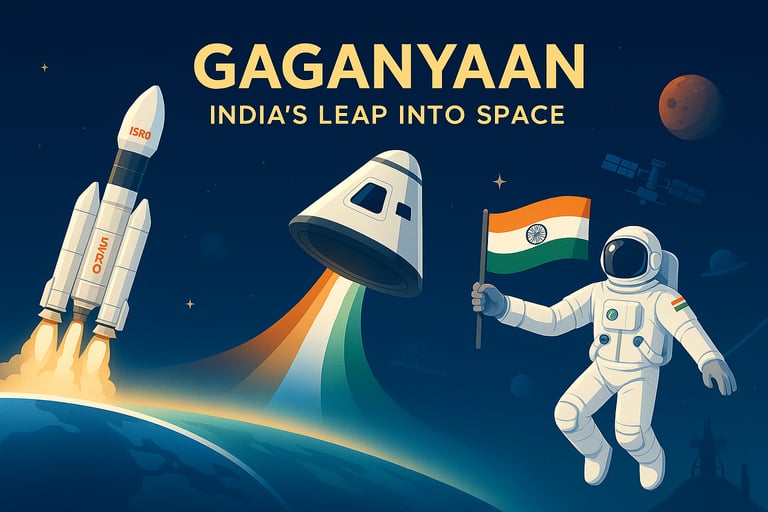

DAILY UPDATES
UPSC CURRENT AFFAIRS
MISSION SUDARSHAN CHAKRA
Theme: Internal Security | Science & Technology | Defence Infrastructure
⚡ Context
India’s Mission Sudarshan Chakra will establish a nationwide multi-layered air defence shield by linking 6,000–7,000 radars, satellites, and directed-energy weapons (DEWs). It represents a landmark move towards an indigenous, technology-driven defence ecosystem.
⚙️ Key Features
🔹 Layered Shield: Tracks aerial threats beyond the horizon through an integrated radar-satellite-AI network.
🔹 Satellites: Enable real-time surveillance of hostile launches and incursions.
🔹 Directed Energy Weapons (DEWs): Laser-based systems to neutralise enemy drones and missiles.
🔹 Integration: Combines radars, DEWs, anti-drone systems, and air-defence guns.
🔹 Institutions Involved: DRDO, ISRO, BEL, armed forces, paramilitary, and defence PSUs under a unified Strategic Coordination Framework.
🧭 UPSC Mains Relevance (GS Paper 3)
Internal Security: Modernisation of armed forces; defence preparedness.
Science & Technology: Application of lasers, AI, and radar technology in national security.
Indigenisation: “Atmanirbhar Bharat” in defence R&D and production.
🎯 UPSC Prelims Relevance
Possible MCQ Angles:
1️⃣ Mission Sudarshan Chakra is related to → Integrated national air defence shield.
2️⃣ Directed Energy Weapons use → High-energy lasers or microwaves to disable targets.
3️⃣ DEWs differ from conventional missiles as they rely on energy beams, not kinetic projectiles.
4️⃣ Agencies involved → DRDO + ISRO + defence PSUs (BEL, HAL).
5️⃣ Objective: Multi-layered protection against aircraft, drones, and ballistic missiles.
💡 Significance
✅ Boosts national security & technological sovereignty.
✅ Detects and neutralises cross-border aerial threats early.
✅ Strengthens India’s deterrence posture and regional stability.
✅ Builds synergy between civil–military research.
⚖️ Challenges
⚠️ High development cost & tech complexity.
⚠️ Cyber-vulnerability of integrated networks.
⚠️ Need for interoperability & unified command.
⚠️ Potential for global weaponisation of space.
🧩 Conclusion
Mission Sudarshan Chakra symbolises India’s transition from reactive defence to proactive deterrence, positioning it among the few nations pursuing energy-based, AI-integrated air-defence systems.
🧠 Topper’s Toolkit (Value-Add)
Keyword: “Layered Air-Defence Architecture.”
Quote: “Technology is the new frontier of sovereignty.”
Diagram Idea: Circular radar-satellite grid showing integration of DEWs, radars & command nodes.
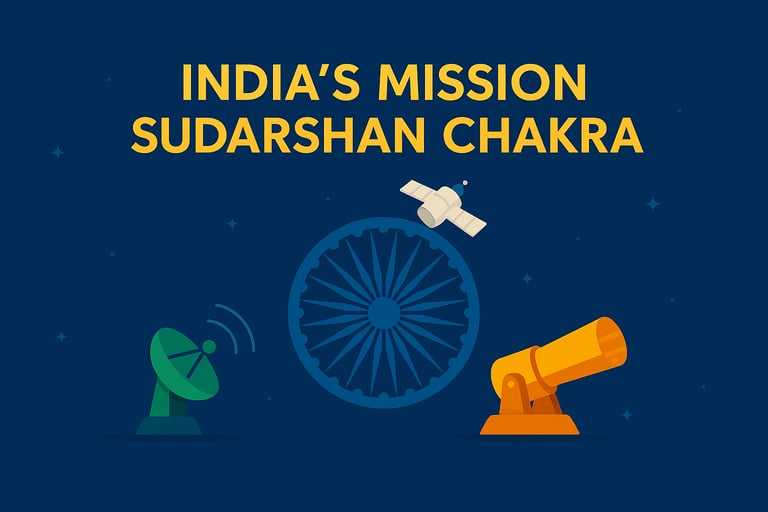

DAILY UPDATES
UPSC CURRENT AFFAIRS


UPSC @100 – From Selection to Transformation
Context:
As UPSC completes 100 years (1925–2025), it stands as India’s longest-surviving symbol of meritocracy, neutrality, and institutional integrity. Its evolution reflects how governance in India has shifted from colonial control to ethical, citizen-centric administration.
Syllabus Mapping:
Prelims:
Indian Polity & Governance → Constitutional Bodies (Articles 315–323)
Current Affairs → Administrative reforms, transparency, recruitment innovations
History → Development of modern civil services
Economy → Public administration, fiscal efficiency, HR reforms
Mains:
GS II: Role & functions of constitutional bodies, reforms in civil services
GS IV: Integrity, impartiality, public service values
Essay: Institutional trust, governance ethics, meritocracy
GS I / GS III (linkages): Administrative evolution, technological governance
